Paul van Yperen's Blog, page 192
July 2, 2020
Renato Salvatori
Thanks to his good looks and impressive physique, Italian actor Renato Salvatori (1933-1988) became a popular star of the European cinema of the 1950s and 1960s. He started as a romantic juvenile actor and reached his apex as Simone in Luchino Visconti’s masterpiece Rocco e i suoi fratelli/Rocco and His Brothers (1960). In the 1960s, Salvatori turned into one of Italy's strongest characters actors of grim, harrowing drama.
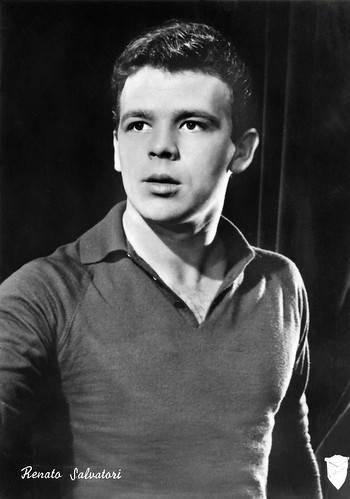
Italian postcard by Bromofoto, Milano, no. 1296. Photo: Titanus.
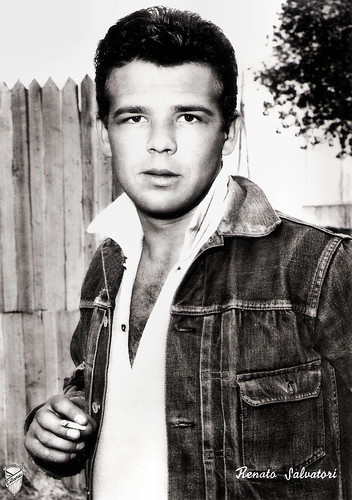
Italian postcard by Bromofoto, Milano, no. 1301. Photo: Titanus.
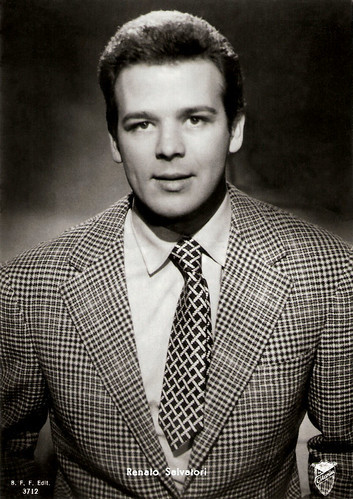
Italian postcard by B.F.F. Edit. (Casa Editr. Ballerini & Fratini, Firenze), no. 3712. Photo: G.B. Poletto / Titanus. Publicity still for Poveri Millionari/Poor Millionaires (Dino Risi, 1959).
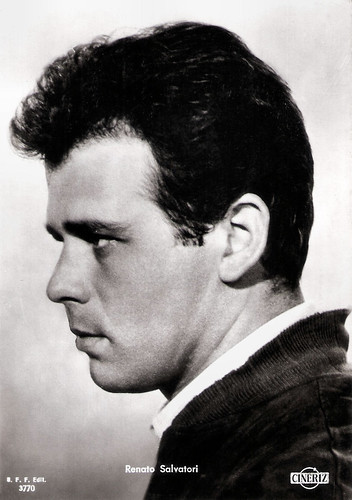
Italian postcard by B.F.F. Edit., no. 3770. Photo: Cineriz.
Handsome and Muscular Baywatch
Renato Salvatori was born Giuseppe Salvatori in Seravezza, near Lucca, in 1933. He was the son of a marble mason.
When he was 18 and bay-watching at a small seaside resort near Forte dei Marmi, Salvatori was discovered by Italian film director Luciano Emmer. The handsome and muscular baywatch landed a part in the romantic drama Le ragazze di Piazza di Spagna/Girls of the Spanish Steps (Luciano Emmer, 1952) starring Lucia Bosé .
Salvatori had his first lead opposite May Britt in the adventure Jolanda la figlia del corsaro nero/Jolanda, the Daughter of the Black Corsair (Mario Soldati, 1954).
Salvatori’s popularity grew enormously thanks to his part of Salvatore in Dino Risi’s trilogy Poveri ma belli/A Girl in Bikini (1956), Belle ma povere/Poor Girl, Pretty Girl (1957) and Poveri milionari/Poor Millionaires (1958), also with Maurizio Arena and Marisa Allasio .
He also knew public success with the two-part comedy La nonna Sabella (Dino Risi, 1957) and La nipote Sabella (Giorgio Bianchi, 1958), next to Peppino de Filippo and Sylva Koscina .
Success was even bigger with the classic crime comedy I soliti ignoti/Big Deal on Madonna Street (Mario Monicelli, 1958) about a gang of clumsy burglars (including Vittorio Gassman , Marcello Mastroianni , Salvatori and others), while Claudia Cardinale played Salvatori’s girlfriend. Its success propelled the sequel Audace colpo dei soliti ignoti/Hold up à la milanaise (Nanni Loy, 1960), again with Gassman and Cardinale.
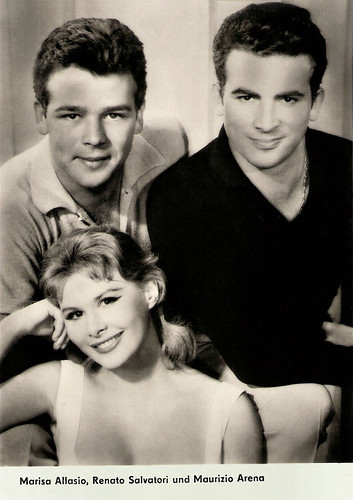
East-German postcard by VEB Progress Film-Vertrieb, Berlin, no. 1356, 1960. Retail price: 0,20 DM. Photo: Progress. Publicity still for Poveri ma belli/Poor But Beautiful (Dino Risi, 1957) with Renato Salvatori, Marisa Allasio and Maurizio Arena .
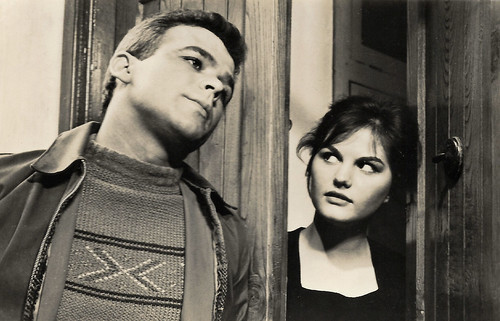
Small Czech collectors card by Pressfoto, Praha (Prague), 1965, no. S 101/3. Photo: Claudia Cardinale and Renato Salvatori in Audace colpo dei soliti ignoti/Fiasco in Milan (Nanni Loy, 1959).
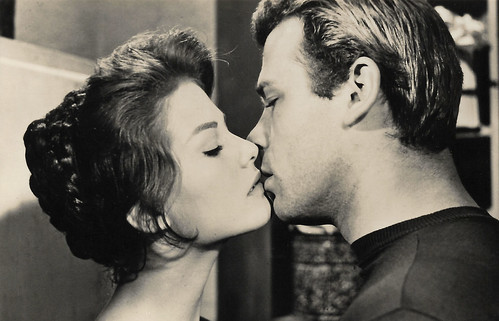
Small Czech collectors card by Pressfoto, Praha (Prague), 1965, no. S 101/4. Photo: Claudia Cardinale and Renato Salvatori in Audace colpo dei soliti ignoti/Fiasco in Milan (Nanni Loy, 1959).
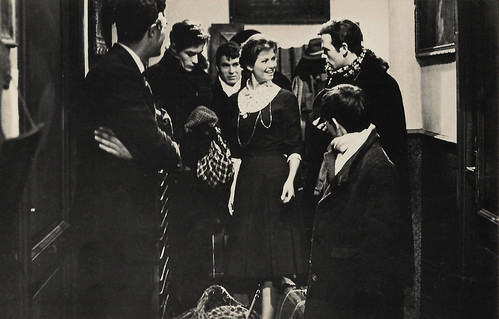
Small Czech collectors card by Pressfoto, Praha (Prague), 1965, no. S 101/5. Photo: Claudia Cardinale , Alain Delon , Max Cartier and Renato Salvatori in Rocco e i suoi fratelli/Rocco and His Brothers (Luchino Visconti, 1960)
Rocco's Eldest Brother
Renato Salvatori was also a good dramatic actor in such films as I magliari/The Magliari (Francesco Rosi, 1959) with Alberto Sordi , La ciociara/Two Women (Vittorio De Sica, 1960) with Sophia Loren , and Era notte a Roma/Blackout in Rome (Roberto Rossellini, 1960) with Giovanna Ralli .
Salvatori’s fundamental part was that of Simone in Rocco e i suoi fratelli/Rocco and his Brothers (Luchino Visconti, 1960). Simone is the eldest brother of a fatherless and poor family from a village in southern Italy who come to Milan seeking a better life. When Simone’s girlfriend, the prostitute Nadia ( Annie Girardot ), prefers his younger brother Rocco ( Alain Delon ) to him, he rapes her in front of his brother.
Reduced to an outcast and ridiculed by his former friends after his boxing career has faltered - while that of Rocco is summiting - Simone takes revenge on Nadia. In real life, Salvatori and Girardot treated each other quite differently. Salvatori met her on the set of the film, they fell in love and married two years after. Salvatori also became close friends with Delon.
Other memorable performances of Salvatori’s film career were in Un giorno da leoni/A Day for Lionhearts (Nanni Loy, 1961), La banda Casaroli/The Casaroli gang (Florestano Vancini, 1962) and I compagni/The Organizer (Mario Monicelli, 1963).
He also played in polemic and counter-cultural films such as Smog (Franco Rossi, 1962), also with Girardot, the Science-Fiction comedy Omicron (Ugo Gregoretti, 1964), and Una bella grinta/The Reckless (Giuliano Montaldo, 1965), films that wanted to give an Italian answer to the French Nouvelle Vague.
Salvatori’s last important roles were in Queimada/Burn (Gillo Pontecorvo, 1969) starring Marlon Brando , and in La prima notte di quiete/Indian Summer (Valerio Zurlini, 1972), again next to Alain Delon .
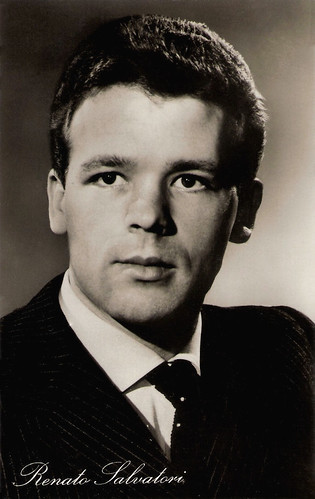
East-German postcard by VEB Progress Film-Vertrieb, Berlin, no. 1019, 1959. Photo: G. B. Poletto.
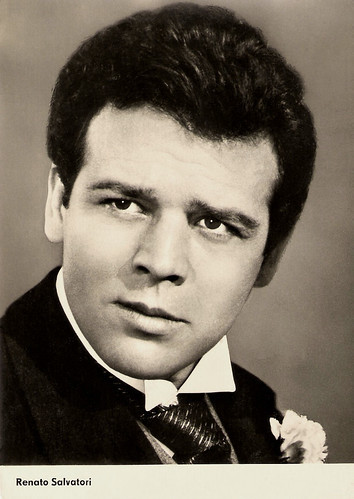
East-German postcard by VEB Progress Film-Vertrieb, Berlin, no. 1595, 1962.
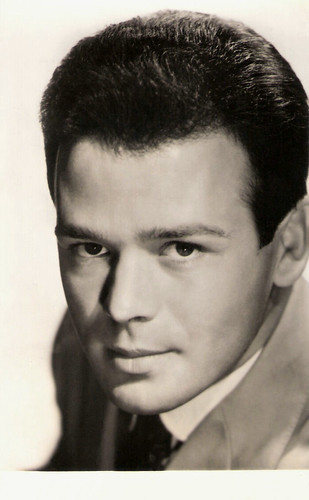
Spanish postcard by Ediciones Raker, Barcelona, no. 286, 1963. Retail price: 3 ptas.
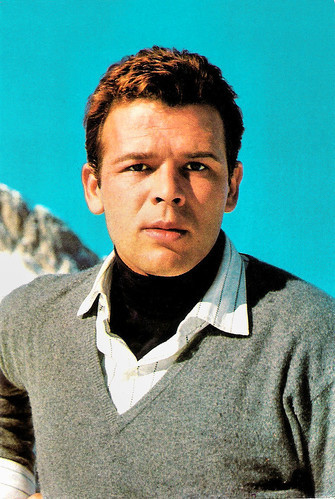
Spanish postcard by Postal Oscarcolor, no. 394.
Drinking Problem
In France, Renato Salvatori also played major parts in the films Le glaive et la balance/The Sword and the Balance (André Cayatte, 1963) with Anthony Perkins and Jean-Claude Brialy , Les grands chemins/Of Flesh and Blood (Christian Marquand, 1963) with Robert Hossein , L’harem/The Harem (Marco Ferreri, 1967) with Carol Baker , and the political thriller Etat de siege/State of Siege (Costa-Gavras, 1972) starring Yves Montand.
He also had small parts in Costa-Gavras’ Z (1969) and Henri Verneuil’s Le casse/The Burglars (1971) starring Jean-Paul Belmondo .
In 1969 he also acted in the Mexican film Los recuerdos del porvenir/Memories of the Future (Artur Ripstein, 1969).
In the early 1970s, Salvatori also played in a few French police films which starred Alain Delon : Les granges brûlées/The Burned Barns (Jean Chapot, 1973) also with Simone Signoret , Flic Story/Cop Story (Jacques Deray, 1975) also with Jean-Louis Trintignant , Le gitan/The Gypsy (José Giovanni, 1975) also with Annie Girardot , and Armaguedon/Armageddon (Alain Jessua, 1977) also with Jean Yanne.
In the same years, Salvatori also played in Italian films about crime & politics such as Il sospetto/The Suspect (Franco Maselli, 1975) with Gian Maria Volonté, Cadaveri eccellenti/Illustrious Corpses (Francesco Rosi, 1976) with Lino Ventura , and Todo modo (Elio Petri, 1976). He also appeared in films on sexual politics such as La dernière femme/The Last Woman (Marco Ferreri, 1976).
After the mid-1970s, however, Salvatori’s parts became much smaller, as in films as Ernesto (Salvero Samperi, 1979) and Bernardo Bertolucci's La luna/Luna (1979) and La tragedia di un uomo ridicolo/The Tragedy of a Ridiculous Man (1981).
Salvatori’s last major parts were in the erotic drama La cicala/The Cricket (Alberto Lattuada, 1980), the comedy Asso/Ace (Castellano & Pipolo aka Franco Castellano, Giuseppe Moccia, 1981) with Adriano Celentano , and the drama Oggetti smarriti (Giuseppe Bertolucci, 1980) with Mariangela Melato.
Salvatori had one daughter with Girardot: Giulia Salvatori, who became an actress as well. In later years the couple separated but kept a good relation. Salvatori had a son Nils from his second marriage with German photo model Danka Schroeder.
In the 1970s Salvatori started to have drinking problems, possibly caused by his delusion over his shrinking career. In 1984 Renato Salvatori entered politics while working for the external relations of the Ministry of Transport, but by now he was physically declining because of liver cirrhosis, which eventually killed him in 1988. He was 55. His grandson, the son of Giulia Salvatori, is also named Renato Salvatori.
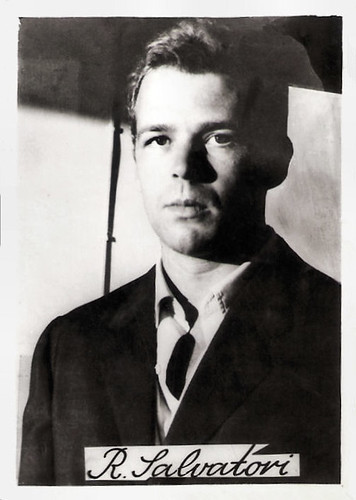
Small Romanian collectors card.
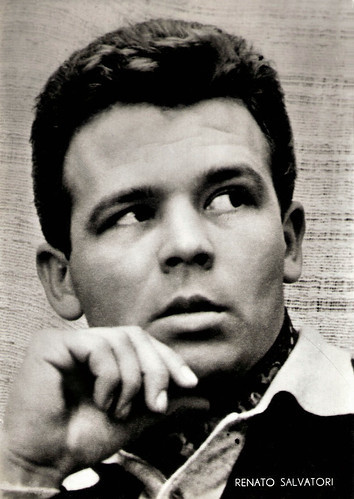
Italian postcard, no. 466.
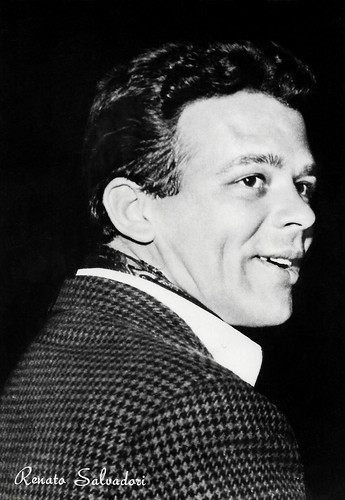
Italian postcard by Rotalfoto, Milano, no. 757.
Short documentary Renato Salvatori Povero ma Bello. Source: Moviexperience (YouTube).
Trailer Rocco e i suoi fratelli (1960). Source: Raccetto (YouTube).
Sources: Hal Erickson (AllMovie), Wikipedia (Italian, French, and English), and .

Italian postcard by Bromofoto, Milano, no. 1296. Photo: Titanus.

Italian postcard by Bromofoto, Milano, no. 1301. Photo: Titanus.

Italian postcard by B.F.F. Edit. (Casa Editr. Ballerini & Fratini, Firenze), no. 3712. Photo: G.B. Poletto / Titanus. Publicity still for Poveri Millionari/Poor Millionaires (Dino Risi, 1959).

Italian postcard by B.F.F. Edit., no. 3770. Photo: Cineriz.
Handsome and Muscular Baywatch
Renato Salvatori was born Giuseppe Salvatori in Seravezza, near Lucca, in 1933. He was the son of a marble mason.
When he was 18 and bay-watching at a small seaside resort near Forte dei Marmi, Salvatori was discovered by Italian film director Luciano Emmer. The handsome and muscular baywatch landed a part in the romantic drama Le ragazze di Piazza di Spagna/Girls of the Spanish Steps (Luciano Emmer, 1952) starring Lucia Bosé .
Salvatori had his first lead opposite May Britt in the adventure Jolanda la figlia del corsaro nero/Jolanda, the Daughter of the Black Corsair (Mario Soldati, 1954).
Salvatori’s popularity grew enormously thanks to his part of Salvatore in Dino Risi’s trilogy Poveri ma belli/A Girl in Bikini (1956), Belle ma povere/Poor Girl, Pretty Girl (1957) and Poveri milionari/Poor Millionaires (1958), also with Maurizio Arena and Marisa Allasio .
He also knew public success with the two-part comedy La nonna Sabella (Dino Risi, 1957) and La nipote Sabella (Giorgio Bianchi, 1958), next to Peppino de Filippo and Sylva Koscina .
Success was even bigger with the classic crime comedy I soliti ignoti/Big Deal on Madonna Street (Mario Monicelli, 1958) about a gang of clumsy burglars (including Vittorio Gassman , Marcello Mastroianni , Salvatori and others), while Claudia Cardinale played Salvatori’s girlfriend. Its success propelled the sequel Audace colpo dei soliti ignoti/Hold up à la milanaise (Nanni Loy, 1960), again with Gassman and Cardinale.

East-German postcard by VEB Progress Film-Vertrieb, Berlin, no. 1356, 1960. Retail price: 0,20 DM. Photo: Progress. Publicity still for Poveri ma belli/Poor But Beautiful (Dino Risi, 1957) with Renato Salvatori, Marisa Allasio and Maurizio Arena .

Small Czech collectors card by Pressfoto, Praha (Prague), 1965, no. S 101/3. Photo: Claudia Cardinale and Renato Salvatori in Audace colpo dei soliti ignoti/Fiasco in Milan (Nanni Loy, 1959).

Small Czech collectors card by Pressfoto, Praha (Prague), 1965, no. S 101/4. Photo: Claudia Cardinale and Renato Salvatori in Audace colpo dei soliti ignoti/Fiasco in Milan (Nanni Loy, 1959).

Small Czech collectors card by Pressfoto, Praha (Prague), 1965, no. S 101/5. Photo: Claudia Cardinale , Alain Delon , Max Cartier and Renato Salvatori in Rocco e i suoi fratelli/Rocco and His Brothers (Luchino Visconti, 1960)
Rocco's Eldest Brother
Renato Salvatori was also a good dramatic actor in such films as I magliari/The Magliari (Francesco Rosi, 1959) with Alberto Sordi , La ciociara/Two Women (Vittorio De Sica, 1960) with Sophia Loren , and Era notte a Roma/Blackout in Rome (Roberto Rossellini, 1960) with Giovanna Ralli .
Salvatori’s fundamental part was that of Simone in Rocco e i suoi fratelli/Rocco and his Brothers (Luchino Visconti, 1960). Simone is the eldest brother of a fatherless and poor family from a village in southern Italy who come to Milan seeking a better life. When Simone’s girlfriend, the prostitute Nadia ( Annie Girardot ), prefers his younger brother Rocco ( Alain Delon ) to him, he rapes her in front of his brother.
Reduced to an outcast and ridiculed by his former friends after his boxing career has faltered - while that of Rocco is summiting - Simone takes revenge on Nadia. In real life, Salvatori and Girardot treated each other quite differently. Salvatori met her on the set of the film, they fell in love and married two years after. Salvatori also became close friends with Delon.
Other memorable performances of Salvatori’s film career were in Un giorno da leoni/A Day for Lionhearts (Nanni Loy, 1961), La banda Casaroli/The Casaroli gang (Florestano Vancini, 1962) and I compagni/The Organizer (Mario Monicelli, 1963).
He also played in polemic and counter-cultural films such as Smog (Franco Rossi, 1962), also with Girardot, the Science-Fiction comedy Omicron (Ugo Gregoretti, 1964), and Una bella grinta/The Reckless (Giuliano Montaldo, 1965), films that wanted to give an Italian answer to the French Nouvelle Vague.
Salvatori’s last important roles were in Queimada/Burn (Gillo Pontecorvo, 1969) starring Marlon Brando , and in La prima notte di quiete/Indian Summer (Valerio Zurlini, 1972), again next to Alain Delon .

East-German postcard by VEB Progress Film-Vertrieb, Berlin, no. 1019, 1959. Photo: G. B. Poletto.

East-German postcard by VEB Progress Film-Vertrieb, Berlin, no. 1595, 1962.

Spanish postcard by Ediciones Raker, Barcelona, no. 286, 1963. Retail price: 3 ptas.

Spanish postcard by Postal Oscarcolor, no. 394.
Drinking Problem
In France, Renato Salvatori also played major parts in the films Le glaive et la balance/The Sword and the Balance (André Cayatte, 1963) with Anthony Perkins and Jean-Claude Brialy , Les grands chemins/Of Flesh and Blood (Christian Marquand, 1963) with Robert Hossein , L’harem/The Harem (Marco Ferreri, 1967) with Carol Baker , and the political thriller Etat de siege/State of Siege (Costa-Gavras, 1972) starring Yves Montand.
He also had small parts in Costa-Gavras’ Z (1969) and Henri Verneuil’s Le casse/The Burglars (1971) starring Jean-Paul Belmondo .
In 1969 he also acted in the Mexican film Los recuerdos del porvenir/Memories of the Future (Artur Ripstein, 1969).
In the early 1970s, Salvatori also played in a few French police films which starred Alain Delon : Les granges brûlées/The Burned Barns (Jean Chapot, 1973) also with Simone Signoret , Flic Story/Cop Story (Jacques Deray, 1975) also with Jean-Louis Trintignant , Le gitan/The Gypsy (José Giovanni, 1975) also with Annie Girardot , and Armaguedon/Armageddon (Alain Jessua, 1977) also with Jean Yanne.
In the same years, Salvatori also played in Italian films about crime & politics such as Il sospetto/The Suspect (Franco Maselli, 1975) with Gian Maria Volonté, Cadaveri eccellenti/Illustrious Corpses (Francesco Rosi, 1976) with Lino Ventura , and Todo modo (Elio Petri, 1976). He also appeared in films on sexual politics such as La dernière femme/The Last Woman (Marco Ferreri, 1976).
After the mid-1970s, however, Salvatori’s parts became much smaller, as in films as Ernesto (Salvero Samperi, 1979) and Bernardo Bertolucci's La luna/Luna (1979) and La tragedia di un uomo ridicolo/The Tragedy of a Ridiculous Man (1981).
Salvatori’s last major parts were in the erotic drama La cicala/The Cricket (Alberto Lattuada, 1980), the comedy Asso/Ace (Castellano & Pipolo aka Franco Castellano, Giuseppe Moccia, 1981) with Adriano Celentano , and the drama Oggetti smarriti (Giuseppe Bertolucci, 1980) with Mariangela Melato.
Salvatori had one daughter with Girardot: Giulia Salvatori, who became an actress as well. In later years the couple separated but kept a good relation. Salvatori had a son Nils from his second marriage with German photo model Danka Schroeder.
In the 1970s Salvatori started to have drinking problems, possibly caused by his delusion over his shrinking career. In 1984 Renato Salvatori entered politics while working for the external relations of the Ministry of Transport, but by now he was physically declining because of liver cirrhosis, which eventually killed him in 1988. He was 55. His grandson, the son of Giulia Salvatori, is also named Renato Salvatori.

Small Romanian collectors card.

Italian postcard, no. 466.

Italian postcard by Rotalfoto, Milano, no. 757.
Short documentary Renato Salvatori Povero ma Bello. Source: Moviexperience (YouTube).
Trailer Rocco e i suoi fratelli (1960). Source: Raccetto (YouTube).
Sources: Hal Erickson (AllMovie), Wikipedia (Italian, French, and English), and .
Published on July 02, 2020 22:00
July 1, 2020
Photo by Bernard of Hollywood
Bruno Bernard (1912–1987) fled from Nazi Germany to the USA in the 1930s. As Bernard of Hollywood, he became one of the most popular glamour photographers of Tinseltown. In 1961 he returned to Germany, where he photographed many European starlets and also worked as a set photographer.
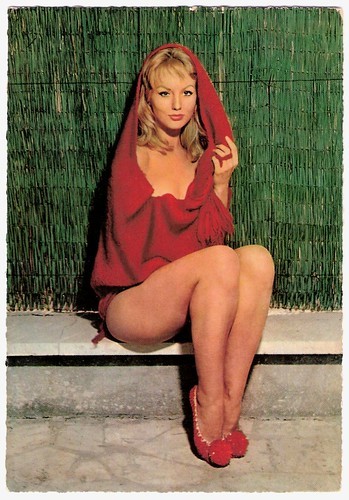
Mylène Demongeot . German postcard by Krüger, no. 902/66. Photo: Bernard of Hollywood.
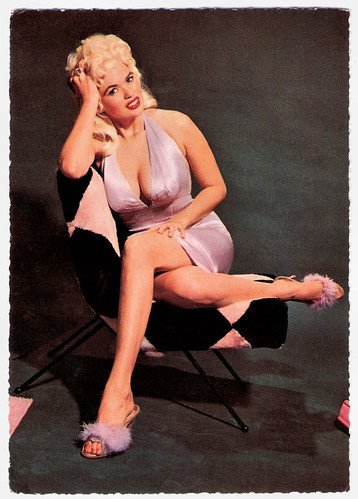
Jayne Mansfield . German postcard by Krüger, no. 902/67. Sent by mail in France in 1966. Photo: Bernard of Hollywood.
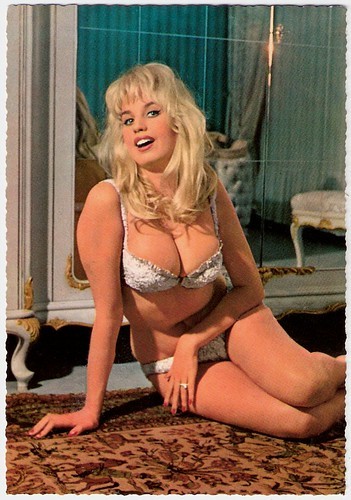
Barbara Valentin . German postcard by Krüger, no. 902/192. Photo: Bernard of Hollywood.
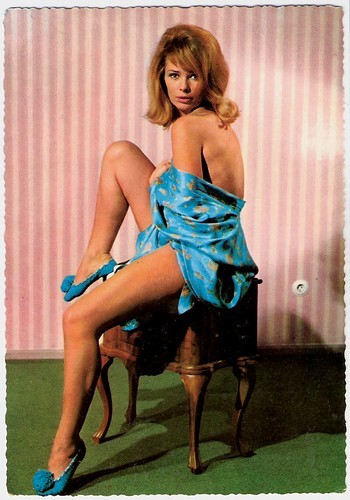
Vivi Bach . German postcard by Krüger, no. 902/277. Photo: Bernard of Hollywood.
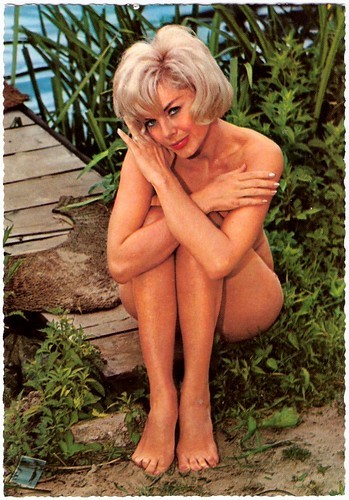
Sophie Hardy . German postcard by Kruger, no. 902/291. Photo: Bernard of Hollywood.
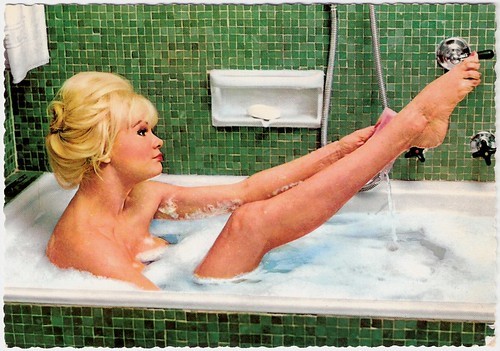
Margaret Rose Keil . German postcard by Krüger, no. 900/288. Photo: Bernard of Hollywood.
The Vargas of Photography
Bruno Bernard was born Bruno Bernard Sommerfeld (or Sommer) in Berlin, Germany in 1912. His Jewish parents were poor. He and his four siblings were on welfare by the time he was 8 years old and were placed in orphanages.
At age 11, his parents gave him his first camera, a Rolleiflex, in 1923. It led to a lifelong interest in photography. As a young man, he worked as a photographer and reporter and earned a Ph.D. in criminal psychology at the Kiel University. He was in the two percent of Jews to gain a doctorate in 1934.
His activism in a Jewish youth organization landed him on the Gestapo’s blacklist and caused him to emigrate to the United States in 1937. He claimed to the German authorities that he was leaving the country to continue his graduate studies.
He was 26 and attended the University of California, Berkeley, where he planned to continue his education but soon became interested in the arts. He settled in Los Angeles and set up a darkroom in the basement of his apartment.
In 1940, he became a directorial apprentice at the Reinhardt School of the Theatre, opened by Max Reinhardt on Sunset Boulevard in Los Angeles. Unable to get a job as a director, however, Bruno returned to his interest in photography. He started out taking photos of the wives and children of the directors and producers he had come to know through his apprenticeship.
As he began making money, he opened a proper studio at Sunset Boulevard in 1940. Agent Paul Kohner, who helped many Europeans flee after the rise of Adolph Hitler and re-establish themselves in Hollywood, took notice of Bernard’s work. Kohner sent him clients, and thus brought him to the attention of the film industry. 'Bernard of Hollywood' was to reign at this studio for 25 years. It became a landmark of Hollywood.
Bruno developed a unique portrait style that he called the "posed candid"; a style that evolved into what is now known as 'pin-up' photography. Bernard preferred a moderate use of artificial light. He preferred natural light like the sun at the beach and sometimes added a flash to his light concept.
Soon he was called 'The King of Glamour Photography' and 'The Vargas of Pinup Photography', after his mentor, pin-up painter Alberto Vargas. Over the next two years, Bernard opened studios at Laguna Beach, at Las Vegas’s Riviera Hotel, and at the Palm Springs Racquet Club, then the favourite retreat for Hollywood’s top stars.
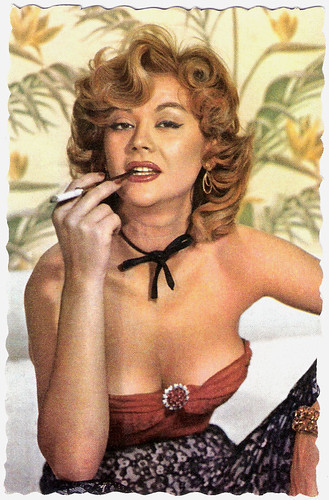
Monique Van Vooren . French postcard by De Marchi Frères, Marseille. Photo: Bernard of Hollywood.
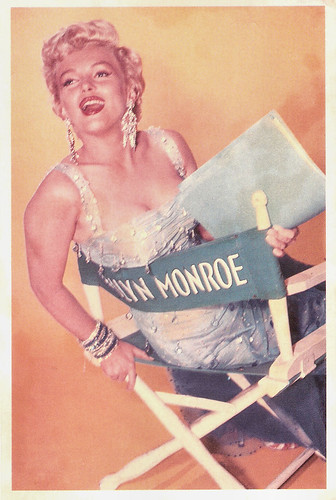
Marilyn Monroe . American postcard by The American Postcard Company, no. 282, 1981. Photo: Bruno Bernard (Bernard of Hollywood).
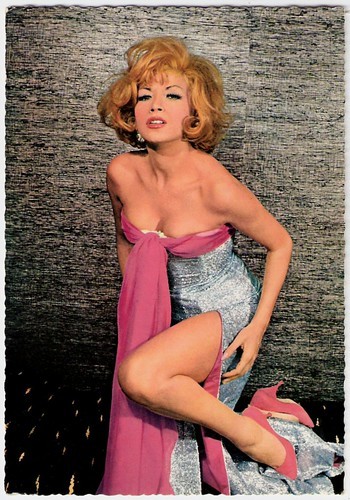
Rita Cadillac . German postcard by Krüger, no. 902/297. Photo: Bernard of Hollywood.
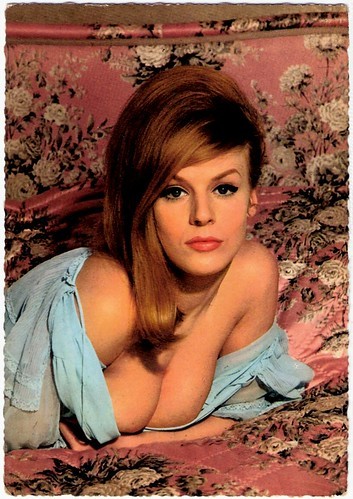
Heidi Brühl . German postcard by Krüger, no. 902/321. Postcard: Bernard of Hollywood.
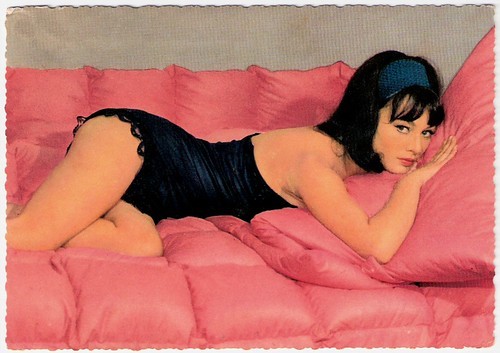
Helga Sommerfeld . German postcard by Krüger, no. 902/324. Photo: Bernard of Hollywood.
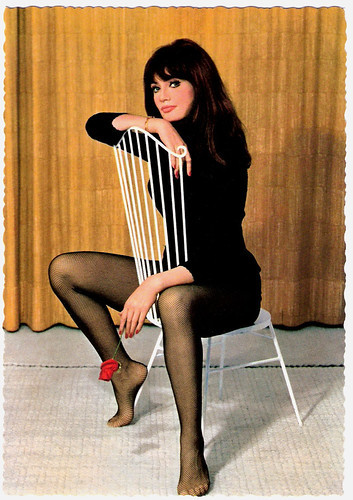
Marisa Mell . German postcard by Krüger, no. 902/349. Photo: Bernard of Hollywood.
Strippers, Showgirls, Starlets
Bernard of Hollywood photographed most of the big stars of Hollywood of the 1940s and 1950s: Marlene Dietrich , Clark Gable, Bette Davis , John Wayne , and of course Marilyn Monroe .
Bruno Bernard is credited with first photographing Marilyn Monroe at his studio in 1946. She was still known then as Norma Jean Dougherty. In 1947, Bernard introduced Monroe to agent Johnny Hyde, vice president of the William Morris Agency.
Hyde revamped Norma Jean completely from the loveable, carefree All-American Girl to the breathtakingly beautiful Hollywood blonde. A cosmetic surgeon in the Springs restyled her nose and straightened the facial tissues under her skin. Hude got her seven-year contract with 20th Century-Fox. There, Bernard took the well-known photographs of Monroe in the red dress she wore for Niagara (Henry Hathaway, 1953).
One of Bernard's most famous photos is 'Marilyn in White', shot in New York in September 1954. Monroe is holding her white pleated skirt down from a blast of steam from a New York sidewalk grating in The Seven Year Itch (Billy Wilder, 1955). This photograph was selected as the 'Symbol of the Century' by the Museum of Modern Art in New York.
Bernard's artistic muse, however, was the late, legendary striptease artist Lili St. Cyr, a spectacularly stunning beauty with wit, elegance, and a sense of humor. Bernard of Hollywood's pin-up work ranges from strippers, Vegas showgirls; unknown, poignantly unnamed models; to all the starlets of the 1950s and 1960s. Bernard's daughter Susan Bernard has made the case that the pinup style popularised by Bernard and Alberto Vargas was "celebrating and empowering women rather than exploiting them".
Kevin Thomas in the Los Angeles Times : "No less than Gen. Dwight D. Eisenhower praised Bernard’s pinups, and when--incredibly--Bernard had to fight an obscenity charge all the way to the U.S. Supreme Court in the early 1950s, he submitted in his defense a letter from the Secretary of Defense thanking him for the morale-building effect of his pinups."
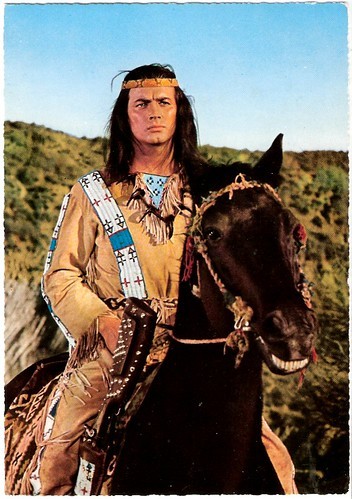
German postcard by Kruger. Photo: Bruno Bernard/CCC Produktion. Pierre Brice as Winnetou Old Shatterhand (Hugo Fregonese, 1964).
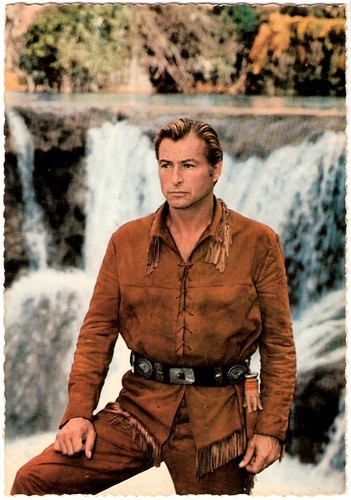
German postcard by Kruger. Photo: Bernard of Hollywood (Bruno Bernard) / CCC-Produktion. Lex Barker as Old Shatterhand in Old Shatterhand (Hugo Fregonese, 1964).
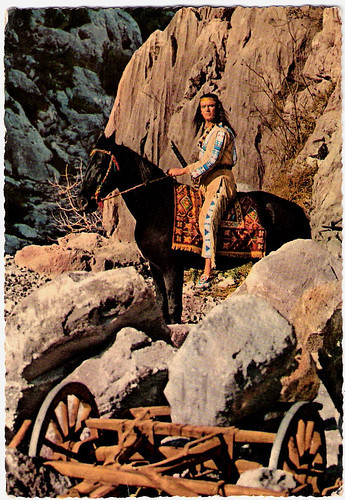
German postcard by Krüger. Photo: Bernard of Hollywood / CCC Produktion. Pierre Brice in Old Shattterhand (1964). Sent by mail in Luxemburg in 1966.
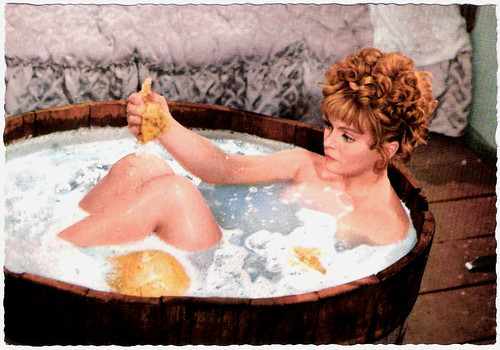
German postcard by Krüger, no. 902/302. Photo: Bernard of Hollywood / CCC-Zugsmith Co-produktion. Letícia Román in Fanny Hill (Russ Meyer, 1964).
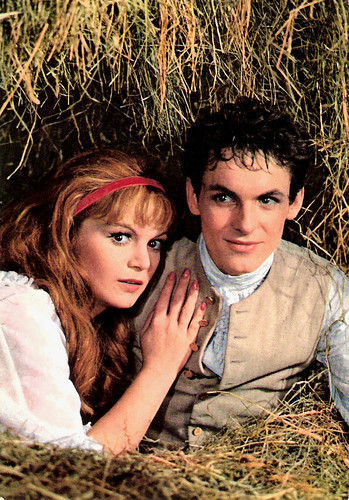
German postcard by Krüger, no. 902/303. Photo: Bernard of Hollywood / CCC-Zugsmith Co-produktion. Letícia Román and Ulli Lommel in Fanny Hill (Russ Meyer, 1964).
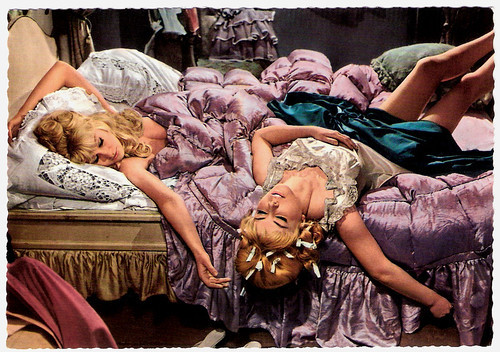
German postcard by Krüger, no. 902/358. Photo: Bernard of Hollywood / CCC-Zugsmith Co-produktion. Renate Hütte and Britt Lindberg in Fanny Hill (1964).
Legends
In 1961 Bruno Bernard sold his studios and started a new career as a foreign correspondent and photojournalist in Europe. For the German magazine Der Spiegel, he photographed the Eichmann Trial in Israel.
The German postcard publisher Krüger commissioned him to photograph European starlets during the early 1960s. Among them were German film stars as Heidi Brühl , Marisa Mell , and voluptuous Barbara Valentin , a.k.a. the German Jayne Mansfield .
Bernard of Hollywood also photographed the original, when Jayne Mansfield was working in Europe after her Hollywood career had dried up.
Bruno Bernard also worked as a still photographer for films including the erotic film Fanny Hill (Russ Meyer, 1964) and the Eurowestern Old Shatterhand (Hugo Fregonese, 1964).
Bernard returned to the USA, and in the 1980s he was living in Palm Springs and writing his memoirs. In 1984, Bernard became the first still photographer to be honored by the Academy of Motion Picture Arts and Sciences in Los Angeles with a 50-year retrospective of his work. The exhibition showed 130 of his portraits and other pictures.
The celebration was to mark Bernard’s 50th year as a photographer. His 'Marilyn in White' was also chosen by the International Center of Photography as one of the '20 Unforgettable Photographs'.
In 1987, Bruno Bernard died of cancer in Los Angeles at the age of 75. He had just compiled the book 'Requiem for Marilyn'. His daughter Sue Bernard (1948–2019) was the founder and president of Bernard of Hollywood Publishing and wrote several books, among them 'Marilyn: Intimate Exposures' and 'Bernard of Hollywood’s Ultimate Pin-Up Book'. She preserved exhibited and published her father's legacy, introducing his photos to a new generation.
Kevin Thomas in the Los Angeles Times : "There is in Bernard’s pinups an exuberant sexuality that is both innocent and mischievous, seductive yet sweet. Surely, it was the rapport that Bernard had with movie stars and models alike that yielded these wonderful combinations".
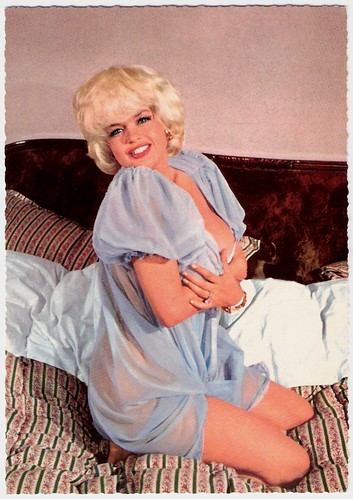
Jayne Mansfield . German postcard by Krüger, no. 900/78. Photo: Bernard of Hollywood.
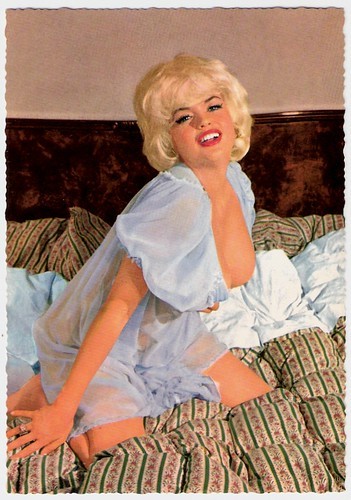
Jayne Mansfield . German postcard by Krüger, no. 900/78. Photo: Bernard of Hollywood.
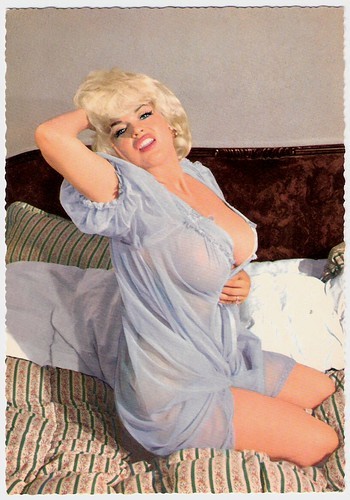
Jayne Mansfield . German postcard by Krüger, no. 900/78. Photo: Bernard of Hollywood.
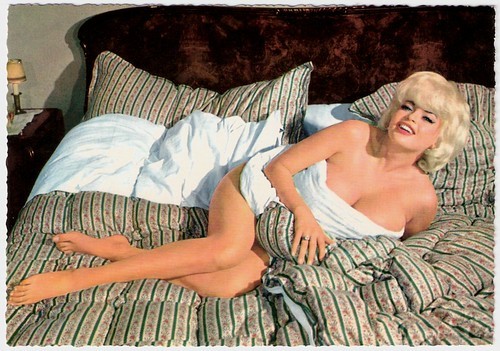
Jayne Mansfield . German postcard by Krüger, no. 900/78. Photo: Bernard of Hollywood.
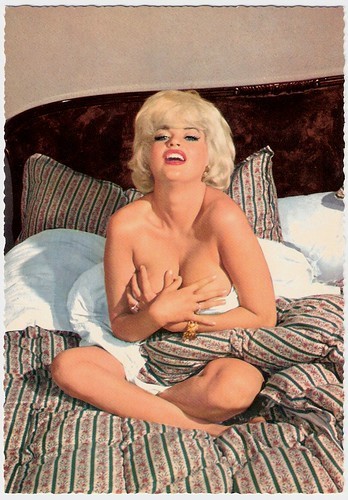
Jayne Mansfield . German postcard by Krüger, no. 900/78. Photo: Bernard of Hollywood.
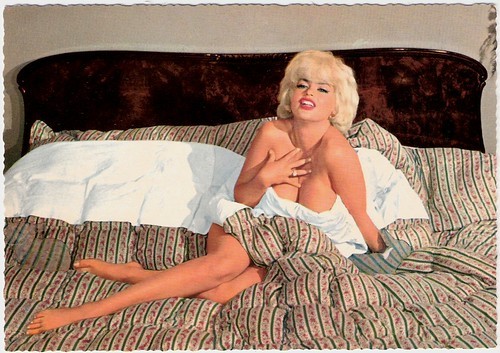
Jayne Mansfield . German postcard by Krüger, no. 900/78. Photo: Bernard of Hollywood.
Sources: Kevin Thomas (Los Angeles Times), Susan Bernard (Marilyn Intimate Exposures), Adrienne Miller (Esquire - offline), Bernard of Hollywood.com, Find A Grave, Wikipedia, and .

Mylène Demongeot . German postcard by Krüger, no. 902/66. Photo: Bernard of Hollywood.

Jayne Mansfield . German postcard by Krüger, no. 902/67. Sent by mail in France in 1966. Photo: Bernard of Hollywood.

Barbara Valentin . German postcard by Krüger, no. 902/192. Photo: Bernard of Hollywood.

Vivi Bach . German postcard by Krüger, no. 902/277. Photo: Bernard of Hollywood.

Sophie Hardy . German postcard by Kruger, no. 902/291. Photo: Bernard of Hollywood.

Margaret Rose Keil . German postcard by Krüger, no. 900/288. Photo: Bernard of Hollywood.
The Vargas of Photography
Bruno Bernard was born Bruno Bernard Sommerfeld (or Sommer) in Berlin, Germany in 1912. His Jewish parents were poor. He and his four siblings were on welfare by the time he was 8 years old and were placed in orphanages.
At age 11, his parents gave him his first camera, a Rolleiflex, in 1923. It led to a lifelong interest in photography. As a young man, he worked as a photographer and reporter and earned a Ph.D. in criminal psychology at the Kiel University. He was in the two percent of Jews to gain a doctorate in 1934.
His activism in a Jewish youth organization landed him on the Gestapo’s blacklist and caused him to emigrate to the United States in 1937. He claimed to the German authorities that he was leaving the country to continue his graduate studies.
He was 26 and attended the University of California, Berkeley, where he planned to continue his education but soon became interested in the arts. He settled in Los Angeles and set up a darkroom in the basement of his apartment.
In 1940, he became a directorial apprentice at the Reinhardt School of the Theatre, opened by Max Reinhardt on Sunset Boulevard in Los Angeles. Unable to get a job as a director, however, Bruno returned to his interest in photography. He started out taking photos of the wives and children of the directors and producers he had come to know through his apprenticeship.
As he began making money, he opened a proper studio at Sunset Boulevard in 1940. Agent Paul Kohner, who helped many Europeans flee after the rise of Adolph Hitler and re-establish themselves in Hollywood, took notice of Bernard’s work. Kohner sent him clients, and thus brought him to the attention of the film industry. 'Bernard of Hollywood' was to reign at this studio for 25 years. It became a landmark of Hollywood.
Bruno developed a unique portrait style that he called the "posed candid"; a style that evolved into what is now known as 'pin-up' photography. Bernard preferred a moderate use of artificial light. He preferred natural light like the sun at the beach and sometimes added a flash to his light concept.
Soon he was called 'The King of Glamour Photography' and 'The Vargas of Pinup Photography', after his mentor, pin-up painter Alberto Vargas. Over the next two years, Bernard opened studios at Laguna Beach, at Las Vegas’s Riviera Hotel, and at the Palm Springs Racquet Club, then the favourite retreat for Hollywood’s top stars.

Monique Van Vooren . French postcard by De Marchi Frères, Marseille. Photo: Bernard of Hollywood.

Marilyn Monroe . American postcard by The American Postcard Company, no. 282, 1981. Photo: Bruno Bernard (Bernard of Hollywood).

Rita Cadillac . German postcard by Krüger, no. 902/297. Photo: Bernard of Hollywood.

Heidi Brühl . German postcard by Krüger, no. 902/321. Postcard: Bernard of Hollywood.

Helga Sommerfeld . German postcard by Krüger, no. 902/324. Photo: Bernard of Hollywood.

Marisa Mell . German postcard by Krüger, no. 902/349. Photo: Bernard of Hollywood.
Strippers, Showgirls, Starlets
Bernard of Hollywood photographed most of the big stars of Hollywood of the 1940s and 1950s: Marlene Dietrich , Clark Gable, Bette Davis , John Wayne , and of course Marilyn Monroe .
Bruno Bernard is credited with first photographing Marilyn Monroe at his studio in 1946. She was still known then as Norma Jean Dougherty. In 1947, Bernard introduced Monroe to agent Johnny Hyde, vice president of the William Morris Agency.
Hyde revamped Norma Jean completely from the loveable, carefree All-American Girl to the breathtakingly beautiful Hollywood blonde. A cosmetic surgeon in the Springs restyled her nose and straightened the facial tissues under her skin. Hude got her seven-year contract with 20th Century-Fox. There, Bernard took the well-known photographs of Monroe in the red dress she wore for Niagara (Henry Hathaway, 1953).
One of Bernard's most famous photos is 'Marilyn in White', shot in New York in September 1954. Monroe is holding her white pleated skirt down from a blast of steam from a New York sidewalk grating in The Seven Year Itch (Billy Wilder, 1955). This photograph was selected as the 'Symbol of the Century' by the Museum of Modern Art in New York.
Bernard's artistic muse, however, was the late, legendary striptease artist Lili St. Cyr, a spectacularly stunning beauty with wit, elegance, and a sense of humor. Bernard of Hollywood's pin-up work ranges from strippers, Vegas showgirls; unknown, poignantly unnamed models; to all the starlets of the 1950s and 1960s. Bernard's daughter Susan Bernard has made the case that the pinup style popularised by Bernard and Alberto Vargas was "celebrating and empowering women rather than exploiting them".
Kevin Thomas in the Los Angeles Times : "No less than Gen. Dwight D. Eisenhower praised Bernard’s pinups, and when--incredibly--Bernard had to fight an obscenity charge all the way to the U.S. Supreme Court in the early 1950s, he submitted in his defense a letter from the Secretary of Defense thanking him for the morale-building effect of his pinups."

German postcard by Kruger. Photo: Bruno Bernard/CCC Produktion. Pierre Brice as Winnetou Old Shatterhand (Hugo Fregonese, 1964).

German postcard by Kruger. Photo: Bernard of Hollywood (Bruno Bernard) / CCC-Produktion. Lex Barker as Old Shatterhand in Old Shatterhand (Hugo Fregonese, 1964).

German postcard by Krüger. Photo: Bernard of Hollywood / CCC Produktion. Pierre Brice in Old Shattterhand (1964). Sent by mail in Luxemburg in 1966.

German postcard by Krüger, no. 902/302. Photo: Bernard of Hollywood / CCC-Zugsmith Co-produktion. Letícia Román in Fanny Hill (Russ Meyer, 1964).

German postcard by Krüger, no. 902/303. Photo: Bernard of Hollywood / CCC-Zugsmith Co-produktion. Letícia Román and Ulli Lommel in Fanny Hill (Russ Meyer, 1964).

German postcard by Krüger, no. 902/358. Photo: Bernard of Hollywood / CCC-Zugsmith Co-produktion. Renate Hütte and Britt Lindberg in Fanny Hill (1964).
Legends
In 1961 Bruno Bernard sold his studios and started a new career as a foreign correspondent and photojournalist in Europe. For the German magazine Der Spiegel, he photographed the Eichmann Trial in Israel.
The German postcard publisher Krüger commissioned him to photograph European starlets during the early 1960s. Among them were German film stars as Heidi Brühl , Marisa Mell , and voluptuous Barbara Valentin , a.k.a. the German Jayne Mansfield .
Bernard of Hollywood also photographed the original, when Jayne Mansfield was working in Europe after her Hollywood career had dried up.
Bruno Bernard also worked as a still photographer for films including the erotic film Fanny Hill (Russ Meyer, 1964) and the Eurowestern Old Shatterhand (Hugo Fregonese, 1964).
Bernard returned to the USA, and in the 1980s he was living in Palm Springs and writing his memoirs. In 1984, Bernard became the first still photographer to be honored by the Academy of Motion Picture Arts and Sciences in Los Angeles with a 50-year retrospective of his work. The exhibition showed 130 of his portraits and other pictures.
The celebration was to mark Bernard’s 50th year as a photographer. His 'Marilyn in White' was also chosen by the International Center of Photography as one of the '20 Unforgettable Photographs'.
In 1987, Bruno Bernard died of cancer in Los Angeles at the age of 75. He had just compiled the book 'Requiem for Marilyn'. His daughter Sue Bernard (1948–2019) was the founder and president of Bernard of Hollywood Publishing and wrote several books, among them 'Marilyn: Intimate Exposures' and 'Bernard of Hollywood’s Ultimate Pin-Up Book'. She preserved exhibited and published her father's legacy, introducing his photos to a new generation.
Kevin Thomas in the Los Angeles Times : "There is in Bernard’s pinups an exuberant sexuality that is both innocent and mischievous, seductive yet sweet. Surely, it was the rapport that Bernard had with movie stars and models alike that yielded these wonderful combinations".

Jayne Mansfield . German postcard by Krüger, no. 900/78. Photo: Bernard of Hollywood.

Jayne Mansfield . German postcard by Krüger, no. 900/78. Photo: Bernard of Hollywood.

Jayne Mansfield . German postcard by Krüger, no. 900/78. Photo: Bernard of Hollywood.

Jayne Mansfield . German postcard by Krüger, no. 900/78. Photo: Bernard of Hollywood.

Jayne Mansfield . German postcard by Krüger, no. 900/78. Photo: Bernard of Hollywood.

Jayne Mansfield . German postcard by Krüger, no. 900/78. Photo: Bernard of Hollywood.
Sources: Kevin Thomas (Los Angeles Times), Susan Bernard (Marilyn Intimate Exposures), Adrienne Miller (Esquire - offline), Bernard of Hollywood.com, Find A Grave, Wikipedia, and .
Published on July 01, 2020 22:00
June 30, 2020
Dina Gralla
Polish-born, German actress Dina Gralla (1905-1994) started as a naive, sexy dancer in German revues. The amiable brunette then was the leading lady in more than 35 silent and early sound films of the Weimar cinema. Tuberculosis ended her career in 1934.
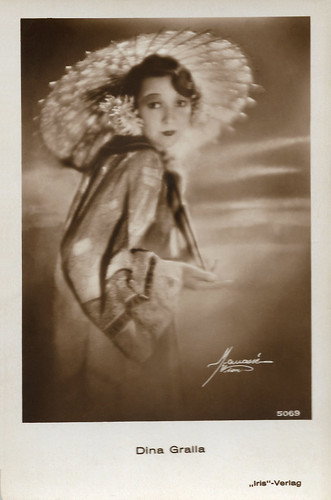
Austrian postcard by Iris-Verlag, no. 5069. Photo: Manassé, Wien.
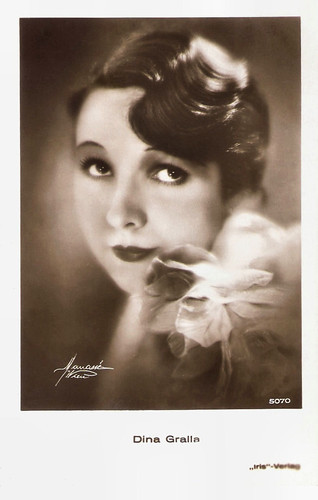
Austrian postcard by Iris-Verlag, no. 5070. Photo: Manassé, Wien.
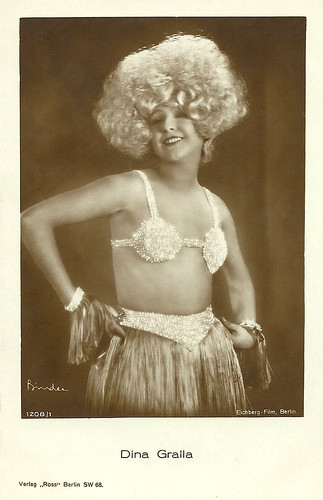
German postcard by Ross Verlag, no. 1208/1, 1927-1928. Photo: Alex Binder / Eichberg-Film, Berlin. Collection: Didier Hanson.
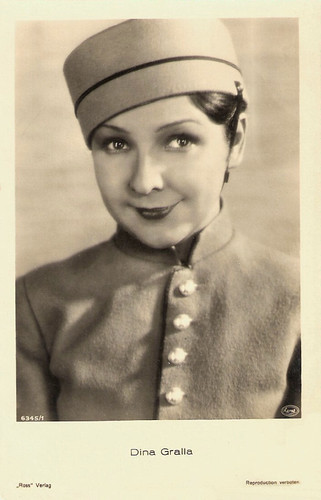
German postcard by Ross Verlag, no. 6345/1, 1931-1932. Photo: Heros.
Naive and Sexy
Dina Gralla was born as Dina Sventen in Warsaw, Poland (then part of the Russian Empire) in 1905.
She had a dance training in 1919 and performed as a ballet dancer at the revue of the Wintergarten theatre in Berlin. After some private acting lessons from Walter Steinbeck, she appeared in the film drama Leidenschaft/Passion (Richard Eichberg, 1925).
From then on she was seen regularly in German silent films in roles as a naive, sexy girl, often appearing with Lilian Harvey , like in Die Kleine vom Bummel/The Girl on the Road (Richard Eichberg, 1925) and Prinzessin Trulala/Princess Trulala (Erich Schönfelder, Richard Eichberg, 1926).
Repeatedly she played dancers, most famously in the leading part of the hit revue film Das Girl von der Revue/The Girl from the Revue (Richard Eichberg, 1928) with Werner Fuetterer . She also worked as a stage actress, for example at the Theater in der Behrenstraße.
Other films included Die Tolle Komtess/The Crazy Countess (Richard Löwenbein, 1928) with Max Ehrlich and Werner Fuetterer , Ein Kleiner Vorschuß auf die Seligkeit/A Small Down Payment on Bliss (Jaap Speyer, 1929) opposite Paul Hörbiger , Wer wird denn weinen, wenn man auseinandergeht?/No Use Crying If Your Sweetheart Goes Away (Richard Eichberg, 1929) with Paul Morgan .
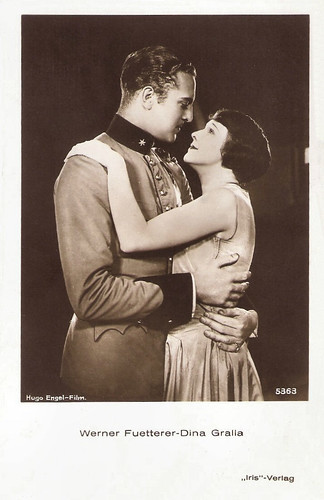
Austrian postcard by Iris-Verlag, no. 5363. Photo: Hugo Engel-Film. Publicity still for Das Girl von der Revue (Richard Eichberg, 1928) with Werner Fuetterer .
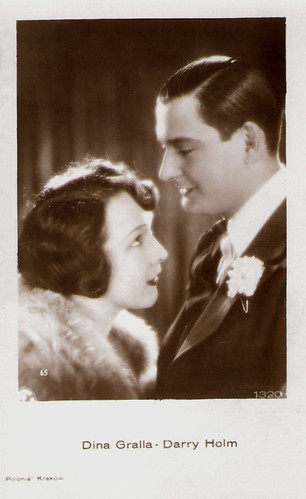
Polish postcard by Polonia, Krakow, no. 1320. Dina Gralla and Harry Halm in Prinzessin Trulala/Princess Trulala (Erich Schönfelder, Richard Eichberg, 1926).
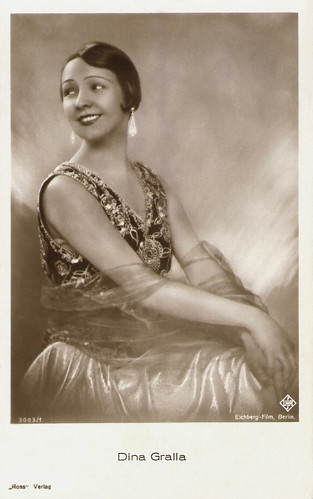
German postcard by Ross Verlag, no. 3003/1, 1928-1929. Photo: Eichberg-Film, Berlin / Ufa. Dina Gralla in Du sollst nicht stehlen/Thou Shalt Not Steal (Victor Janson, 1928).
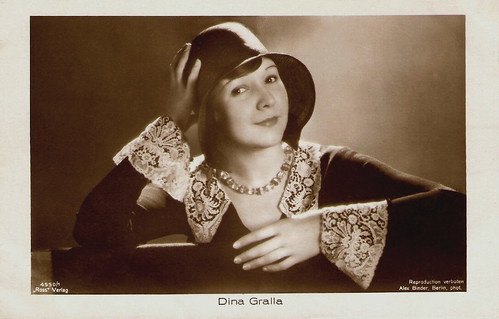
German postcard by Ross Verlag, no. 4550/1, 1929-1930. Photo: Alex Binder, Berlin.
Tuberculosis
Despite her Polish accent, Dina Gralla could continue her film career into the sound era.
She appeared in such comedies as Keine Feier ohne Meyer/No Celebration Without Meyer (Carl Boese, 1931) with Sig Arno , Der Liebesarzt/Doctor Love (Erich Schönfelder, 1931) opposite Harry Liedtke , and Der Liebesexpreß/Eight Days of Happiness (Robert Wiene, 1931) with Georg Alexander.
Her later films included Schwebende Jungfrau/The Soaring Maiden (Carl Boese, 1931) with Lissi Arna and Szöke Szakall , and Ein Auto und kein Geld/A Car and No Money (Jacob Fleck, Luise Fleck, 1932) with Paul Kemp .
Tragically, in 1933 tuberculosis developed in her lungs, and she had to retire. Her final role was in Grüß' mir die Lore noch einmal/Say Hello to Lore for me one more time (Carl Heinz Wolff, 1934).
In the following decade, she worked as a stenotypist, and after 1945 as a cleaning lady and a waitress. Finally, she worked at a Berlin library. Gralla returned one last time for the cameras in the revue film An jedem Finger zehn/Ten on Every Finger (Erik Ode, 1954).
Dina Gralla died in 1994, in Berlin-Charlottenburg. She was 89. In 1926, she had married newspaper correspondent Lincoln Eyre.
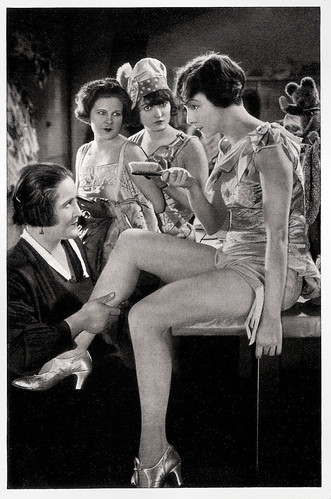
German collectors card by Ross Verlag in the series Vom Werden deutscher Filmkunst - Der Stumme Film, picture no. 184, group 43. Photo: Ufa. Dina Gralla in Das Girl von der Revue/The Girl from the Revue (Richard Eichberg, 1928).
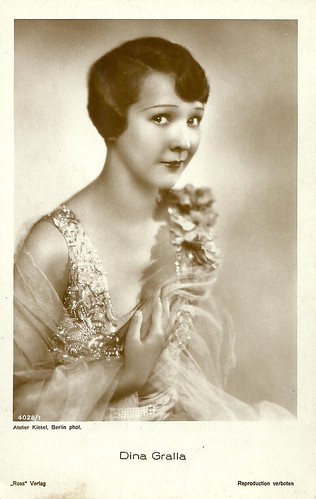
German postcard by Ross Verlag, no. 4028/1, 1929-1930. Photo: Atelier Kiesel, Berlin.
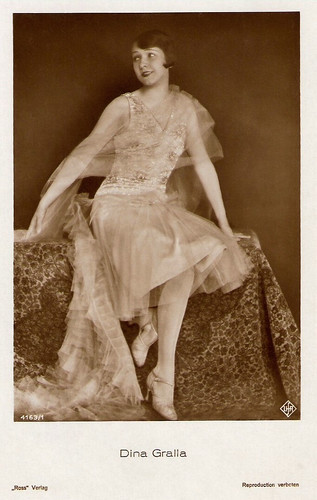
German postcard by Ross Verlag, no. 4163/1, 1929-1930. Photo: Ufa.
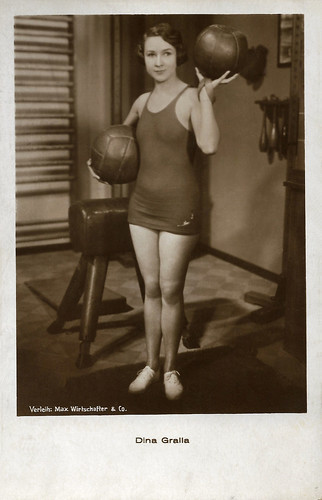
Austrian postcard by Iris-Verlag, no. 6071. Photo: Max Wirstchafter & Co.
Sources: Filmportal.de, Wikipedia, and .

Austrian postcard by Iris-Verlag, no. 5069. Photo: Manassé, Wien.

Austrian postcard by Iris-Verlag, no. 5070. Photo: Manassé, Wien.

German postcard by Ross Verlag, no. 1208/1, 1927-1928. Photo: Alex Binder / Eichberg-Film, Berlin. Collection: Didier Hanson.

German postcard by Ross Verlag, no. 6345/1, 1931-1932. Photo: Heros.
Naive and Sexy
Dina Gralla was born as Dina Sventen in Warsaw, Poland (then part of the Russian Empire) in 1905.
She had a dance training in 1919 and performed as a ballet dancer at the revue of the Wintergarten theatre in Berlin. After some private acting lessons from Walter Steinbeck, she appeared in the film drama Leidenschaft/Passion (Richard Eichberg, 1925).
From then on she was seen regularly in German silent films in roles as a naive, sexy girl, often appearing with Lilian Harvey , like in Die Kleine vom Bummel/The Girl on the Road (Richard Eichberg, 1925) and Prinzessin Trulala/Princess Trulala (Erich Schönfelder, Richard Eichberg, 1926).
Repeatedly she played dancers, most famously in the leading part of the hit revue film Das Girl von der Revue/The Girl from the Revue (Richard Eichberg, 1928) with Werner Fuetterer . She also worked as a stage actress, for example at the Theater in der Behrenstraße.
Other films included Die Tolle Komtess/The Crazy Countess (Richard Löwenbein, 1928) with Max Ehrlich and Werner Fuetterer , Ein Kleiner Vorschuß auf die Seligkeit/A Small Down Payment on Bliss (Jaap Speyer, 1929) opposite Paul Hörbiger , Wer wird denn weinen, wenn man auseinandergeht?/No Use Crying If Your Sweetheart Goes Away (Richard Eichberg, 1929) with Paul Morgan .

Austrian postcard by Iris-Verlag, no. 5363. Photo: Hugo Engel-Film. Publicity still for Das Girl von der Revue (Richard Eichberg, 1928) with Werner Fuetterer .

Polish postcard by Polonia, Krakow, no. 1320. Dina Gralla and Harry Halm in Prinzessin Trulala/Princess Trulala (Erich Schönfelder, Richard Eichberg, 1926).

German postcard by Ross Verlag, no. 3003/1, 1928-1929. Photo: Eichberg-Film, Berlin / Ufa. Dina Gralla in Du sollst nicht stehlen/Thou Shalt Not Steal (Victor Janson, 1928).

German postcard by Ross Verlag, no. 4550/1, 1929-1930. Photo: Alex Binder, Berlin.
Tuberculosis
Despite her Polish accent, Dina Gralla could continue her film career into the sound era.
She appeared in such comedies as Keine Feier ohne Meyer/No Celebration Without Meyer (Carl Boese, 1931) with Sig Arno , Der Liebesarzt/Doctor Love (Erich Schönfelder, 1931) opposite Harry Liedtke , and Der Liebesexpreß/Eight Days of Happiness (Robert Wiene, 1931) with Georg Alexander.
Her later films included Schwebende Jungfrau/The Soaring Maiden (Carl Boese, 1931) with Lissi Arna and Szöke Szakall , and Ein Auto und kein Geld/A Car and No Money (Jacob Fleck, Luise Fleck, 1932) with Paul Kemp .
Tragically, in 1933 tuberculosis developed in her lungs, and she had to retire. Her final role was in Grüß' mir die Lore noch einmal/Say Hello to Lore for me one more time (Carl Heinz Wolff, 1934).
In the following decade, she worked as a stenotypist, and after 1945 as a cleaning lady and a waitress. Finally, she worked at a Berlin library. Gralla returned one last time for the cameras in the revue film An jedem Finger zehn/Ten on Every Finger (Erik Ode, 1954).
Dina Gralla died in 1994, in Berlin-Charlottenburg. She was 89. In 1926, she had married newspaper correspondent Lincoln Eyre.

German collectors card by Ross Verlag in the series Vom Werden deutscher Filmkunst - Der Stumme Film, picture no. 184, group 43. Photo: Ufa. Dina Gralla in Das Girl von der Revue/The Girl from the Revue (Richard Eichberg, 1928).

German postcard by Ross Verlag, no. 4028/1, 1929-1930. Photo: Atelier Kiesel, Berlin.

German postcard by Ross Verlag, no. 4163/1, 1929-1930. Photo: Ufa.

Austrian postcard by Iris-Verlag, no. 6071. Photo: Max Wirstchafter & Co.
Sources: Filmportal.de, Wikipedia, and .
Published on June 30, 2020 22:00
June 29, 2020
Les Trois Mousquetaires (1921), Part 1
This post is about a series of 21 postcards, produced in 1921 by M. Le Deley, Paris for Pathé. They were publicity cards for the Pathé serial Les Trois Mousquetaires/The Three Musketeers (Henri Diamant Berger, 1921), the second film adaptation of the famous adventure novel by Alexandre Dumas père, published in 1844.
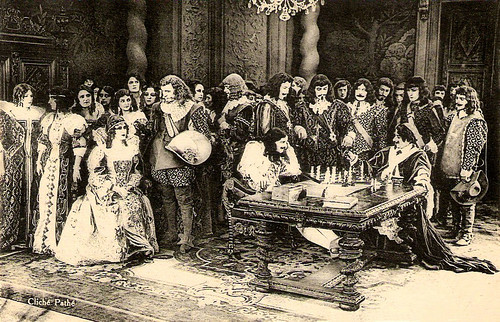
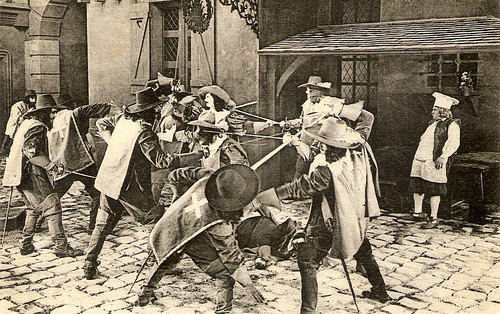
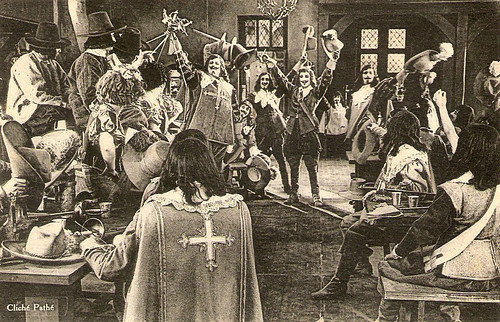
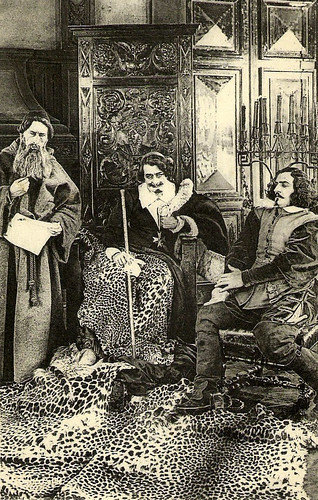
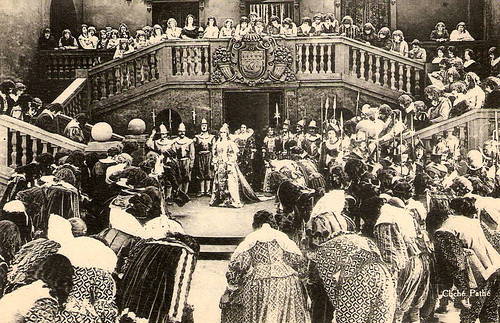
French postcards by M. Le Deley, Paris for Pathé Consortium Cinéma. Photos: stills from Les Trois Mousquetaires/The Three Musketeers (Henri Diamant Berger, 1921), based on the famous novel by Alexandre Dumas père.
Super-serial
Les Trois Mousquetaires/The Three Musketeers (1921) was a French twelve-hour mega-production. The film was divided into one-hour chapters, designed to be released as a serial in consecutive weeks over a three-month period.
This silent super-serial was produced by Pathé Frères and directed by Henri Diamant-Berger. Les Trois Mousquetaires saw well over 20 later film productions, including a rival Hollywood version with Douglas Fairbanks .
The very first cinematic adaptation of Dumas' famous novel 'Les trois mousquetaires' had been a French short made by Georges Méliès in 1903, Les trois mousquetaires et le collier de la reine/The three Musketeers and the Queen's Necklace.
The next adaptation, Les trois mousquetaires/The Three Musketeers (1913) by André Calmettes and Henri Pouctal was the first feature-length film version of the classic novel. In the early 1910s, feature-length films were new, but Pouctal's Les trois mousquetaires had already an extreme length of 4000 metres. The film was released in two parts, La Haine de Richelieu (Richelieu's Hate) and Le Triomphe d'Artagnan (D'Artagnan's Triumph).
The 1913 version starred Émile Dehelly as D'Artagnan and Nelly Cormon as Milady. In addition, the film featured Marcel Vibert as Athos, Adolphe Candé as Porthos, Stellio as Aramis, and Philippe Garnier as Cardinal Richelieu. There were bit parts for Jean Duval, Rolla Norman , and Edouard de Max . De Max would return in the 1921 version.
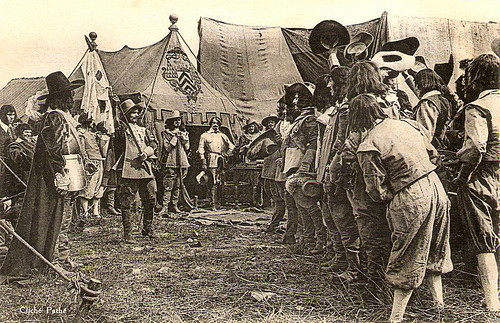
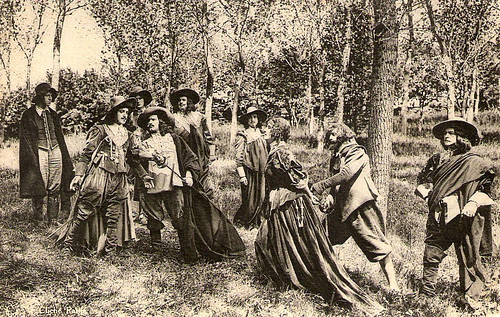
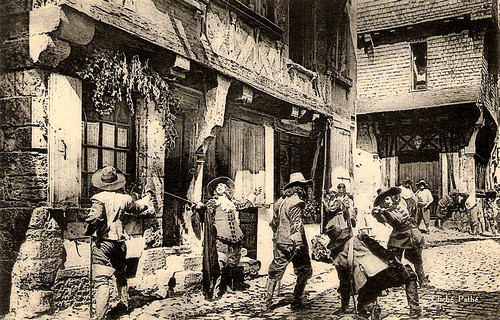
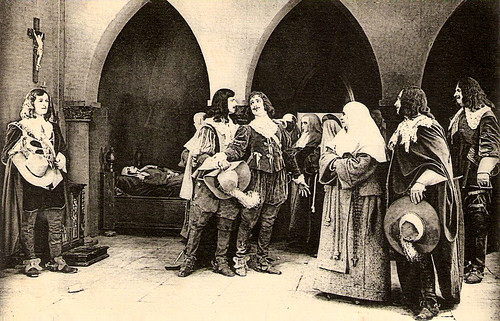
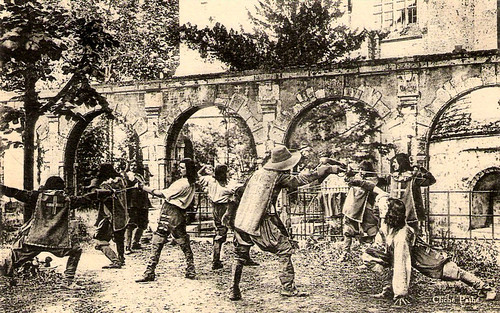
French postcards by M. Le Deley, Paris for Pathé Consortium Cinéma. Photos: stills from Les Trois Mousquetaires/The Three Musketeers (Henri Diamant Berger, 1921), based on the famous novel by Alexandre Dumas père.
Gigantic Budget
Edouard de Max played Cardinal Richelieu in the 1921 adaptation of Les Trois Mousquetaires/The Three Musketeers (1921, Henri Diamant-Berger, 1921). He also played Richelieu in Henri Diamant-Berger's sequel to Les trois mousquetaires: Vingts ans après/Five Years Later (1922). Later he also played roles in Diamant-Berger's films Les mauvais garçons/The Bad Boys (1922) and Milady (1923).
The Gascon D'Artagnan was played by Aimé Simon-Girard . The three musketeers were impersonated by Henri Rollan as Athos, Charles Martinelli as Porthos, and Pierre de Guingand as Aramis. The cast also included Claude Mérelle as Milady de Winter, Henri Baudin as Rochefort, and in a small role Albert Préjean .
Les Trois Mousquetaires (Henri Diamant-Berger, 1921) had a gigantic budget of 2,5 million French francs. The production had great looking sets which were partly filmed on locations as the Chenonceau castle, Chartres, and the Pérouges citadel, and it also had authentic recreations of 17th-century costumes.
The script by Auguste Macquet follows the classic novel by Alexandre Dumas père very faithfully. The novel tells the story of four comrades-in-arms, musketeers at the service of Louis XIII: Athos, who was unsuccessfully married to the evil female protagonist, Milady; Porthos, a kind-hearted gigantic man; Aramis, a mystic mixture of love and courage; and the young D’Artagnan, the hero of the story. “ALL FOR ONE AND ONE FOR ALL!!” is their motto.
The film has all the characters including minor characters such as Lord de Winter, Duchess de Chevreuse, and the Executioner of Lille. It also shows in flashbacks Athos courtship of the beautiful but treacherous woman - the supposed priest's sister who later resurfaces as Milady de Winter. The priest and Milady are both shown in the flashbacks.
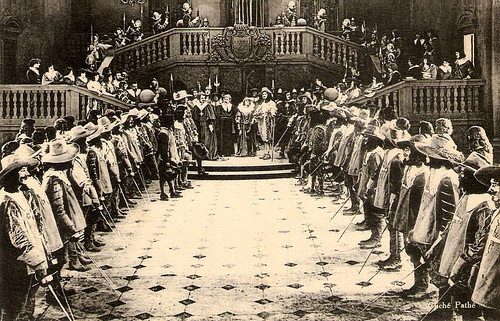
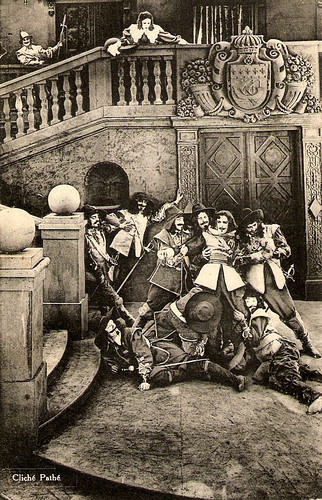
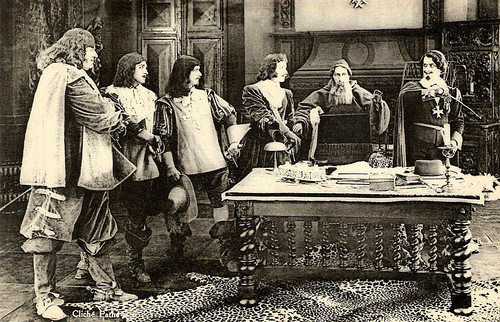
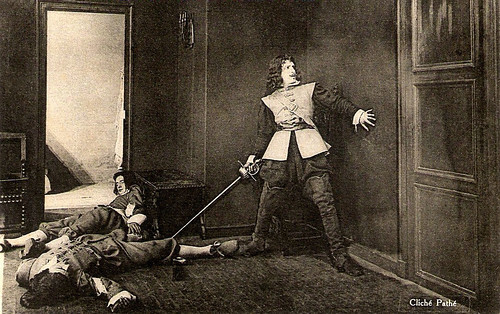
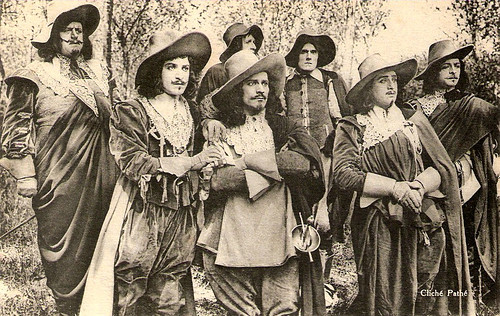
French postcards by M. Le Deley, Paris for Pathé Consortium Cinéma. Photos: stills from Les Trois Mousquetaires/The Three Musketeers (Henri Diamant Berger, 1921), based on the famous novel by Alexandre Dumas père.
Rival Version
When Henri Diamant-Berger wanted to film the story, he had first offered the role of Roland D’Artagnan to Douglas Fairbanks . Fairbanks refused, according to Diamant-Berger, "because he did not want to work in such a vulgar genre as the serial".
Douglas Fairbanks then made a rival version at United Artists, The Three Musketeers (Fred Niblo, 1921) with Barbara La Marr as Milady, Marguerite De La Motte as Constance, Eugene Pallette as Aramis, and Adolphe Menjou as Louis XIII.
Although entertaining, it was much more loosely adapted. The Fairbanks version did keep the character of Bernajoux the greatest swordsman of the Cardinal's Guard who went to avenge his fellow Cardinal's guards and ended up being defeated by D'Artagnan.
Les Trois Mousquetaires went on to become one of the most profitable films of the decade – quickly accumulating an astounding 17 million francs. The success of Les Trois Mousquetaires was aided by an arrangement with United Artists that kept Fairbanks’s The Three Musketeers from being distributed in France and much of Europe.
In 1933, Henri Diamant-Berger made a new, sound version of Les Trois Mousquetaires. Aimé Simon-Girard starred again as D' Artagnan, Henri Rollan returned as Athos, and Henri Baudin also reprised his role as Le comte de Rochefort.
All copies of the 1921 version were thought to be destroyed by the Nazis during the Second World War, but in 1995 a print of was rediscovered and remastered into a new version.
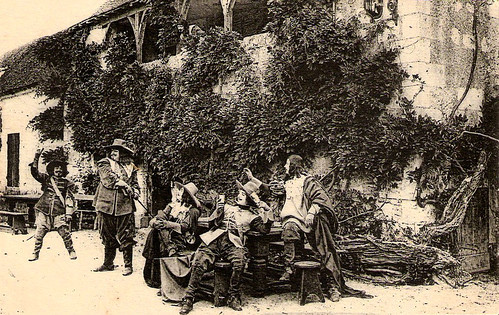
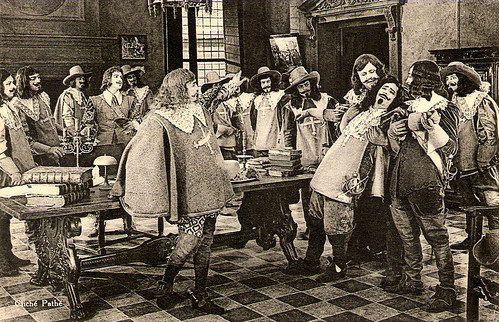
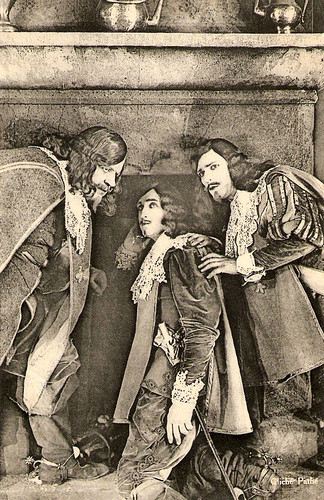
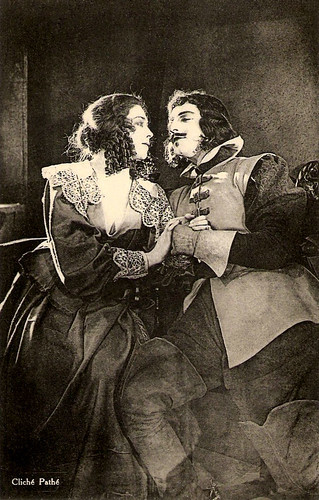
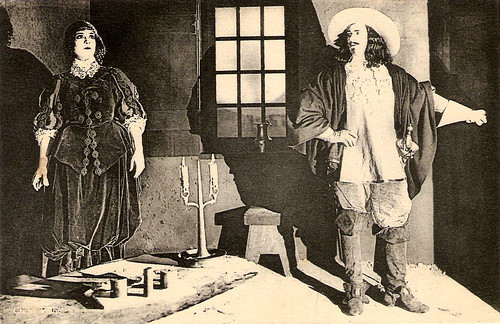
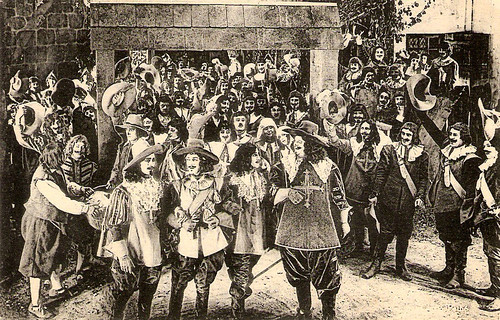
In true serial style, we will continue next week with a sequel post about Les Trois Mousquetaires (1921) in which we present other postcard series for the film.
Sources: Rudmer Canjels (Beyond the Cliffhanger: distributing silent serials), Richard Abel (French Cinema - The First Wave 1915-1929), Wikipedia, and IMDb.





French postcards by M. Le Deley, Paris for Pathé Consortium Cinéma. Photos: stills from Les Trois Mousquetaires/The Three Musketeers (Henri Diamant Berger, 1921), based on the famous novel by Alexandre Dumas père.
Super-serial
Les Trois Mousquetaires/The Three Musketeers (1921) was a French twelve-hour mega-production. The film was divided into one-hour chapters, designed to be released as a serial in consecutive weeks over a three-month period.
This silent super-serial was produced by Pathé Frères and directed by Henri Diamant-Berger. Les Trois Mousquetaires saw well over 20 later film productions, including a rival Hollywood version with Douglas Fairbanks .
The very first cinematic adaptation of Dumas' famous novel 'Les trois mousquetaires' had been a French short made by Georges Méliès in 1903, Les trois mousquetaires et le collier de la reine/The three Musketeers and the Queen's Necklace.
The next adaptation, Les trois mousquetaires/The Three Musketeers (1913) by André Calmettes and Henri Pouctal was the first feature-length film version of the classic novel. In the early 1910s, feature-length films were new, but Pouctal's Les trois mousquetaires had already an extreme length of 4000 metres. The film was released in two parts, La Haine de Richelieu (Richelieu's Hate) and Le Triomphe d'Artagnan (D'Artagnan's Triumph).
The 1913 version starred Émile Dehelly as D'Artagnan and Nelly Cormon as Milady. In addition, the film featured Marcel Vibert as Athos, Adolphe Candé as Porthos, Stellio as Aramis, and Philippe Garnier as Cardinal Richelieu. There were bit parts for Jean Duval, Rolla Norman , and Edouard de Max . De Max would return in the 1921 version.





French postcards by M. Le Deley, Paris for Pathé Consortium Cinéma. Photos: stills from Les Trois Mousquetaires/The Three Musketeers (Henri Diamant Berger, 1921), based on the famous novel by Alexandre Dumas père.
Gigantic Budget
Edouard de Max played Cardinal Richelieu in the 1921 adaptation of Les Trois Mousquetaires/The Three Musketeers (1921, Henri Diamant-Berger, 1921). He also played Richelieu in Henri Diamant-Berger's sequel to Les trois mousquetaires: Vingts ans après/Five Years Later (1922). Later he also played roles in Diamant-Berger's films Les mauvais garçons/The Bad Boys (1922) and Milady (1923).
The Gascon D'Artagnan was played by Aimé Simon-Girard . The three musketeers were impersonated by Henri Rollan as Athos, Charles Martinelli as Porthos, and Pierre de Guingand as Aramis. The cast also included Claude Mérelle as Milady de Winter, Henri Baudin as Rochefort, and in a small role Albert Préjean .
Les Trois Mousquetaires (Henri Diamant-Berger, 1921) had a gigantic budget of 2,5 million French francs. The production had great looking sets which were partly filmed on locations as the Chenonceau castle, Chartres, and the Pérouges citadel, and it also had authentic recreations of 17th-century costumes.
The script by Auguste Macquet follows the classic novel by Alexandre Dumas père very faithfully. The novel tells the story of four comrades-in-arms, musketeers at the service of Louis XIII: Athos, who was unsuccessfully married to the evil female protagonist, Milady; Porthos, a kind-hearted gigantic man; Aramis, a mystic mixture of love and courage; and the young D’Artagnan, the hero of the story. “ALL FOR ONE AND ONE FOR ALL!!” is their motto.
The film has all the characters including minor characters such as Lord de Winter, Duchess de Chevreuse, and the Executioner of Lille. It also shows in flashbacks Athos courtship of the beautiful but treacherous woman - the supposed priest's sister who later resurfaces as Milady de Winter. The priest and Milady are both shown in the flashbacks.





French postcards by M. Le Deley, Paris for Pathé Consortium Cinéma. Photos: stills from Les Trois Mousquetaires/The Three Musketeers (Henri Diamant Berger, 1921), based on the famous novel by Alexandre Dumas père.
Rival Version
When Henri Diamant-Berger wanted to film the story, he had first offered the role of Roland D’Artagnan to Douglas Fairbanks . Fairbanks refused, according to Diamant-Berger, "because he did not want to work in such a vulgar genre as the serial".
Douglas Fairbanks then made a rival version at United Artists, The Three Musketeers (Fred Niblo, 1921) with Barbara La Marr as Milady, Marguerite De La Motte as Constance, Eugene Pallette as Aramis, and Adolphe Menjou as Louis XIII.
Although entertaining, it was much more loosely adapted. The Fairbanks version did keep the character of Bernajoux the greatest swordsman of the Cardinal's Guard who went to avenge his fellow Cardinal's guards and ended up being defeated by D'Artagnan.
Les Trois Mousquetaires went on to become one of the most profitable films of the decade – quickly accumulating an astounding 17 million francs. The success of Les Trois Mousquetaires was aided by an arrangement with United Artists that kept Fairbanks’s The Three Musketeers from being distributed in France and much of Europe.
In 1933, Henri Diamant-Berger made a new, sound version of Les Trois Mousquetaires. Aimé Simon-Girard starred again as D' Artagnan, Henri Rollan returned as Athos, and Henri Baudin also reprised his role as Le comte de Rochefort.
All copies of the 1921 version were thought to be destroyed by the Nazis during the Second World War, but in 1995 a print of was rediscovered and remastered into a new version.






In true serial style, we will continue next week with a sequel post about Les Trois Mousquetaires (1921) in which we present other postcard series for the film.
Sources: Rudmer Canjels (Beyond the Cliffhanger: distributing silent serials), Richard Abel (French Cinema - The First Wave 1915-1929), Wikipedia, and IMDb.
Published on June 29, 2020 22:00
June 28, 2020
Walter Janssen
Walter Janssen (1887-1976) was a German stage and screen actor and film director. Between the late 1910s and the late 1950s, Walter Janssen had a very prolific acting career in German cinema. He appeared in more than 160 films between 1917 and 1970.
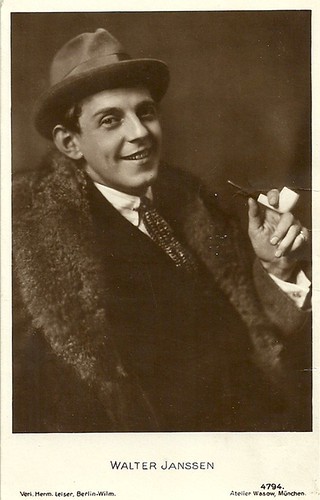
German postcard by Verlag Hermann Leiser, Berlin, no. 4794. Photo: Atelier Wasow, München.
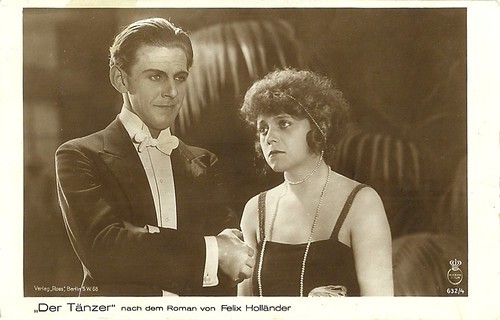
German postcard by Verlag Ross, Berlin, no. 632/4. Photo: Maxim Film. Walter Janssen and Ria Jende in Der Tänzer/The Dancer (Carl Froehlich, 1919), based on the novel by Felix Holländer.
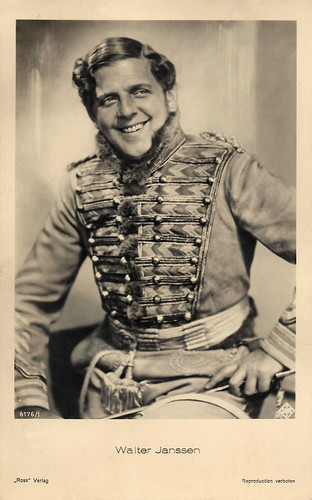
German postcard by Ross Verlag, no. 6176/1, 1931-1932. Photo: Ufa. Walter Janssen as Vicomte Noailles in Yorck (Gustav Ucicky, 1931).
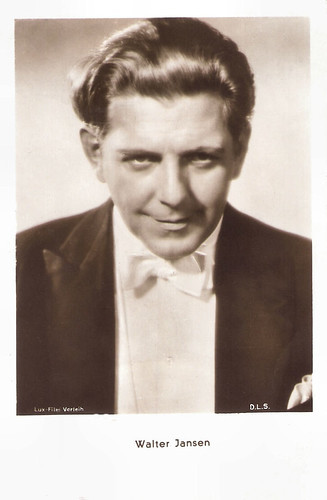
Austrian postcard by Iris Verlag, no. 5981. Photo: Lux Film-Verleih / D.L.S.
A young husband opposite Death
Walter Janssen was born Walter Philipp Janßen in 1887 in Krefeld, Germany. He began his theatre career in 1906 in Frankfurt am Main. He then worked from 1908 to 1910 in Kassel and from 1910 to 1915 again in Frankfurt.
In 1915, his daughter Signe von Scanzoni was born in Frankfurt, who grew out of Janssen's liaison with Amélie zu Fürstenberg. From 1915 to 1918 he worked in Munich and from 1919 at the Deutsches Theater in Berlin. Guest performances took him to London, among others.
In 1917 he made his first film appearance in Die entschleierte Maja/Maja unveiled (Ludwig Beck, 1917). In 1919 he played a reckless Casanova in Der Tänzer/The Dancer (Arthur Wollin, 1919). In 1921 he played the young husband in Fritz Lang's classic Der müde Tod/Destiny, but stood here in the shadow of Lil Dagover , who desperately struggles for his life as his wife, opposite Death, played by Bernhard Goetzke . Janssen also plays Dagover's lover in the three episodes set in the Middle Ages, the Renaissance and a fairy-tale-like China.
In Peter der Große/Peter the Great (Dimitri Buchowetzki, 1923), Janssen played the Zarevitch Alexis opposite Emil Jannings in the title role. In Zopf und Schwert/Braid and Sword (Victor Janson, Rudolf Dworsky, 1926) opposite Mady Christians as Princess Wilhelmine and Albert Steinrück. Janssen embodied Crown Prince Friedrich, the future Frederick II. In Maria Stuart (Friedrich Fehér, 1927), he was Lord Darnley, opposite Magda Sonja in the title role.
Other memorable parts Janssen had opposite Henny Porten in Struensee/Die Liebe einer Königin/The Love of a Queen (Ludwig Wolff, 1923) and Tragödie/Tragedy (Carl Froehlich, 1925), opposite Aud Egede Nissen in Karusellen/Carousel (Buchowetzki, 1923), and opposite Ellen Richter in Die tolle Herzogin/The Great Duchess (Willi Wolff, 1926) and Die Frau ohne Nerven/The Woman Without Nerves (Willi Wolff, 1929).
Walter Janssen easily made the passage to sound cinema, and with success. Initially, he was really on top, with the lead of operetta composer Toni opposite Gretl Theimer , Willi Forst and Oskar Karlweiss in the musical film Zwei Herzen im Dreiviertel-Takt/Two Hearts in Waltz Time (Géza von Bolváry, 1930), probably Janssen's first sound film.
Janssen had more male leads in musical comedies in these early sound years, e.g. in Die singende Stadt/The Singing City (Carmine Gallone, 1930), Kaiserliebchen/Emperor Sweetheart (Hans Tintner, 1931), Die Faschingsfee/The carnival fairy (Hans Steinhoff, 1931), etc. In addition, he had supporting parts in period pieces such as Das Flötenkonzert van Sanssouci/The Flute Concert of Sanssouci (Gustav Ucicky, 1930) with Otto Gebühr , or romantic comedies such as Jeder fragt nach Erika/Everyone Asks for Erika (Fredric Zelnik, 1931), Lachende Erben/Laughing Heirs (Max Ophüls, 1933), Maskerade (Willi Forst, 1934), etc.
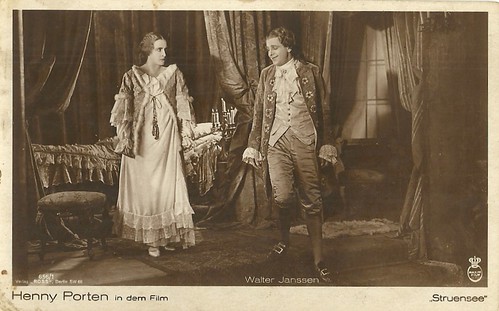
German postcard by Ross Verlag, no. 656/1. Photo: Maxim-Film. Henny Porten and Walter Janssen in Struensee/Der Liebe einer Königin (Ludwig Wolff, 1923).
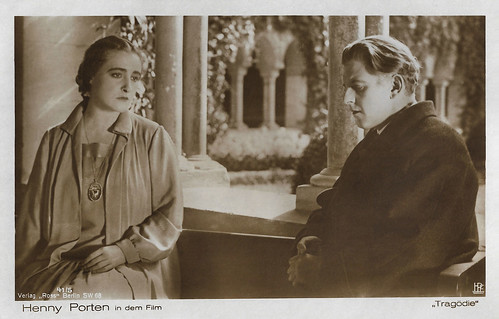
German postcard by Ross Verlag, no. 41/5. Photo: Henny-Porten-Film. Henny Porten and Walter Janssen in the German silent drama Tragödie (Carl Froelich, 1925).
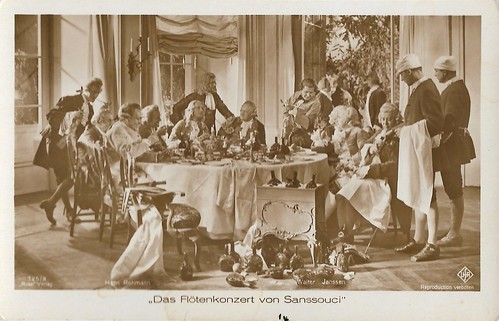
German postcard by Ross Verlag, no. 125/8. Photo: Ufa. Walter Janssen and Hans Rehmann in the German early sound film Das Flötenkonzert von Sanssouci/The Flute Concert of Sanssouci (Gustav von Ucicky, 1930).
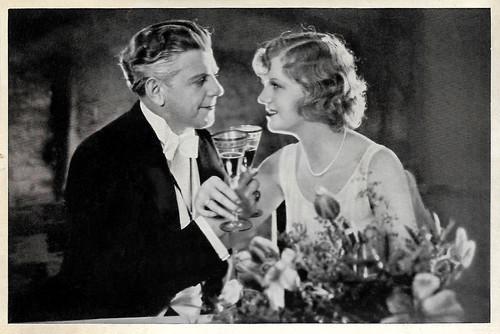
German collectors card in the series 'Vom Werden deutscher Filmkunst - Der Tonfilm', album no. 11, picture no. 20. Photo: Super-Film / Ross Verlag. Walter Janssen and Gretl Theimer in Zwei Herzen im Dreiviertel-Takt/Two Hearts in Waltz Time (Géza von Bolváry, 1930).
A machine for dangerous work
In 1934, Walter Janssen starred in Harry Piel 's S-F film Der Herr der Welt/The Master of the World (Harry Piel, 1934) as a German scientist who designs and builds a machine that will do dangerous work instead of placing humans in jeopardy. But the machine itself turns out to have disastrous effects on the people involved...
However, by the mid-1930s, Walter Janssen's roles became smaller, even though he continued to act in many more films. Substantial parts he still had in Geld fällt vom Himmel/Money from Heaven (Heinz Helbig, 1938), and in Wen die Götter lieben/Whom the Gods Love (Karl Hartl, 1942) as Mozart's father Leopold, Die schwache Stunde/The weak hour (Vladimír Slavínsk, 1943), Warum lügst Du, Elisabeth?/Why are you lying, Elisabeth? (Fritz Kirchhoff, 1944), and Das Hochzeitshotel/The Wedding Hotel (Carl Boese, 1944).
Janssen's first film after the war was an American release of Wen die Götter lieben/Whom the Gods Love, titled The Mozart Story (1948). IMDb mentioned this was a prewar, shelved Austrian film, but it has exactly the same cast as the 1942 film. According to IMDb , the film was dubbed in English, and new shots were added for the American release.
Janssen's real first postwar performance was in Morgen ist alles besser/Everything Will Be Better in the Morning (Arthur Maria Rabenalt, 1948). Janssen's postwar roles were mostly small, but more substantial ones he had e.g. in Tödliche Liebe/Deadly love (Fred Barius, Paul Pfeiffer, 1953) starring Rolf Möbius. In the 1930s and also the early 1950s Janssen also directed a few times, mostly light entertainment such as the Heinz Rühmann comedy Wer wagt – gewinnt/Who dares Wins (1935), and two fairy tale films in the 1950s.
In the 1960s Janssen participated in television plays and series. He again concentrated more on the world of theatre, was director of the Vienna Kammerspiele in the 1940s and directed the Marburg Festival. His last theatrical appearance was in 1971 in 'The Cherry Orchard' by Anton Chekhov at the Deutsches Schauspielhaus in Hamburg. In 1968, he received the Filmband in Gold for many years of excellent work in German film, having acted in over 180 film and TV productions.
Walter Janssen died in Munich in 1976.
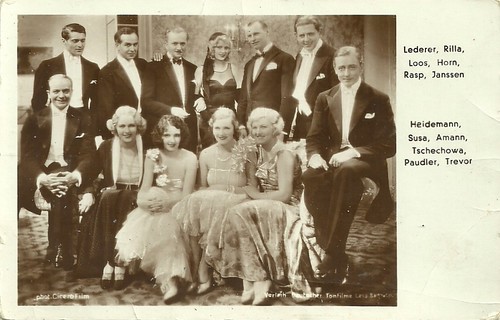
German postcard. Photo: Cicero Film / Distribution Deutsche Tonfilme. The 'fine fleur' of late silent German cinema stars, united for a photo for an early sound film company. Standing left to right: Franz Lederer , Walter Rilla , Theodor Loos , Camilla Horn , Fritz Rasp , and Walter Janssen. Sitting left to right: Paul Heidemann , Charlotte Susa , Betty Amann , Olga Tschechova , Maria Paudler , and Jack Trevor . Might be publicity for the early sound comedy Die grosse Sehnsucht/The Great Longing (Stefan Szekely/Steve Sekely, 1930), in which all acted, mostly as themselves - only Loos and Horn played characters. The plot was an excuse for 35 stars to debut in a talking picture.
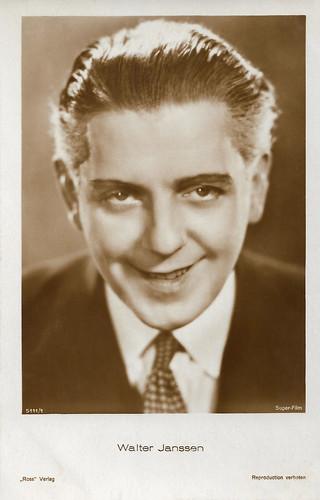
German postcard by Ross Verlag, no. 5111/1, 1930-1931. Photo: Super-Film.
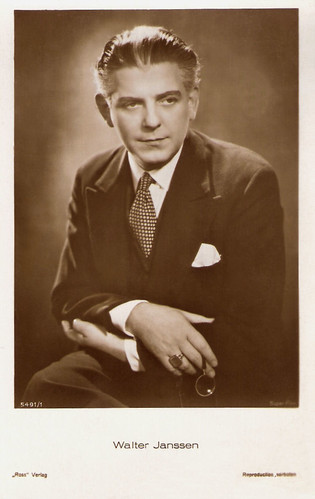
German postcard by Ross Verlag, no. 5491/1, 1930-1931. Photo: Super-Film.
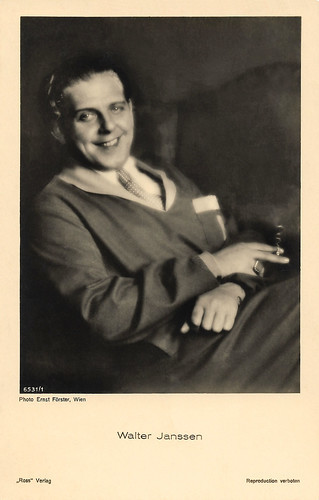
German postcard by Ross Verlag, no. 6531/1, 1931-1932. Photo: Ernst Förster, Wien (Vienna).
Sources: Wikipedia (German and English), and .

German postcard by Verlag Hermann Leiser, Berlin, no. 4794. Photo: Atelier Wasow, München.

German postcard by Verlag Ross, Berlin, no. 632/4. Photo: Maxim Film. Walter Janssen and Ria Jende in Der Tänzer/The Dancer (Carl Froehlich, 1919), based on the novel by Felix Holländer.

German postcard by Ross Verlag, no. 6176/1, 1931-1932. Photo: Ufa. Walter Janssen as Vicomte Noailles in Yorck (Gustav Ucicky, 1931).

Austrian postcard by Iris Verlag, no. 5981. Photo: Lux Film-Verleih / D.L.S.
A young husband opposite Death
Walter Janssen was born Walter Philipp Janßen in 1887 in Krefeld, Germany. He began his theatre career in 1906 in Frankfurt am Main. He then worked from 1908 to 1910 in Kassel and from 1910 to 1915 again in Frankfurt.
In 1915, his daughter Signe von Scanzoni was born in Frankfurt, who grew out of Janssen's liaison with Amélie zu Fürstenberg. From 1915 to 1918 he worked in Munich and from 1919 at the Deutsches Theater in Berlin. Guest performances took him to London, among others.
In 1917 he made his first film appearance in Die entschleierte Maja/Maja unveiled (Ludwig Beck, 1917). In 1919 he played a reckless Casanova in Der Tänzer/The Dancer (Arthur Wollin, 1919). In 1921 he played the young husband in Fritz Lang's classic Der müde Tod/Destiny, but stood here in the shadow of Lil Dagover , who desperately struggles for his life as his wife, opposite Death, played by Bernhard Goetzke . Janssen also plays Dagover's lover in the three episodes set in the Middle Ages, the Renaissance and a fairy-tale-like China.
In Peter der Große/Peter the Great (Dimitri Buchowetzki, 1923), Janssen played the Zarevitch Alexis opposite Emil Jannings in the title role. In Zopf und Schwert/Braid and Sword (Victor Janson, Rudolf Dworsky, 1926) opposite Mady Christians as Princess Wilhelmine and Albert Steinrück. Janssen embodied Crown Prince Friedrich, the future Frederick II. In Maria Stuart (Friedrich Fehér, 1927), he was Lord Darnley, opposite Magda Sonja in the title role.
Other memorable parts Janssen had opposite Henny Porten in Struensee/Die Liebe einer Königin/The Love of a Queen (Ludwig Wolff, 1923) and Tragödie/Tragedy (Carl Froehlich, 1925), opposite Aud Egede Nissen in Karusellen/Carousel (Buchowetzki, 1923), and opposite Ellen Richter in Die tolle Herzogin/The Great Duchess (Willi Wolff, 1926) and Die Frau ohne Nerven/The Woman Without Nerves (Willi Wolff, 1929).
Walter Janssen easily made the passage to sound cinema, and with success. Initially, he was really on top, with the lead of operetta composer Toni opposite Gretl Theimer , Willi Forst and Oskar Karlweiss in the musical film Zwei Herzen im Dreiviertel-Takt/Two Hearts in Waltz Time (Géza von Bolváry, 1930), probably Janssen's first sound film.
Janssen had more male leads in musical comedies in these early sound years, e.g. in Die singende Stadt/The Singing City (Carmine Gallone, 1930), Kaiserliebchen/Emperor Sweetheart (Hans Tintner, 1931), Die Faschingsfee/The carnival fairy (Hans Steinhoff, 1931), etc. In addition, he had supporting parts in period pieces such as Das Flötenkonzert van Sanssouci/The Flute Concert of Sanssouci (Gustav Ucicky, 1930) with Otto Gebühr , or romantic comedies such as Jeder fragt nach Erika/Everyone Asks for Erika (Fredric Zelnik, 1931), Lachende Erben/Laughing Heirs (Max Ophüls, 1933), Maskerade (Willi Forst, 1934), etc.

German postcard by Ross Verlag, no. 656/1. Photo: Maxim-Film. Henny Porten and Walter Janssen in Struensee/Der Liebe einer Königin (Ludwig Wolff, 1923).

German postcard by Ross Verlag, no. 41/5. Photo: Henny-Porten-Film. Henny Porten and Walter Janssen in the German silent drama Tragödie (Carl Froelich, 1925).

German postcard by Ross Verlag, no. 125/8. Photo: Ufa. Walter Janssen and Hans Rehmann in the German early sound film Das Flötenkonzert von Sanssouci/The Flute Concert of Sanssouci (Gustav von Ucicky, 1930).

German collectors card in the series 'Vom Werden deutscher Filmkunst - Der Tonfilm', album no. 11, picture no. 20. Photo: Super-Film / Ross Verlag. Walter Janssen and Gretl Theimer in Zwei Herzen im Dreiviertel-Takt/Two Hearts in Waltz Time (Géza von Bolváry, 1930).
A machine for dangerous work
In 1934, Walter Janssen starred in Harry Piel 's S-F film Der Herr der Welt/The Master of the World (Harry Piel, 1934) as a German scientist who designs and builds a machine that will do dangerous work instead of placing humans in jeopardy. But the machine itself turns out to have disastrous effects on the people involved...
However, by the mid-1930s, Walter Janssen's roles became smaller, even though he continued to act in many more films. Substantial parts he still had in Geld fällt vom Himmel/Money from Heaven (Heinz Helbig, 1938), and in Wen die Götter lieben/Whom the Gods Love (Karl Hartl, 1942) as Mozart's father Leopold, Die schwache Stunde/The weak hour (Vladimír Slavínsk, 1943), Warum lügst Du, Elisabeth?/Why are you lying, Elisabeth? (Fritz Kirchhoff, 1944), and Das Hochzeitshotel/The Wedding Hotel (Carl Boese, 1944).
Janssen's first film after the war was an American release of Wen die Götter lieben/Whom the Gods Love, titled The Mozart Story (1948). IMDb mentioned this was a prewar, shelved Austrian film, but it has exactly the same cast as the 1942 film. According to IMDb , the film was dubbed in English, and new shots were added for the American release.
Janssen's real first postwar performance was in Morgen ist alles besser/Everything Will Be Better in the Morning (Arthur Maria Rabenalt, 1948). Janssen's postwar roles were mostly small, but more substantial ones he had e.g. in Tödliche Liebe/Deadly love (Fred Barius, Paul Pfeiffer, 1953) starring Rolf Möbius. In the 1930s and also the early 1950s Janssen also directed a few times, mostly light entertainment such as the Heinz Rühmann comedy Wer wagt – gewinnt/Who dares Wins (1935), and two fairy tale films in the 1950s.
In the 1960s Janssen participated in television plays and series. He again concentrated more on the world of theatre, was director of the Vienna Kammerspiele in the 1940s and directed the Marburg Festival. His last theatrical appearance was in 1971 in 'The Cherry Orchard' by Anton Chekhov at the Deutsches Schauspielhaus in Hamburg. In 1968, he received the Filmband in Gold for many years of excellent work in German film, having acted in over 180 film and TV productions.
Walter Janssen died in Munich in 1976.

German postcard. Photo: Cicero Film / Distribution Deutsche Tonfilme. The 'fine fleur' of late silent German cinema stars, united for a photo for an early sound film company. Standing left to right: Franz Lederer , Walter Rilla , Theodor Loos , Camilla Horn , Fritz Rasp , and Walter Janssen. Sitting left to right: Paul Heidemann , Charlotte Susa , Betty Amann , Olga Tschechova , Maria Paudler , and Jack Trevor . Might be publicity for the early sound comedy Die grosse Sehnsucht/The Great Longing (Stefan Szekely/Steve Sekely, 1930), in which all acted, mostly as themselves - only Loos and Horn played characters. The plot was an excuse for 35 stars to debut in a talking picture.

German postcard by Ross Verlag, no. 5111/1, 1930-1931. Photo: Super-Film.

German postcard by Ross Verlag, no. 5491/1, 1930-1931. Photo: Super-Film.

German postcard by Ross Verlag, no. 6531/1, 1931-1932. Photo: Ernst Förster, Wien (Vienna).
Sources: Wikipedia (German and English), and .
Published on June 28, 2020 22:00
June 27, 2020
Clark Gable
With his natural charm and knowing smile, Clark Gable (1901-1959) was 'The King of Hollywood' during the 1930s. He often portrayed down-to-earth, bravado characters with a carefree attitude, and was seen as the epitome of masculinity. Gable won an Academy Award for Best Actor for It Happened One Night (1934), and was nominated for Mutiny on the Bounty (1935) and for his best-known role as Rhett Butler in Gone with the Wind (1939).
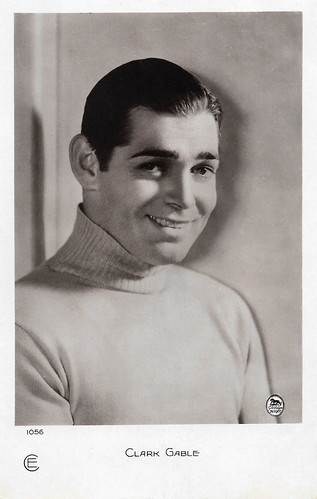
French postcard by Europe, no. 1056. Photo: Metro-Goldwyn-Mayer.
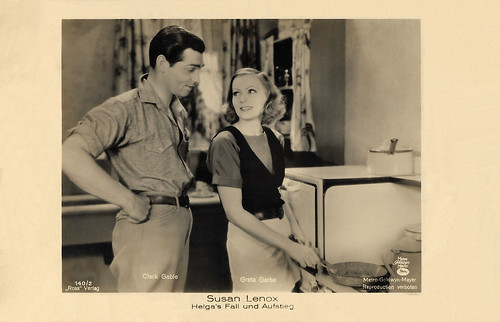
German postcard by Ross Verlag, no. 140/2. Greta Garbo and Clark Gable in Susan Lenox (Her Fall and Rise) (Robert Z. Leonard, 1931). The film was released in German-speaking countries as Helga's Fall und Aufstieg. Garbo's character's name is really Helga Ohlin, she only later changes it into Susan Lenox.
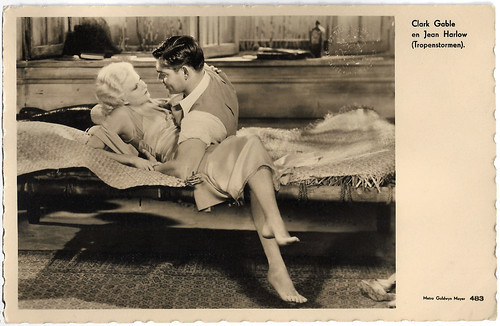
Dutch postcard, no. 483. Photo: M.G.M. Jean Harlow and Clark Gable in Red Dust (Victor Fleming, 1932). Sent by mail in 1935.

British postcard in the Film Partners Series, London, no. PC 95. Photo: Metro-Goldwyn-Mayer. Clark Gable and Helen Hayes in The White Sister (Victor Fleming, 1933).
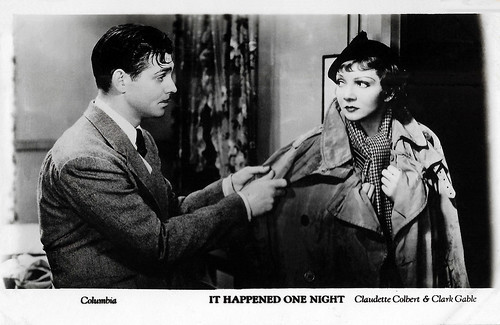
British postcard in the Film Shots Series by Film Weekly. Photo: Columbia. Clark Gable and Claudette Colbert in It Happened One Night (Frank Capra, 1934).

Italian postcard by Zincografica, Firenze. Photo: Vivien Leigh and Clark Gable in Gone with the Wind (Victor Fleming, 1939).
His teeth repaired and his hair styled
William Clark Gable was born in 1901 in Cadiz, Ohio, to Adeline (Hershelman) and William Henry Gable, an oil-well driller. He was of German, Irish, and Swiss-German descent. When he was seven months old, his mother died, and his father sent him to live with his maternal aunt and uncle in Pennsylvania, where he stayed until he was two. His father then returned to take him back to Cadiz.
At 16, he quit high school, went to work in an Akron, Ohio, tire factory, and decided to become an actor after seeing the play 'The Bird of Paradise'. He toured in stock companies, worked oil fields, and sold ties.
His acting coach Josephine Dillon, 15 years his senior, paid for him to have his teeth repaired and his hair styled. She also trained him to lower his voice and attain better body posture, attributes that that were instrumental in contributing to his later success and eventual iconic status.
In 1924, with Dillon's financing, they went to Hollywood, where she became Gable's manager and first wife. He appeared as an extra in silent films between 1924 and 1926. However, he was not offered any major film roles, so he returned to the stage.
While Gable acted on stage, he became a lifelong friend of Lionel Barrymore. He moved to New York City, where Dillon sought work for him on Broadway. He received good reviews in 'Machinal' (1928). He gave an impressive appearance as the seething and desperate character Killer Mears in the Los Angeles stage production of 'The Last Mile'.
In 1930, Gable and Dillon divorced, and a year later, he married Maria Langham (a.k.a. Maria Franklin Gable), also about 17 years older than him.
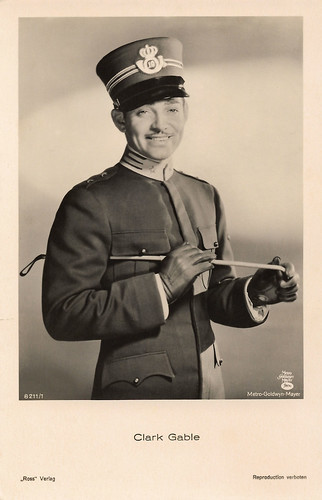
German postcard by Ross Verlag, no. 8211/1, 1933-1934. Photo: Metro-Goldwyn-Mayer. Clark Gable in The White Sister (Victor Fleming, 1933).
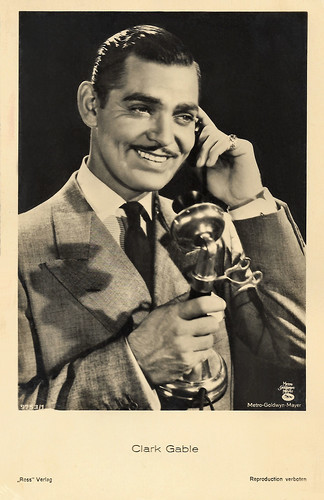
German postcard by Ross Verlag, no. 9753/1, 1935-1936. Photo: Metro-Goldwyn-Mayer.
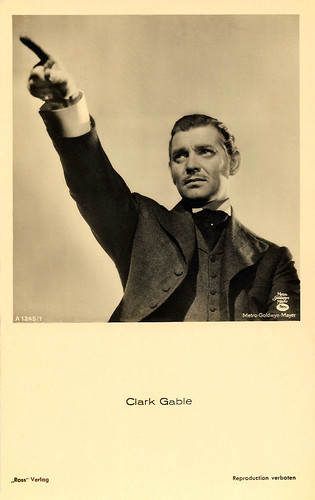
German postcard by Ross Verlag, no. A 1245/1, 1937-1938. Photo: Metro-Goldwyn-Mayer. Clark Gable in Parnell (John M. Stahl, 1937).
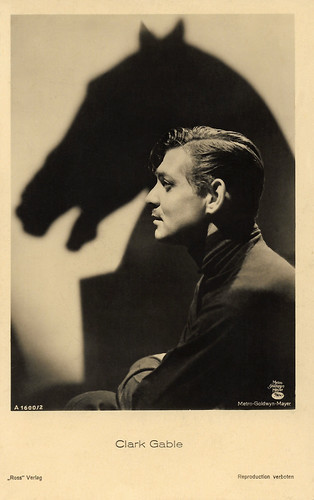
German postcard by Ross Verlag, no. A 1600/2, 1937-1938. Photo: Metro-Goldwyn-Mayer. Clark Gable in Saratoga (Jack Conway, 1937).
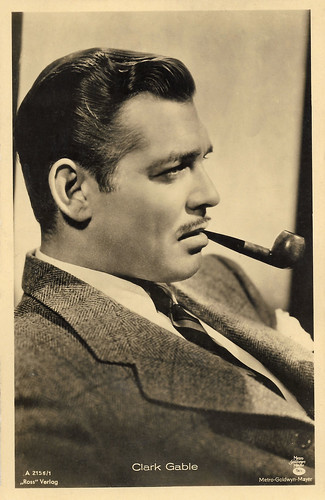
German postcard by Ross Verlag, no. A 2156/1, 1939-1940. Photo: Metro-Goldwyn-Mayer.
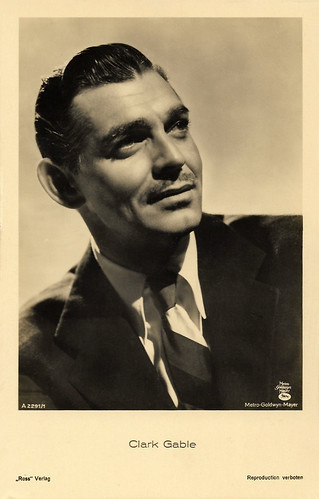
German postcard by Ross Verlag, no. A 2291/1, 1939-1940. Photo: Metro-Goldwyn-Mayer.
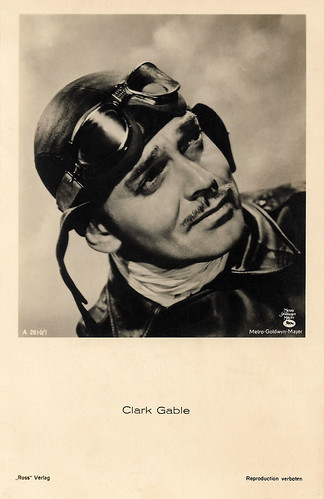
German postcard by Ross Verlag, no. A 2610/1, 1939-1940. Photo: Metro-Goldwyn-Mayer. Clark Gable in Test Pilot (Victor Fleming, 1938).
Unshaven lovemaking with bra-less Jean Harlow
After several failed screen tests, Clark Gable was signed in 1930 by MGM's Irving Thalberg. He made his talking film debut as an archetypal villain named Brett in the Western The Painted Desert (Howard Higgin, 1931), starring William Boyd.
Joan Crawford asked for him as a co-star in Dance, Fools, Dance (Harry Beaumont, 1931) and the public loved him manhandling Norma Shearer in A Free Soul (Clarence Brown, 1931) the same year.
His unshaven lovemaking with bra-less Jean Harlow in Red Dust (Victor Fleming, 1932) made him MGM's most important star. His acting career then flourished.
At one point, he refused an assignment, and the studio punished him by loaning him out to (at the time) low-rent Columbia Pictures, which put him in Frank Capra's It Happened One Night (1934) opposite Claudette Colbert . He won an Academy Award for his performance.
The next year saw a starring role in Call of the Wild (William A. Wellman, 1935) with Loretta Young, with whom he had an affair. It resulted in the birth of a daughter, Judy Lewis. He returned to far more substantial roles at MGM, such as Fletcher Christian in Mutiny on the Bounty (Frank Lloyd, 1935) and Rhett Butler in the Oscar-winning epic Gone with the Wind (Victor Fleming, 1939).
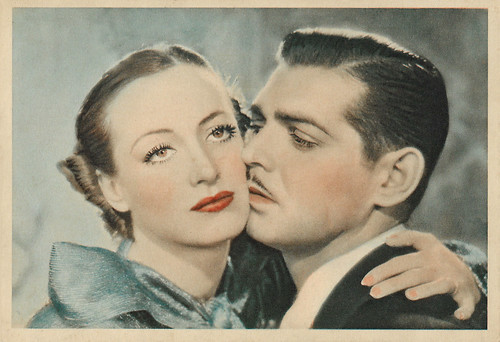
British postcard by De Reszke Cigarettes, no. 47. Photo: M.G.M. Joan Crawford and Clark Gable in Forsaking All Others (W.S. Van Dyke, 1934).
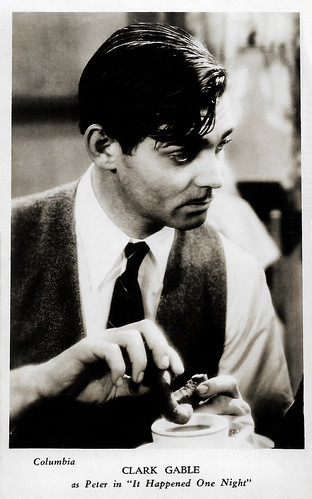
British postcard. Photo: Columbia. Clark Gable as Peter in It Happened One Night (Frank Capra, 1934).
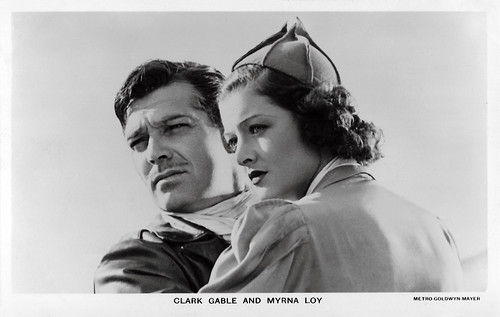
British postcard in the Film Partners Series, London, no. P 249. Photo: Metro-Goldwyn-Mayer. Clark Gable and Myrna Loy in Test Pilot (Victor Fleming, 1938).
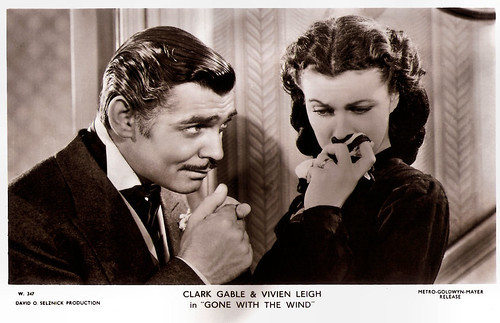
British postcard in the Picturegoer Series, London, no. W. 347. Photo: David O'Selznick Production / Metro-Goldwyn-Mayer. Vivien Leigh and Clark Gable in Gone with the Wind (Victor Fleming, 1939).
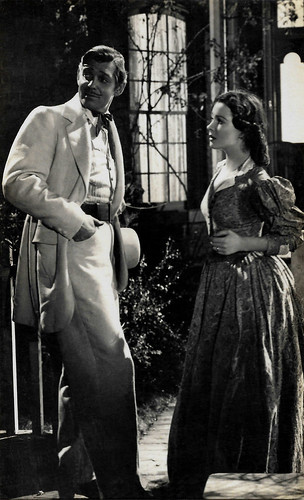
Spanish postcard by Archivo Bermejo. Sent by mail in 1951. Photo: Metro Goldwyn Mayer. Clark Gable and Vivien Leigh in Gone with the Wind (Victor Fleming, 1939).
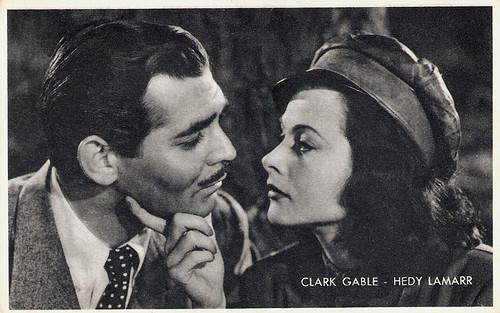
Belgian collector's card by Kwatta, Bois d'Haine, Series C, no. 166. Photo: MGM. Hedy Lamarr and Clark Gable in Comrade X (King Vidor, 1940).
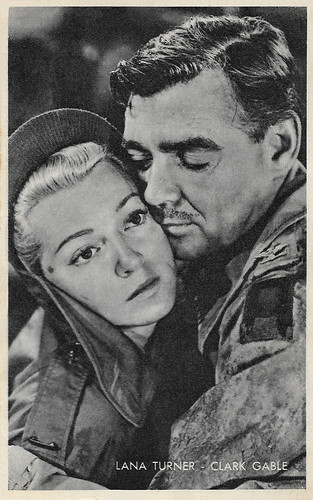
Belgian Collectors Card by Kwatta, Bois d'Haine, Series C, no. 194. Photo: Metro-Goldwyn-Mayer. Lana Turner and Clark Gable in Homecoming (Mervyn LeRoy, 1948).
Grief-stricken flying combat missions
After divorcing Maria Langham, Clark Gable married Carole Lombard in 1939, but tragedy struck in January 1942 when the plane in which Carole and her mother were flying crashed into Table Rock Mountain, Nevada, killing them both.
A grief-stricken Gable joined the US Army Air Force and was off the screen for three years, flying combat missions in Europe. When he returned the studio regarded his salary as excessive and did not renew his contract. He freelanced, but his films didn't do well at the box office.
He starred in such films as The Hucksters (Jack Conway, 1947) and Homecoming (Mervyn LeRoy, 1948) with Lana Turner . He married Sylvia Ashley, the widow of Douglas Fairbanks , in 1949. Unfortunately, this marriage was short-lived and they divorced in 1952.
In July 1955 he married a former sweetheart, Kathleen Williams Spreckles (a.k.a. Kay Williams), and became stepfather to her two children, Joan and Adolph ("Bunker") Spreckels III. In 1959, Gable became a grandfather when Judy Lewis, his daughter with Loretta Young, gave birth to a daughter, Maria. In 1960, Gable's wife Kay discovered that she was expecting their first child.
In early November 1960, he had just completed filming The Misfits (John Huston, 1961) with Montgomery Clift and Marilyn Monroe , when he suffered a heart attack, and died later that month. Gable was buried shortly afterward in the shrine that he had built for Carole Lombard and her mother when they died, at Forest Lawn Cemetery. In March 1961, Kay Gable gave birth to a boy, whom she named John Clark Gable after his father.
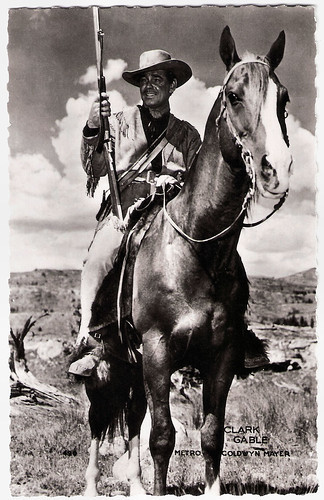
French postcard by Editions P.I., no. 12 F. Photo: Metro-Goldwyn-Mayer, 1954. Clark Gable in Lone Star (Vincent Sherman, 1952).
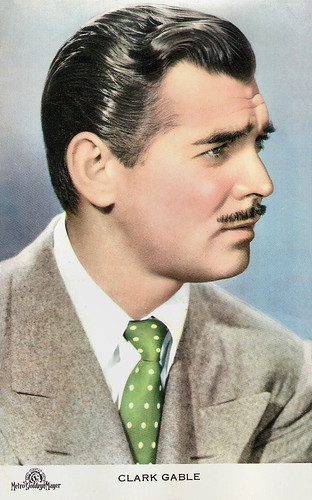
Belgian postcard by S.A. Victoria, Bruxelles / N.V. Victoria, Brussel, no. 639. Photo: Metro-Goldwyn-Mayer.
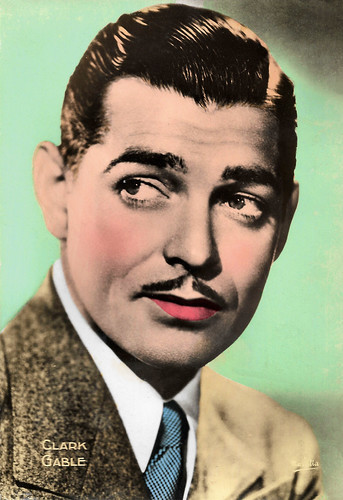
French collectors card by Massilia.
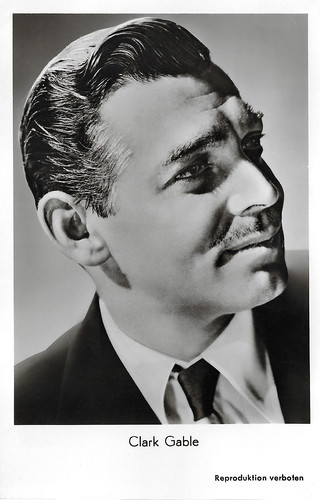
German postcard by F.J. Rüdel, Filmpostkartenverlag, Hamburg-Bergedorf, no. 189dpa. Photo: Metro-Goldwyn-Mayer.
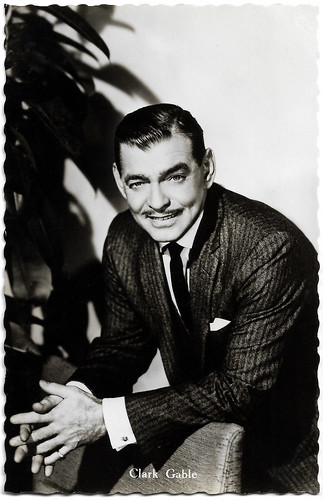
Dutch postcard by N.V. v.h. Weenenk & Snel, Baarn, no. 160. Photo: Paramount. Clark Gable in But Not For Me (Walter Lang, 1959). Collection: Geoffrey Donaldson Institute.
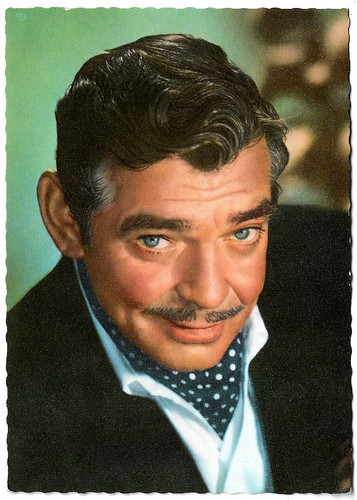
German postcard by Ufa (Universum-Film Aktiengesellschaft), Berlin-Tempelhof, no. CL-269. Photo: Terb Agency.
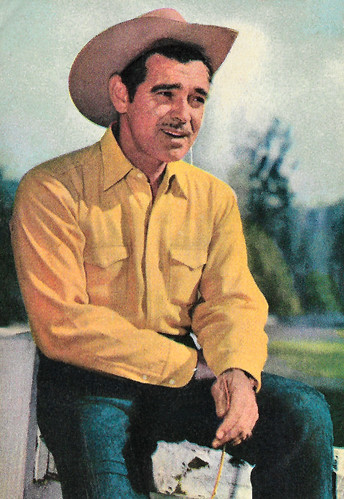
German collectors card by Schumann-Verlag, Berlin-Lichterfelde-Süd / Heinerle, Bamberg. Photo: Ullstein.
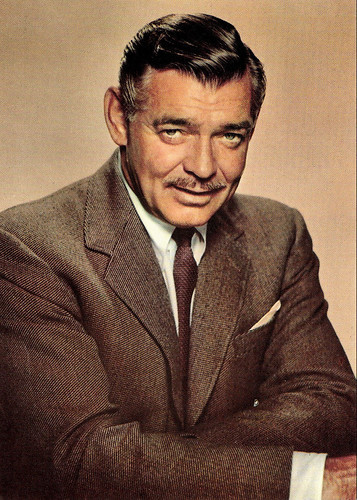
Italian postcard by Rotalfoto, Milano, no. 10.
Sources (IMDb), Wikipedia, and .

French postcard by Europe, no. 1056. Photo: Metro-Goldwyn-Mayer.

German postcard by Ross Verlag, no. 140/2. Greta Garbo and Clark Gable in Susan Lenox (Her Fall and Rise) (Robert Z. Leonard, 1931). The film was released in German-speaking countries as Helga's Fall und Aufstieg. Garbo's character's name is really Helga Ohlin, she only later changes it into Susan Lenox.

Dutch postcard, no. 483. Photo: M.G.M. Jean Harlow and Clark Gable in Red Dust (Victor Fleming, 1932). Sent by mail in 1935.

British postcard in the Film Partners Series, London, no. PC 95. Photo: Metro-Goldwyn-Mayer. Clark Gable and Helen Hayes in The White Sister (Victor Fleming, 1933).

British postcard in the Film Shots Series by Film Weekly. Photo: Columbia. Clark Gable and Claudette Colbert in It Happened One Night (Frank Capra, 1934).

Italian postcard by Zincografica, Firenze. Photo: Vivien Leigh and Clark Gable in Gone with the Wind (Victor Fleming, 1939).
His teeth repaired and his hair styled
William Clark Gable was born in 1901 in Cadiz, Ohio, to Adeline (Hershelman) and William Henry Gable, an oil-well driller. He was of German, Irish, and Swiss-German descent. When he was seven months old, his mother died, and his father sent him to live with his maternal aunt and uncle in Pennsylvania, where he stayed until he was two. His father then returned to take him back to Cadiz.
At 16, he quit high school, went to work in an Akron, Ohio, tire factory, and decided to become an actor after seeing the play 'The Bird of Paradise'. He toured in stock companies, worked oil fields, and sold ties.
His acting coach Josephine Dillon, 15 years his senior, paid for him to have his teeth repaired and his hair styled. She also trained him to lower his voice and attain better body posture, attributes that that were instrumental in contributing to his later success and eventual iconic status.
In 1924, with Dillon's financing, they went to Hollywood, where she became Gable's manager and first wife. He appeared as an extra in silent films between 1924 and 1926. However, he was not offered any major film roles, so he returned to the stage.
While Gable acted on stage, he became a lifelong friend of Lionel Barrymore. He moved to New York City, where Dillon sought work for him on Broadway. He received good reviews in 'Machinal' (1928). He gave an impressive appearance as the seething and desperate character Killer Mears in the Los Angeles stage production of 'The Last Mile'.
In 1930, Gable and Dillon divorced, and a year later, he married Maria Langham (a.k.a. Maria Franklin Gable), also about 17 years older than him.

German postcard by Ross Verlag, no. 8211/1, 1933-1934. Photo: Metro-Goldwyn-Mayer. Clark Gable in The White Sister (Victor Fleming, 1933).

German postcard by Ross Verlag, no. 9753/1, 1935-1936. Photo: Metro-Goldwyn-Mayer.

German postcard by Ross Verlag, no. A 1245/1, 1937-1938. Photo: Metro-Goldwyn-Mayer. Clark Gable in Parnell (John M. Stahl, 1937).

German postcard by Ross Verlag, no. A 1600/2, 1937-1938. Photo: Metro-Goldwyn-Mayer. Clark Gable in Saratoga (Jack Conway, 1937).

German postcard by Ross Verlag, no. A 2156/1, 1939-1940. Photo: Metro-Goldwyn-Mayer.

German postcard by Ross Verlag, no. A 2291/1, 1939-1940. Photo: Metro-Goldwyn-Mayer.

German postcard by Ross Verlag, no. A 2610/1, 1939-1940. Photo: Metro-Goldwyn-Mayer. Clark Gable in Test Pilot (Victor Fleming, 1938).
Unshaven lovemaking with bra-less Jean Harlow
After several failed screen tests, Clark Gable was signed in 1930 by MGM's Irving Thalberg. He made his talking film debut as an archetypal villain named Brett in the Western The Painted Desert (Howard Higgin, 1931), starring William Boyd.
Joan Crawford asked for him as a co-star in Dance, Fools, Dance (Harry Beaumont, 1931) and the public loved him manhandling Norma Shearer in A Free Soul (Clarence Brown, 1931) the same year.
His unshaven lovemaking with bra-less Jean Harlow in Red Dust (Victor Fleming, 1932) made him MGM's most important star. His acting career then flourished.
At one point, he refused an assignment, and the studio punished him by loaning him out to (at the time) low-rent Columbia Pictures, which put him in Frank Capra's It Happened One Night (1934) opposite Claudette Colbert . He won an Academy Award for his performance.
The next year saw a starring role in Call of the Wild (William A. Wellman, 1935) with Loretta Young, with whom he had an affair. It resulted in the birth of a daughter, Judy Lewis. He returned to far more substantial roles at MGM, such as Fletcher Christian in Mutiny on the Bounty (Frank Lloyd, 1935) and Rhett Butler in the Oscar-winning epic Gone with the Wind (Victor Fleming, 1939).

British postcard by De Reszke Cigarettes, no. 47. Photo: M.G.M. Joan Crawford and Clark Gable in Forsaking All Others (W.S. Van Dyke, 1934).

British postcard. Photo: Columbia. Clark Gable as Peter in It Happened One Night (Frank Capra, 1934).

British postcard in the Film Partners Series, London, no. P 249. Photo: Metro-Goldwyn-Mayer. Clark Gable and Myrna Loy in Test Pilot (Victor Fleming, 1938).

British postcard in the Picturegoer Series, London, no. W. 347. Photo: David O'Selznick Production / Metro-Goldwyn-Mayer. Vivien Leigh and Clark Gable in Gone with the Wind (Victor Fleming, 1939).

Spanish postcard by Archivo Bermejo. Sent by mail in 1951. Photo: Metro Goldwyn Mayer. Clark Gable and Vivien Leigh in Gone with the Wind (Victor Fleming, 1939).

Belgian collector's card by Kwatta, Bois d'Haine, Series C, no. 166. Photo: MGM. Hedy Lamarr and Clark Gable in Comrade X (King Vidor, 1940).

Belgian Collectors Card by Kwatta, Bois d'Haine, Series C, no. 194. Photo: Metro-Goldwyn-Mayer. Lana Turner and Clark Gable in Homecoming (Mervyn LeRoy, 1948).
Grief-stricken flying combat missions
After divorcing Maria Langham, Clark Gable married Carole Lombard in 1939, but tragedy struck in January 1942 when the plane in which Carole and her mother were flying crashed into Table Rock Mountain, Nevada, killing them both.
A grief-stricken Gable joined the US Army Air Force and was off the screen for three years, flying combat missions in Europe. When he returned the studio regarded his salary as excessive and did not renew his contract. He freelanced, but his films didn't do well at the box office.
He starred in such films as The Hucksters (Jack Conway, 1947) and Homecoming (Mervyn LeRoy, 1948) with Lana Turner . He married Sylvia Ashley, the widow of Douglas Fairbanks , in 1949. Unfortunately, this marriage was short-lived and they divorced in 1952.
In July 1955 he married a former sweetheart, Kathleen Williams Spreckles (a.k.a. Kay Williams), and became stepfather to her two children, Joan and Adolph ("Bunker") Spreckels III. In 1959, Gable became a grandfather when Judy Lewis, his daughter with Loretta Young, gave birth to a daughter, Maria. In 1960, Gable's wife Kay discovered that she was expecting their first child.
In early November 1960, he had just completed filming The Misfits (John Huston, 1961) with Montgomery Clift and Marilyn Monroe , when he suffered a heart attack, and died later that month. Gable was buried shortly afterward in the shrine that he had built for Carole Lombard and her mother when they died, at Forest Lawn Cemetery. In March 1961, Kay Gable gave birth to a boy, whom she named John Clark Gable after his father.

French postcard by Editions P.I., no. 12 F. Photo: Metro-Goldwyn-Mayer, 1954. Clark Gable in Lone Star (Vincent Sherman, 1952).

Belgian postcard by S.A. Victoria, Bruxelles / N.V. Victoria, Brussel, no. 639. Photo: Metro-Goldwyn-Mayer.

French collectors card by Massilia.

German postcard by F.J. Rüdel, Filmpostkartenverlag, Hamburg-Bergedorf, no. 189dpa. Photo: Metro-Goldwyn-Mayer.

Dutch postcard by N.V. v.h. Weenenk & Snel, Baarn, no. 160. Photo: Paramount. Clark Gable in But Not For Me (Walter Lang, 1959). Collection: Geoffrey Donaldson Institute.

German postcard by Ufa (Universum-Film Aktiengesellschaft), Berlin-Tempelhof, no. CL-269. Photo: Terb Agency.

German collectors card by Schumann-Verlag, Berlin-Lichterfelde-Süd / Heinerle, Bamberg. Photo: Ullstein.

Italian postcard by Rotalfoto, Milano, no. 10.
Sources (IMDb), Wikipedia, and .
Published on June 27, 2020 22:00
June 26, 2020
Linda Cristal (1934-2020)
Argentine-American actress Linda Cristal (1934) passed away in her sleep on 27 June 2020 in Beverly Hills, California. She appeared in a number of Westerns during the 1950s, before winning a Golden Globe Award for her performance in the comedy The Perfect Furlough (1958). From 1967 to 1971, Cristal starred as Victoria Cannon in the popular TV series The High Chaparral, for which she won a Golden Globe Award in 1968. Linda Cristal was 86.
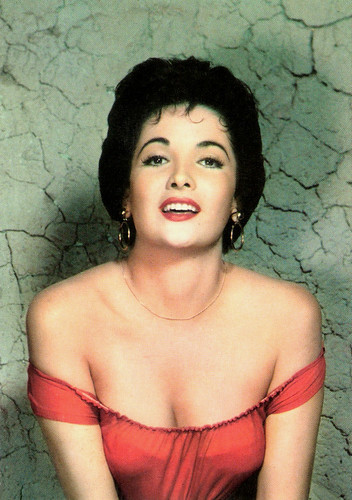
Italian postcard by Rotalcolor, Milano, no. 115.
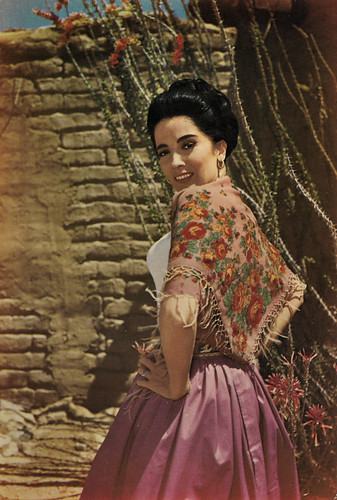
Dutch postcard. Linda Cristal as Victoria Cannon in the American TV series The High Chaparral (1967–1971).
New Star of the Year
Linda Cristal was born as Marta Victoria Moya Peggo in Buenos Aires, Argentina, in 1934. She was the daughter of a French father and an Italian mother. Her father was a publisher who moved the family to Montevideo, Uruguay, because of political problems.
In 1947, Linda and her parents were involved in a road accident near Buenos Aires in Argentina. She survived, but her parents were killed. Linda was 13 at the time. She had two brothers, but of them had died prematurely.
Her education came at Conservatoria Franklin in Uruguay. She learned to speak different languages, such as French, Spanish, Italian, and English.
In 1952, she was discovered by Mexican producer-director Miguelito Aleman, son of the Mexican president, Miguel Aleman. He gave her a bit part in the Mexican crime drama Cuando levanta la niebla/When the Fog Lifts (Emilio Fernández, 1952) starring Arturo de Córdova.
After she started her acting career. she altered her birth name to Linda Cristal. This was a common practice for actors and actresses in that period. In the following four years, Cristal did nine films in Argentina and Mexico for Aleman.
Her first English-language role was as Margarita in the Western Comanche (George Sherman, 1956) with Dana Andrews.
She won a Golden Globe Award for New Star of the Year for her part as Sandra Roca - the Argentine Bombshell in the romantic comedy The Perfect Furlough (Blake Edwards, 1958) with Tony Curtis and Janet Leigh.
Next, Cristal went on to roles in Cry Tough (Paul Stanley, 1959) with John Saxon , the Italian epic Le legioni di Cleopatra/Legions of the Nile (Vittorio Cottafavi, 1959), with Ettore Manni and Georges Marchal , and another Peplum La donna dei faraoni/The Pharaohs' Woman (Victor Tourjansky, 1960) opposite Pierre Brice .
John Wayne asked her to play the part of Flaca in his epic The Alamo (John Wayne, 1960), and then she had a key role in the Western Two Rode Together (John Ford, 1961) starring James Stewart and Richard Widmark.

Italian postcard, no. 640.
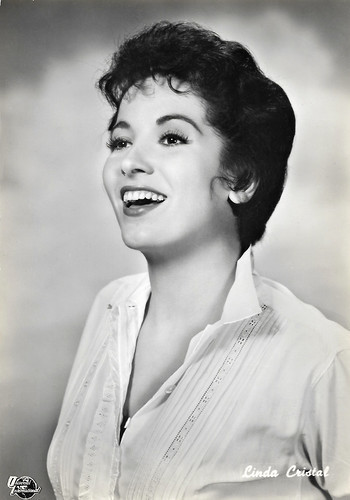
Italian postcard by Bromofoto, no. 1483. Photo: Universal International.
A female matador
Along with these and other film roles, Linda Cristal appeared in episodes of network television series. She played a kidnapped Countess opposite Eric Fleming and Clint Eastwood in an episode of Rawhide (1959).
On television, Cristal also played the female matador Gitana in an episode of The Tab Hunter Show (1961), and appeared in an episode of Voyage to the Bottom of the Sea (1964) with Richard Basehart and Dan Hedison.
Cristal semi-retired in 1964 to raise her two children. She was coaxed out of retirement when she became the last cast member to be added as a regular on the NBC series The High Chaparral (1967-1971), starring Leif Erickson and Cameron Mitchell. Her performance in the series, as Victoria Cannon, earned her two more Golden Globe nominations (winning Best Actress - Television Drama in 1968) and two Emmy Award nominations.
Cristal worked sparingly after The High Chaparral, with a few television and film roles, such as the film Mr. Majestyk (Richard Fleischer, 1974) starring Charles Bronson , and the television miniseries Condominium (Sidney Hayers, 1980) with Barbara Eden.
In 185 she returned to Argentina, where she appeared in the starring role of Victoria "Rossé" Wilson on the soap opera Rossé (Mario Bellocchio, 1985). Her last role was a guest part in an episode of the long-running American daytime drama General Hospital (1988).
Linda Cristal was married thrice. Cristal wed for the first time in 1950 to Tito Gomez, when she was just 16-years-old. The marriage was annulled after five days in the same year. In 1958, she married businessman Robert Champion, half-brother of dancer-actor Gower Champion. The secret wedding was made public only after a month. The marriage soon got bitter when Robert got a job in Venezuela, and the couple had to live far from each other most of the time. They divorced in 1959.
In 1960, she married Yale Wexler, a former actor who worked in real estate and was a multi-millionaire. The couple divorced in 1966. With Wexler, she had two sons, Gregory S. (1962) and Jordan R. (1963). Linda was granted custody of both her sons.
Linda Cristal passed away on 27 June 2020 in Beverly Hills, California.
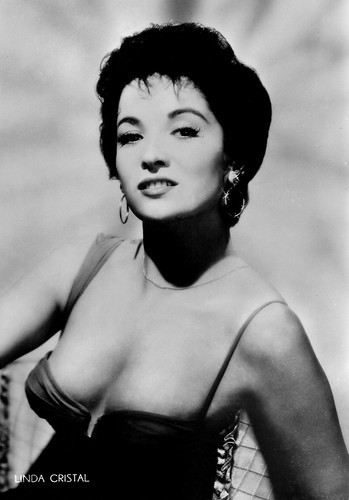
Italian postcard, no. 604. Photo: Universal, 1957.

Spanish postcard by Archivo Bermejo, no. C-35. Photo: Universal International.
Sources: Hans Beerekamp (Het Schimmenrijk - Dutch), Alchetron, Glamour Girls of the Silver Screen, Wikipedia and .

Italian postcard by Rotalcolor, Milano, no. 115.

Dutch postcard. Linda Cristal as Victoria Cannon in the American TV series The High Chaparral (1967–1971).
New Star of the Year
Linda Cristal was born as Marta Victoria Moya Peggo in Buenos Aires, Argentina, in 1934. She was the daughter of a French father and an Italian mother. Her father was a publisher who moved the family to Montevideo, Uruguay, because of political problems.
In 1947, Linda and her parents were involved in a road accident near Buenos Aires in Argentina. She survived, but her parents were killed. Linda was 13 at the time. She had two brothers, but of them had died prematurely.
Her education came at Conservatoria Franklin in Uruguay. She learned to speak different languages, such as French, Spanish, Italian, and English.
In 1952, she was discovered by Mexican producer-director Miguelito Aleman, son of the Mexican president, Miguel Aleman. He gave her a bit part in the Mexican crime drama Cuando levanta la niebla/When the Fog Lifts (Emilio Fernández, 1952) starring Arturo de Córdova.
After she started her acting career. she altered her birth name to Linda Cristal. This was a common practice for actors and actresses in that period. In the following four years, Cristal did nine films in Argentina and Mexico for Aleman.
Her first English-language role was as Margarita in the Western Comanche (George Sherman, 1956) with Dana Andrews.
She won a Golden Globe Award for New Star of the Year for her part as Sandra Roca - the Argentine Bombshell in the romantic comedy The Perfect Furlough (Blake Edwards, 1958) with Tony Curtis and Janet Leigh.
Next, Cristal went on to roles in Cry Tough (Paul Stanley, 1959) with John Saxon , the Italian epic Le legioni di Cleopatra/Legions of the Nile (Vittorio Cottafavi, 1959), with Ettore Manni and Georges Marchal , and another Peplum La donna dei faraoni/The Pharaohs' Woman (Victor Tourjansky, 1960) opposite Pierre Brice .
John Wayne asked her to play the part of Flaca in his epic The Alamo (John Wayne, 1960), and then she had a key role in the Western Two Rode Together (John Ford, 1961) starring James Stewart and Richard Widmark.

Italian postcard, no. 640.

Italian postcard by Bromofoto, no. 1483. Photo: Universal International.
A female matador
Along with these and other film roles, Linda Cristal appeared in episodes of network television series. She played a kidnapped Countess opposite Eric Fleming and Clint Eastwood in an episode of Rawhide (1959).
On television, Cristal also played the female matador Gitana in an episode of The Tab Hunter Show (1961), and appeared in an episode of Voyage to the Bottom of the Sea (1964) with Richard Basehart and Dan Hedison.
Cristal semi-retired in 1964 to raise her two children. She was coaxed out of retirement when she became the last cast member to be added as a regular on the NBC series The High Chaparral (1967-1971), starring Leif Erickson and Cameron Mitchell. Her performance in the series, as Victoria Cannon, earned her two more Golden Globe nominations (winning Best Actress - Television Drama in 1968) and two Emmy Award nominations.
Cristal worked sparingly after The High Chaparral, with a few television and film roles, such as the film Mr. Majestyk (Richard Fleischer, 1974) starring Charles Bronson , and the television miniseries Condominium (Sidney Hayers, 1980) with Barbara Eden.
In 185 she returned to Argentina, where she appeared in the starring role of Victoria "Rossé" Wilson on the soap opera Rossé (Mario Bellocchio, 1985). Her last role was a guest part in an episode of the long-running American daytime drama General Hospital (1988).
Linda Cristal was married thrice. Cristal wed for the first time in 1950 to Tito Gomez, when she was just 16-years-old. The marriage was annulled after five days in the same year. In 1958, she married businessman Robert Champion, half-brother of dancer-actor Gower Champion. The secret wedding was made public only after a month. The marriage soon got bitter when Robert got a job in Venezuela, and the couple had to live far from each other most of the time. They divorced in 1959.
In 1960, she married Yale Wexler, a former actor who worked in real estate and was a multi-millionaire. The couple divorced in 1966. With Wexler, she had two sons, Gregory S. (1962) and Jordan R. (1963). Linda was granted custody of both her sons.
Linda Cristal passed away on 27 June 2020 in Beverly Hills, California.

Italian postcard, no. 604. Photo: Universal, 1957.

Spanish postcard by Archivo Bermejo, no. C-35. Photo: Universal International.
Sources: Hans Beerekamp (Het Schimmenrijk - Dutch), Alchetron, Glamour Girls of the Silver Screen, Wikipedia and .
Published on June 26, 2020 22:00
Campari in the 1930s
Campari is a dark red-coloured aperitivo, introduced in Italy in the 1860s by Gaspare Campari. Under the direction of his son, David(e) Campari, the company began to export the bitter, first to France, then overseas. In the 1920s, a French postcard campaign with sepia portraits of stars of the French silent cinema photographed by G.L. Manuel Frères linked Campari to Paris. In the early 1930s, David did another Campari postcard campaign, this time with black and white star portraits by Studio Lorelle.
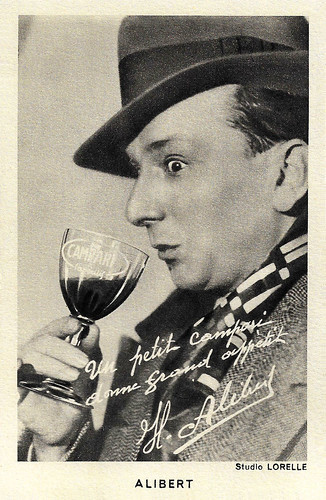
French postcard by David Campari, Paris. Photo: Studio Lorelle. Caption: Un petit Campari donne grand appètit (A small Campari gives great appetite.)
French singer, actor and librettist Henri Al(l)ibert (1889-1951), known as Alibert , was the Marseille singer par excellence. During the 1930s and 1940s, he starred in his own very popular operettas both on stage and on the screen.
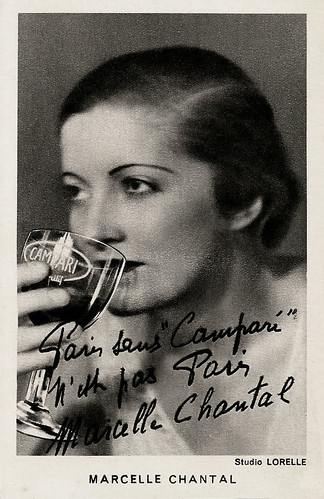
French postcard by David Campari, Paris. Photo: Studio Lorelle. Caption: Paris sans Campari, n'est pas Paris (Paris without Campari, is not Paris).
Marcelle Chantal (1901-1960) was a French socialite who became a film actress. She peaked in the early 1930s. Marcelle Chantal symbolised French elegance.
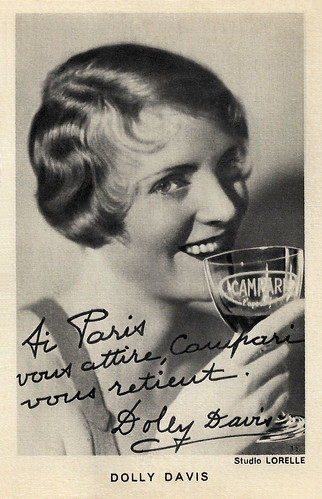
French postcard by David Campari, Paris. Photo: Studio Lorelle. Caption: Si Paris vous attire, Campari vous retient (If Paris attracts you, Campari retains you).
French actress Dolly Davis (1896-1962) was a very popular comédienne in the 1920s, who was often paired with her then companion André Roanne. They even starred together in a film simply called Dolly (Pierre Colombier, 1928).
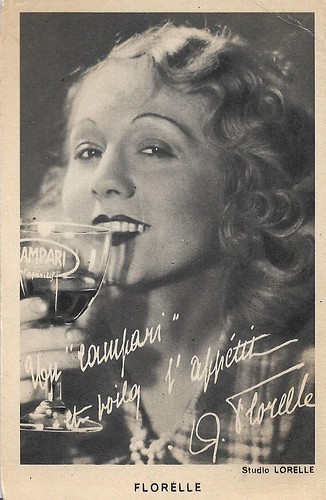
French postcard by David Campari, Paris. Photo: Studio Lorelle. Caption: Un Campari et voila l'appètit (A Campari and there's the appetite).
French music hall star Florelle (1898-1974) was one of the queens of Paris. The petite blonde appeared in 54 films between 1912 and 1956, and also toured around the world. Her most beautiful role was as Fantine in a classic version of Les Miserables (1934).
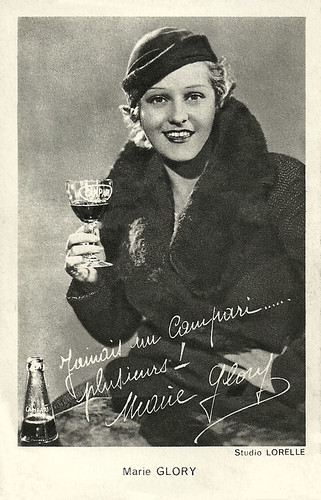
French postcard by David Campari, Paris. Photo: Studio Lorelle. Caption: J'aimais un Campari... plusieurs! (I liked a Campari... several!).
For a long time, French actress Marie Glory (1905-2009) was the longest living star of the French silent cinema, but in 2009 she died at the age of 103.
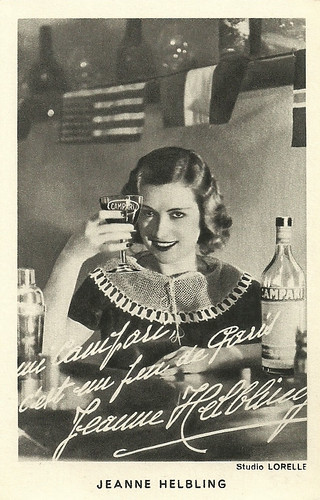
French postcard by David Campari, Paris. Photo: Studio Lorelle. Caption: Un Campari, c'est un peu de Paris. (A Campari is like a bit of Paris).
Jeanne Helbling was an actress of the French cinema of the 1920s and 1930s, who was extremely active in early French sound film. She was also a Resistance heroine.
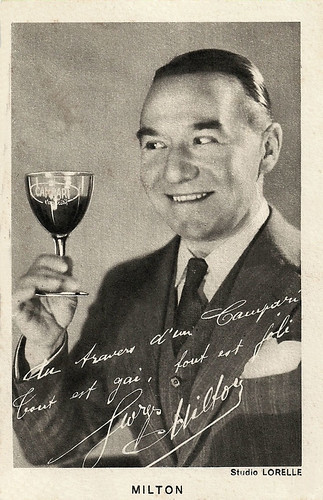
French postcard by David Campari, Paris. Photo: Studio Lorelle. Caption: Au travers d'un Campari, Tout est gai, tout est joli (With a Campari, all is gay, all is nice).
Georges Milton (1886-1970) was a French singer and actor, who peaked in French cinema of the 1930s as the character Bouboule.
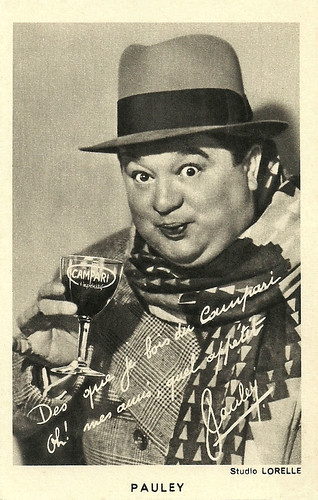
French postcard by David Campari, Paris. Photo: Studio Lorelle. Caption: Dès que je bois du Campari, Oh! mes amis, quel appetit! (Ever since I drink Campari, oh my friends, what an appetite!).
Pauley or Paul Pauley (1886-1938) was a French actor and singer, who knew a prolific career in French cinema of the 1930s.
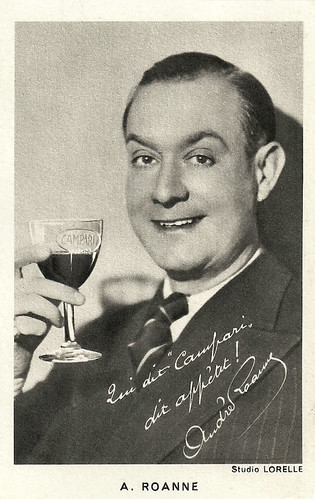
French postcard by David Campari, Paris. Photo: Studio Lorelle. Caption: Qui dit Campari, dit appétit! (Who says Campari, says appetite!).
André Roanne (1896-1959) had a long-standing career in French cinema. He peaked in the 1920s in comedies and dramas, often opposite Dolly Davis.
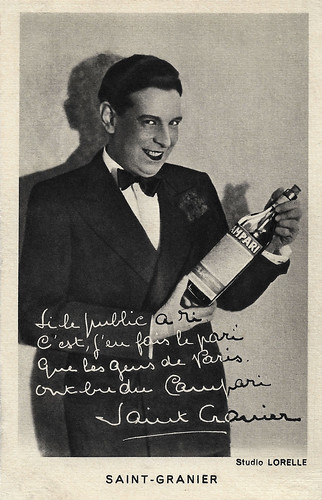
French postcard by David Campari, Paris. Photo: Studio Lorelle. Caption: Si le public a ri, c'est j'en fais le pari, que les gens de Paris, ont bu du Campari (If the public laughed, It is, I bet it, that the people of Paris drank Campari).
Saint-Granier (1890-1976) was a French journalist, singer, (song)writer, actor, director, and radio star. Between the two wars, he was one of the great personalities of the French cabaret. He was also the director of Paramount Pictures in France in the early 1930s.

French postcard by David Campari, Paris. Photo: Studio Lorelle. Caption: Un petit Campari donne grand appètit (A small Campari gives great appetite.)
French singer, actor and librettist Henri Al(l)ibert (1889-1951), known as Alibert , was the Marseille singer par excellence. During the 1930s and 1940s, he starred in his own very popular operettas both on stage and on the screen.

French postcard by David Campari, Paris. Photo: Studio Lorelle. Caption: Paris sans Campari, n'est pas Paris (Paris without Campari, is not Paris).
Marcelle Chantal (1901-1960) was a French socialite who became a film actress. She peaked in the early 1930s. Marcelle Chantal symbolised French elegance.

French postcard by David Campari, Paris. Photo: Studio Lorelle. Caption: Si Paris vous attire, Campari vous retient (If Paris attracts you, Campari retains you).
French actress Dolly Davis (1896-1962) was a very popular comédienne in the 1920s, who was often paired with her then companion André Roanne. They even starred together in a film simply called Dolly (Pierre Colombier, 1928).

French postcard by David Campari, Paris. Photo: Studio Lorelle. Caption: Un Campari et voila l'appètit (A Campari and there's the appetite).
French music hall star Florelle (1898-1974) was one of the queens of Paris. The petite blonde appeared in 54 films between 1912 and 1956, and also toured around the world. Her most beautiful role was as Fantine in a classic version of Les Miserables (1934).

French postcard by David Campari, Paris. Photo: Studio Lorelle. Caption: J'aimais un Campari... plusieurs! (I liked a Campari... several!).
For a long time, French actress Marie Glory (1905-2009) was the longest living star of the French silent cinema, but in 2009 she died at the age of 103.

French postcard by David Campari, Paris. Photo: Studio Lorelle. Caption: Un Campari, c'est un peu de Paris. (A Campari is like a bit of Paris).
Jeanne Helbling was an actress of the French cinema of the 1920s and 1930s, who was extremely active in early French sound film. She was also a Resistance heroine.

French postcard by David Campari, Paris. Photo: Studio Lorelle. Caption: Au travers d'un Campari, Tout est gai, tout est joli (With a Campari, all is gay, all is nice).
Georges Milton (1886-1970) was a French singer and actor, who peaked in French cinema of the 1930s as the character Bouboule.

French postcard by David Campari, Paris. Photo: Studio Lorelle. Caption: Dès que je bois du Campari, Oh! mes amis, quel appetit! (Ever since I drink Campari, oh my friends, what an appetite!).
Pauley or Paul Pauley (1886-1938) was a French actor and singer, who knew a prolific career in French cinema of the 1930s.

French postcard by David Campari, Paris. Photo: Studio Lorelle. Caption: Qui dit Campari, dit appétit! (Who says Campari, says appetite!).
André Roanne (1896-1959) had a long-standing career in French cinema. He peaked in the 1920s in comedies and dramas, often opposite Dolly Davis.

French postcard by David Campari, Paris. Photo: Studio Lorelle. Caption: Si le public a ri, c'est j'en fais le pari, que les gens de Paris, ont bu du Campari (If the public laughed, It is, I bet it, that the people of Paris drank Campari).
Saint-Granier (1890-1976) was a French journalist, singer, (song)writer, actor, director, and radio star. Between the two wars, he was one of the great personalities of the French cabaret. He was also the director of Paramount Pictures in France in the early 1930s.
Published on June 26, 2020 22:00
June 25, 2020
Brandon Lee
American actor and martial arts artist Brandon Lee (1965-1993) was more than the son of his famous father. His last film The Crow (1994), is remembered for his acting talent. During the shooting of the film, Brandon died by an accidental gunshot wound from a faulty prop revolver. In 2000, seven years after his death, he returned to the screen in a little Swedish film.
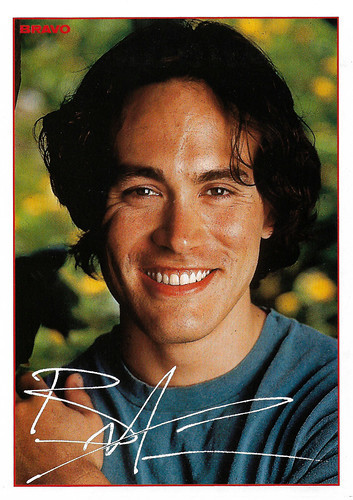
German collectors card by Bravo.
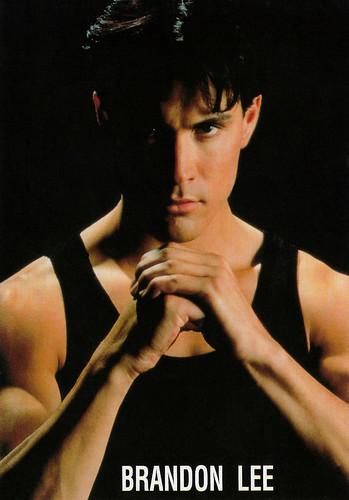
Italian postcard by World Collection, no. p.c. 418. Photo: Olympia. Brandon Lee in Rapid Fire (Dwight H. Little, 1992).
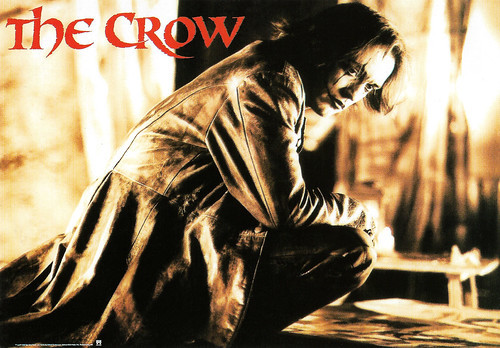
French postcard by Sonis, no. C. 709. Photo: TM and Bad Bird Productions Inc., 1996. Brandon Lee in The Crow (Alex Proyas, 1994).
Born on the last day of the dragon
Brandon Bruce Lee was born in Oakland, California, the USA in 1965 to Martial Arts idol and film star Bruce Lee and Linda Lee Cadwell, an American of Swedish heritage. He was born on Chinese New Year's eve, the last day of the dragon. Brandon had a sister, Shannon Lee, a future opera singer.
Brandon was born with blond hair. As he aged, his hair color changed to brown. By the time he was able to walk, he was already involved in learning about martial arts from his father. In 1970-1971, the family moved to Hong Kong, and at the age of 8, Brandon was fluent in Cantonese. After Bruce Lee's untimely death in 1973, Brandon, his mother, and his sister moved to Los Angeles.
He attended Boston's Art-Oriented Emerson College in Massachusetts and studied Martial Arts and drama, like his father. In 1983, he was expelled from school because of misbehaviour but received his diploma at Miraleste High School. Having chosen an acting career, Lee took his work seriously. He studied at the Strasberg Academy, with Eric Morris in New York and in Los Angeles, and in Lynette Katselas' class in Los Angeles.
His first professional job as an actor came at age twenty when casting director Lynn Stalmaster asked him to read for a CBS television film, Kung Fu: The Movie (Richard Lang, 1986) with David Carradine. It was a spin-off of the 1970s television series Kung Fu (1972-1975).
Lee's first role in a feature film was Long zai jiang hu/Legacy of Rage (Ronny Yu, 1986), Lee's first and only Hong Kong film, and spoken in Cantonese. Dee Reid at IMDb : "Brandon Lee is in fine form here (despite never hearing his natural speaking voice), though the film itself - written and directed by Hong Kong action veteran Ronny Yu (who would later gain fame in the West with the American horror films Bride of Chucky and Freddy vs. Jason, and the martial arts epic Fearless with Jet Li) - is somewhat of a mixed bag; it's more or less a standard action film, with lots of stuff about gangsters, drugs, and John Woo-style gun-play."
Shortly after, on television, Lee played a lead in the pilot Kung Fu: The Next Generation (Tony Wharmby, 1987), and guest-starred in an episode of the television series Ohara (1988) with Pat Morita. He also starred in the B-film Laser Mission (BJ Davis, 1989) with Ernest Borgnine. In Hollywood, Brandon Lee co-starred with Dolph Lundgren in the buddy cop action film Showdown in Little Tokyo (Mark L. Lester, 1991). They play two L.A. cops with opposing views on what is the best way to uphold the law have to work together to bring down the Yakuza while trying to protect a beautiful woman (Tia Carrere).
Next, he was in Rapid Fire (Dwight H. Little, 1992) with Powers Boothe. Lee also did the fight choreography. While some critics liked the film, most felt the script was too simple, however, almost all described Lee to be charismatic, in a slick Hollywood action film. Dee Reid at IMDb : "it was a showcase for his fighting talents. Rapid Fire is decent, certainly not perfect, but very fun to watch nonetheless." Lee turned down the offer to play his father in Dragon: The Bruce Lee Story (Rob Cohen, 1993). The role was later given to Jason Scott Lee.
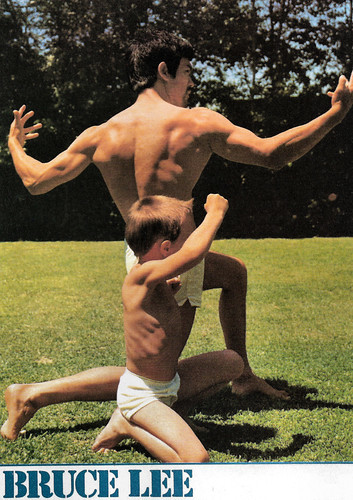
British postcard. Bruce and Brandon Lee.
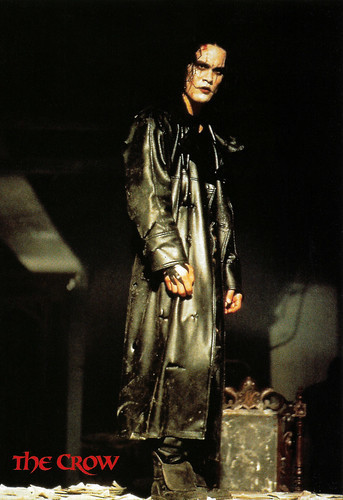
Dutch postcard by Film Freak Productions, Zoetermeer, no. FA 405 Photo: Crowvision Inc., 1994. Brandon Lee in The Crow (Alex Proyas, 1994).
His final and best film
In 1992, Brandon Lee landed his breakthrough role as Eric Draven in Alex Proyas' The Crow (1994), based on the comic book of the same name, which would be his final and best film. He died while filming at the age of 28, of what is to be believed, a brain hemorrhage on the set. The film crew shot a scene in which it was decided to use a gun without consent from the weapons coordinator, who had been sent home early that night.
Michael Massee, the actor portraying Funboy, was required to fire a .44 magnum revolver loaded with blanks at Lee. The revolver had been inspected days earlier for a previously filmed scene in which it was not fired but needed to be seen loaded. Dummy rounds are used for this, which have a bullet, a spent primer, but no powder. One of the dummy rounds had a bullet, a live primer, and no powder. When test-fired, the primer propelled the bullet into the barrel, where it stopped. The gun was then rechecked, but no anomalies were found because the primer was now spent and the barrel was not inspected. Then, when filming the fateful scene days later, the same gun was used with blanks. Blanks are fully charged rounds with no bullets, but there was a bullet in the barrel.
The blank round propelled it into Lee's abdomen just as if he had been shot with a live .44 magnum round. Michael Massee spent a year, devastated by what happened, deciding whether or not to return to acting. The crew only noticed when Lee was slow getting up. The doctors worked desperately for five hours, but it was no use. The bullet had lodged itself in Lee's lower spine. He was pronounced dead at 1:04 P.M. the next day.
He was supposed to marry Eliza Hutton on 17 April 1993. His body was flown to Seattle to be buried beside his father in Lake View Cemetery. Wikipedia : "With the blessing of Lee's family and very few scenes to shoot, the film was completed by re-writing the script, using early CGI technology, and stunt doubles. Released a year after, the film is known to present Mr. Lee's dramatic abilities, in which he had less of a chance to show in his previous films."
The Crow (Alex Proyas, 1994) was a commercial success and is now considered a cult classic. Upon release, the film received great critical acclaim and made $50 million at the box office and was also a success overseas. Many saw parallels between Lee and his father comparing their careers as action film leading men who passed young, prior to the release of their breakthrough film, with the difference that his father demonstrated high martial arts skills, while Lee showed a strong dramatic performance.
In 2000, a new film with Lee was released, the Swedish production Sex, lögner & videovåld/Sex, Lies and Video Violence (Richard Holm, 2000). In 1992 Brandon Lee had come to Sweden to promote Rapid Fire (1992). His host, director Richard Holm, asked Lee to make a cameo appearance in this film, and he gladly agreed. The film was shot over an extended period between 1990 to 1993, but for different reasons delayed over and over again in post-production. Finally released in 2000, seven years after Lee's death, the film was dedicated to him, in the last line in the end credits.
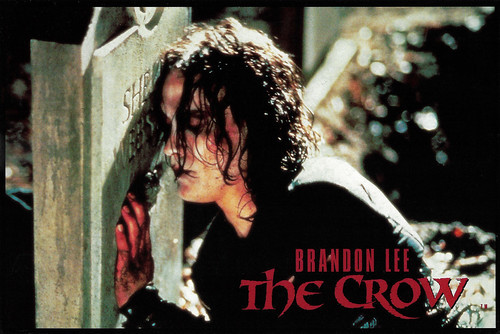
British postcard by London Postcard Company, no. PR 755 (Series 1 set of 6). Photo: TM and Crowvision Inc., 1996. Brandon Lee in The Crow (Alex Proyas, 1994). Caption: Graveside.
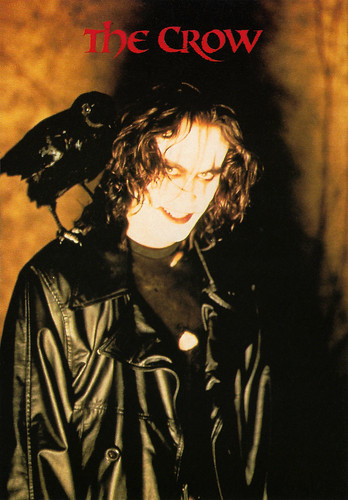
French postcard by Sonis, no. C. 491. Photo: TM and Crowvision, 1994. Brandon Lee in The Crow (Alex Proyas, 1994).
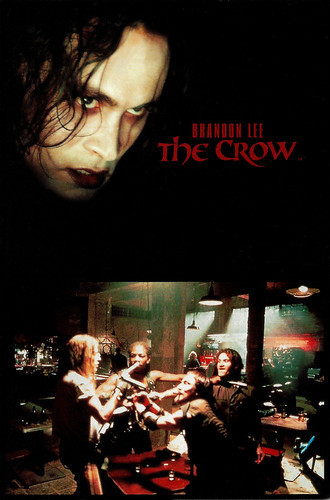
British postcard by London Postcard Company, no. PR 756 (Series 1 set of 6) Collage 2. Photo: TM and Crowvision, 1996. Brandon Lee in The Crow (Alex Proyas, 1994).
Sources: (IMDb), Dee Reid (IMDb), Wikipedia, and .

German collectors card by Bravo.

Italian postcard by World Collection, no. p.c. 418. Photo: Olympia. Brandon Lee in Rapid Fire (Dwight H. Little, 1992).

French postcard by Sonis, no. C. 709. Photo: TM and Bad Bird Productions Inc., 1996. Brandon Lee in The Crow (Alex Proyas, 1994).
Born on the last day of the dragon
Brandon Bruce Lee was born in Oakland, California, the USA in 1965 to Martial Arts idol and film star Bruce Lee and Linda Lee Cadwell, an American of Swedish heritage. He was born on Chinese New Year's eve, the last day of the dragon. Brandon had a sister, Shannon Lee, a future opera singer.
Brandon was born with blond hair. As he aged, his hair color changed to brown. By the time he was able to walk, he was already involved in learning about martial arts from his father. In 1970-1971, the family moved to Hong Kong, and at the age of 8, Brandon was fluent in Cantonese. After Bruce Lee's untimely death in 1973, Brandon, his mother, and his sister moved to Los Angeles.
He attended Boston's Art-Oriented Emerson College in Massachusetts and studied Martial Arts and drama, like his father. In 1983, he was expelled from school because of misbehaviour but received his diploma at Miraleste High School. Having chosen an acting career, Lee took his work seriously. He studied at the Strasberg Academy, with Eric Morris in New York and in Los Angeles, and in Lynette Katselas' class in Los Angeles.
His first professional job as an actor came at age twenty when casting director Lynn Stalmaster asked him to read for a CBS television film, Kung Fu: The Movie (Richard Lang, 1986) with David Carradine. It was a spin-off of the 1970s television series Kung Fu (1972-1975).
Lee's first role in a feature film was Long zai jiang hu/Legacy of Rage (Ronny Yu, 1986), Lee's first and only Hong Kong film, and spoken in Cantonese. Dee Reid at IMDb : "Brandon Lee is in fine form here (despite never hearing his natural speaking voice), though the film itself - written and directed by Hong Kong action veteran Ronny Yu (who would later gain fame in the West with the American horror films Bride of Chucky and Freddy vs. Jason, and the martial arts epic Fearless with Jet Li) - is somewhat of a mixed bag; it's more or less a standard action film, with lots of stuff about gangsters, drugs, and John Woo-style gun-play."
Shortly after, on television, Lee played a lead in the pilot Kung Fu: The Next Generation (Tony Wharmby, 1987), and guest-starred in an episode of the television series Ohara (1988) with Pat Morita. He also starred in the B-film Laser Mission (BJ Davis, 1989) with Ernest Borgnine. In Hollywood, Brandon Lee co-starred with Dolph Lundgren in the buddy cop action film Showdown in Little Tokyo (Mark L. Lester, 1991). They play two L.A. cops with opposing views on what is the best way to uphold the law have to work together to bring down the Yakuza while trying to protect a beautiful woman (Tia Carrere).
Next, he was in Rapid Fire (Dwight H. Little, 1992) with Powers Boothe. Lee also did the fight choreography. While some critics liked the film, most felt the script was too simple, however, almost all described Lee to be charismatic, in a slick Hollywood action film. Dee Reid at IMDb : "it was a showcase for his fighting talents. Rapid Fire is decent, certainly not perfect, but very fun to watch nonetheless." Lee turned down the offer to play his father in Dragon: The Bruce Lee Story (Rob Cohen, 1993). The role was later given to Jason Scott Lee.

British postcard. Bruce and Brandon Lee.

Dutch postcard by Film Freak Productions, Zoetermeer, no. FA 405 Photo: Crowvision Inc., 1994. Brandon Lee in The Crow (Alex Proyas, 1994).
His final and best film
In 1992, Brandon Lee landed his breakthrough role as Eric Draven in Alex Proyas' The Crow (1994), based on the comic book of the same name, which would be his final and best film. He died while filming at the age of 28, of what is to be believed, a brain hemorrhage on the set. The film crew shot a scene in which it was decided to use a gun without consent from the weapons coordinator, who had been sent home early that night.
Michael Massee, the actor portraying Funboy, was required to fire a .44 magnum revolver loaded with blanks at Lee. The revolver had been inspected days earlier for a previously filmed scene in which it was not fired but needed to be seen loaded. Dummy rounds are used for this, which have a bullet, a spent primer, but no powder. One of the dummy rounds had a bullet, a live primer, and no powder. When test-fired, the primer propelled the bullet into the barrel, where it stopped. The gun was then rechecked, but no anomalies were found because the primer was now spent and the barrel was not inspected. Then, when filming the fateful scene days later, the same gun was used with blanks. Blanks are fully charged rounds with no bullets, but there was a bullet in the barrel.
The blank round propelled it into Lee's abdomen just as if he had been shot with a live .44 magnum round. Michael Massee spent a year, devastated by what happened, deciding whether or not to return to acting. The crew only noticed when Lee was slow getting up. The doctors worked desperately for five hours, but it was no use. The bullet had lodged itself in Lee's lower spine. He was pronounced dead at 1:04 P.M. the next day.
He was supposed to marry Eliza Hutton on 17 April 1993. His body was flown to Seattle to be buried beside his father in Lake View Cemetery. Wikipedia : "With the blessing of Lee's family and very few scenes to shoot, the film was completed by re-writing the script, using early CGI technology, and stunt doubles. Released a year after, the film is known to present Mr. Lee's dramatic abilities, in which he had less of a chance to show in his previous films."
The Crow (Alex Proyas, 1994) was a commercial success and is now considered a cult classic. Upon release, the film received great critical acclaim and made $50 million at the box office and was also a success overseas. Many saw parallels between Lee and his father comparing their careers as action film leading men who passed young, prior to the release of their breakthrough film, with the difference that his father demonstrated high martial arts skills, while Lee showed a strong dramatic performance.
In 2000, a new film with Lee was released, the Swedish production Sex, lögner & videovåld/Sex, Lies and Video Violence (Richard Holm, 2000). In 1992 Brandon Lee had come to Sweden to promote Rapid Fire (1992). His host, director Richard Holm, asked Lee to make a cameo appearance in this film, and he gladly agreed. The film was shot over an extended period between 1990 to 1993, but for different reasons delayed over and over again in post-production. Finally released in 2000, seven years after Lee's death, the film was dedicated to him, in the last line in the end credits.

British postcard by London Postcard Company, no. PR 755 (Series 1 set of 6). Photo: TM and Crowvision Inc., 1996. Brandon Lee in The Crow (Alex Proyas, 1994). Caption: Graveside.

French postcard by Sonis, no. C. 491. Photo: TM and Crowvision, 1994. Brandon Lee in The Crow (Alex Proyas, 1994).

British postcard by London Postcard Company, no. PR 756 (Series 1 set of 6) Collage 2. Photo: TM and Crowvision, 1996. Brandon Lee in The Crow (Alex Proyas, 1994).
Sources: (IMDb), Dee Reid (IMDb), Wikipedia, and .
Published on June 25, 2020 22:00
June 24, 2020
Photo by George Hurrell
American photographer George Hurrell (1904-1992) was a major contributor to the image of glamour presented by Hollywood during the 1930s and 1940s. Always an innovator, he invented the boom light and developed several - now standard - lighting techniques. Hurrell’s signature use of precision lighting, spotlights, shadows, and hand-retouching on the negatives produced romantic portraits that became his trademark style. His influential look became known as the 'Hurrell style'.
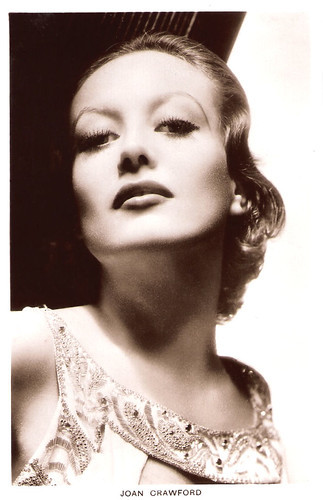
Joan Crawford . Vintage postcard. Photo: George Hurrell, 1932.
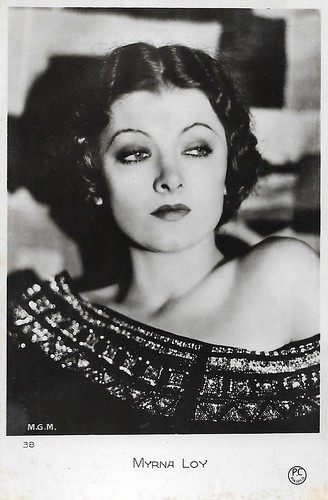
Myna Loy. French postcard by P.C., Paris, no. 38. Photo: George Hurrell, 1932 / MGM (Metro-Goldwyn-Mayer).
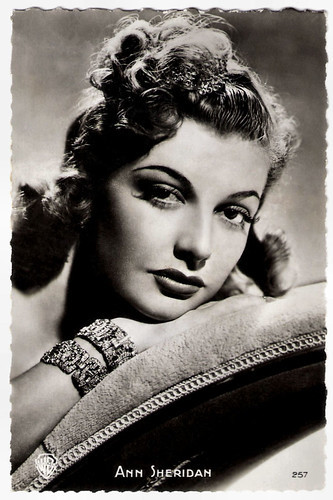
Ann Sheridan. French postcard by Editions P.I., no. 257. Photo: George Hurrell / Warner Bros.
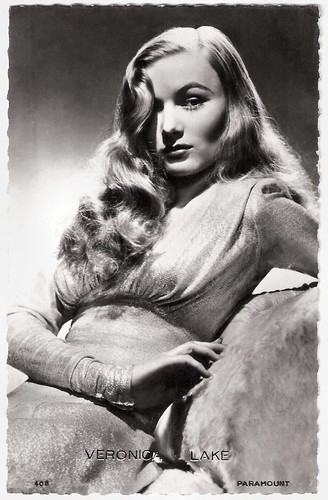
French postcard by Editions P.I., Paris, no. 408, 1952. Photo: George Hurrell / Paramount. Veronica Lake in This Gun for Hire (Frank Tuttle, 1942).
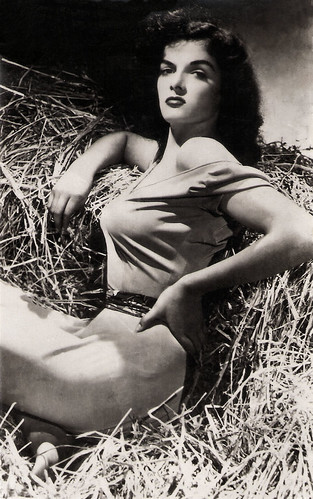
Vintage postcard. Photo: George Hurrell. Jane Russell in The Outlaw (Howard Hughes, 1943).
Convincing Irving Thalberg that his wife could be sexy in THAT way
George Edward Hurrell was born in 1904 in Cincinnati, Ohio, in a large Catholic family. His parents, Edward Hurrell and his wife Anna Mary Eble had five sons and one daughter. His father worked in the shoe business. In 1909, the family moved to Chicago to open their own shoe factory.
An altar boy during his youth, upon reflecting on what his own career path might be, a young George Hurrell initially signed up at the Quigley Seminary in Chicago to become a priest but decided to go to art school instead. Following graduation from high school, he enrolled at the Chicago Art Institute and later took night school classes at the Academy of Fine Arts studying painting.
Hurrell became acquainted with the camera while in art school because students typically photographed various indoor and outdoor scenes to use as a reference while painting. In 1923, the famous Chicago portrait photographer Eugene Hutchinson asked Hurrell to join him as an assistant in his studio in the Fine Arts Building on Michigan Avenue. This was the beginning of Hurrell’s interest in studio portrait work.
In 1925, while still attending the Art Institute, Hurrell heard that famed landscape painter, Edgar Alwyn Payne, an alum of the Art Institute, would be giving a lecture at the school. Hurrell attended the lecture, and afterward Payne viewed the student’s work. Payne was particularly impressed with Hurrell's’ experimental painting style, and also liked a recently completed landscape painting. Payne invited him to come with him to Laguna Beach, which was then a famous art colony. Hurrell eagerly accepted the opportunity and celebrated his 21st birthday at Laguna Beach.
Through the intervention of Payne and his wife, Elsie Payne, Hurrell moved into a vacant but completely furnished hillside shack owned by silent film director, Mal St. Clair, and lived rent-free in exchange for keeping an eye on the place. Hurrell studied painting with William Wendt, who became Hurrell’s mentor and closest friend. Hurrell focused on painting but also conducted photographic experiments with sunlight with his second-hand view camera from Chicago. Hurrell soon discovered that taking pictures of local artists and the social scene paid much more readily than painting.
In 1925, he met Florence Leontine Lowe Barnes (the later Pancho Barnes), three years his senior and very rich. The two became fast friends. Hurrell became a frequent pool-side guest at Dos Rocas, Barnes’ 40-acre estate on the bluffs of Laguna Beach. There Hurrell met her society friends, including her best friend Ramon Novarro , at the time the most famous and the highest-paid movie star in the world.
George Hurrell moved to Los Angeles and opened his first photography studio at a live-work artists loft at LaFayette Park Place. His friend Leon Gordon arranged for Hurrell to meet Edward Steichen and he was asked to develop and print some negatives. When Steichen saw the results, he encouraged Hurrell to pursue his photographic career.
In 1929, Ramon Novarro , who was of Mexican heritage, was worried that he might not make the transition to sound film because of his slight accent. However, he had a wonderful operatic voice and was thinking about an opera career. He needed some publicity photos for which he could not use the usual Hollywood photographers. At Pancho Barnes’s urging, Novarro had a series of photographs taken by George Hurrell.
Novarro showed the photos that Hurrell took of him to his best friend back at MGM, Norma Shearer who was having problems of a different sort. She was married to the head of production at MGM, Irving Thalberg. Norma wanted to play a sexy vamp in the film The Divorcee (Robert Z. Leonard, 1930), but, up until that time, she was known for her 'all-American girl next door' image. When she showed the script to her husband, he replied “Honey, I don’t think this part is for you. You are not sexy in THAT way.”
After seeing Hurrell's photos of Novarro, she decided to have some photos taken by Hurrell so that she could convince her husband that she was indeed sexy in THAT way. Hurrell's photos convinced her husband, Norma Shearer got the film role and their marriage improved. Shearer won the Academy Award for Best Actress as a result of her portrayal in that film, and Hurrell was offered a job as a portrait photographer at MGM. At first, he hesitated, but when in late October 1929 the stock market crashed, Pancho encouraged her friend to take the job and flew Hurrell from her home’s private landing strip in Laguna Beach to the MGM meeting in her Travel Air biplane, and George famously wing-walked on her plane on the way up. In Hollywood, Hurrell accepted the job.
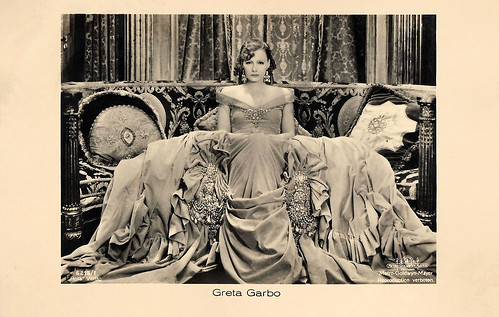
German postcard by Ross Verlag, no. 6215/1, 1931-1932. Photo: George Hurrell / MGM (Metro-Goldwyn-Mayer). Greta Garbo in an over-the-top dress by Adrian in Romance (Clarence Brown, 1930). Set by Cedric Gibbons.
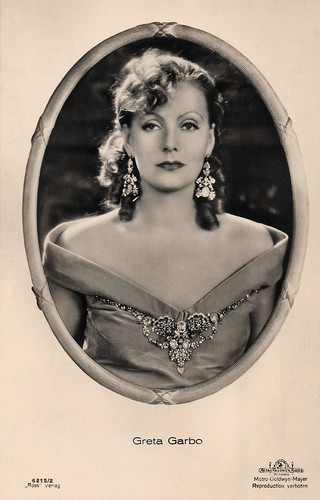
German postcard by Ross Verlag, no. 6215/2, 1931-1932. Photo: George Hurrell / MGM (Metro-Goldwyn-Mayer). Greta Garbo in Romance (Clarence Brown, 1930).
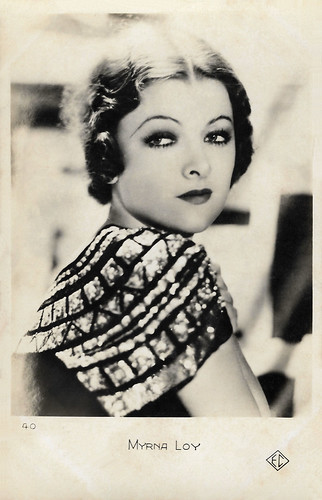
Myrna Loy. French postcard by Editions Chantal (EC), no. 40. Photo: George Hurrell / MGM (Metro-Goldwyn-Mayer), 1932.
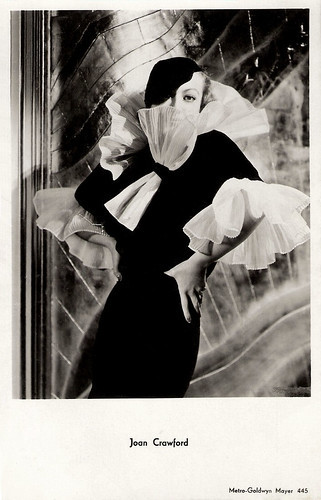
Joan Crawford . Dutch postcard by H.A.T.E., Rotterdam, no. 445, sent by mail in the Netherlands in 1934. Photo: George Hurrell / MGM (Metro-Goldwyn-Mayer).
The session with Greta Garbo that did not go well
On 1 January 1930, George Hurrell began to work as the head portrait photographer for MGM Studios. His first assignment was to shoot starlet Harriet Lake, who later became known as Ann Sothern. His first Hollywood star was Lon Chaney . At that time, Hurrell developed his superb talent for entertaining and relaxing the stars with jazz music, acrobatics, and other activities during their day-long photo sessions. Among the MGM stars regularly photographed by him during these years were silent screen star Dorothy Jordan, Myrna Loy , Robert Montgomery, Jean Harlow , Joan Crawford , Clark Gable, Rosalind Russell, Marion Davies , Jeanette MacDonald, Lupe Velez, Anna May Wong , and Carole Lombard.
His striking black-and-white images were used extensively in the marketing of these stars. Hurrell also photographed Greta Garbo at a session to produce promotional material for Romance. The session didn't go well and she never used him again. In 1932, he left MGM, after a blow-up with Howard Strickling, the head of publicity for Metro-Goldwyn-Mayer, for photographing non-MGM stars on the weekend. In October 1932 Hurrell opened a photographic studio at Sunset Blvd., where he shot freelance for all the major studios, including MGM, till 1938.
In 1938, he closed the Hurrell Photography studio on Sunset Blvd and accepted an exclusive contract with Warner Bros. as a head portrait photographer. He photographed among others Bette Davis , Ann Sheridan, Errol Flynn , Olivia de Havilland , Ida Lupino , Alexis Smith, Lauren Bacall, Humphrey Bogart, and James Cagney. He also became a regular contributor to Esquire magazine. As a result of Warner Bros. publicity and his monthly exposure in Esquire, Hurrell became a household name. Several magazine articles appeared featuring stories about George Hurrell and his photography. In 1939, he met and married his first wife, Katherine Cuddy, who was a beauty contest winner from Seattle. They divorced in 1942.
In 1940, he resigned at Warner Bros. Studios, and in 1941 he completed the build-out of his custom photography studio at 333 Rodeo Drive, Beverly Hills. Greta Garbo was his landlady. He also started accepting assignments in New York, leasing studio space for several months at the Waldorf Astoria in New York City.
In 1942 and 1943, he was a gallery photographer for Columbia Studios. Here his photographs were used to help the studio build the career of Rita Hayworth . In November 1942, Hurrell was drafted, but with the help of Pancho Barnes, who was close friends with General Hap Arnold, he was assigned to the First Motion Picture Unit of the U.S. Army Air Force in Culver City, California. He made training films at Hal Roach Studios in Culver City and later became a staff photographer at the Pentagon. In 1943, he was discharged from armed services.
He re-opened his Rodeo Drive studio in Beverly Hills in October. He also married his second wife, Phyllis Bounds, a niece of Walt Disney . They had three children, Clancy, Victoria, and Alexandra. After the war, he started commercial work for J. Walter Thompson Agency in advertising. He shot several advertising accounts using the experimental and immensely expensive tri-color carbro color process, developed and printed by Paul Outerbridge. Hurrell and his second wife, Phyllis, divorced in 1954.
In 1955, he returned to Beverly Hills and reopened the Rodeo Drive studio. His old style of glamour had fallen from favour. Where he had worked hard to create an idealised image of his subjects, the new style of Hollywood glamour was more earthy and gritty, and for the first time in his career, Hurrell's style was not in demand. Then he met his soul mate and third wife, Betty Willis. They had three children, George Jr., Daphne, and Michael. In 1958, he formed a partnership with Walt Disney in Hollywood and created Hurrell Productions, a production company for educational films and TV commercials, which was housed on The Walt Disney Studios lot in Burbank. He served as a producer, director, and occasionally as a cinematographer.
He disbanded Hurrell Productions in 1960 and began to work as a stills photographer for various TV shows using 35mm format cameras. Hurrell shot for Gunsmoke and the Danny Thomas Show among others. In 1965, his photography was included in the exhibition, 'Glamour Portraits' at the Museum of Modern Art in New York.
From 1969 till 1976, he worked as a freelance stills photographer on various films including Planet Of The Apes (Franklin J. Schaffner, 1968), Butch Cassidy and the Sundance Kid (George Roy Hill, 1969), The Towering Inferno (John Guillermin, 1974), and All the President’s Men (Alan J. Pakula, 1976). After 1970, his most prominent work was as a photographer for album covers. He shot the cover photos for Cass Elliot's self-titled album (1972), Tom Waits' 'Foreign Affairs' (1977), Fleetwood Mac's 'Mirage' (1982), Queen's 'The Works' (1984), Midge Ure's 'The Gift' (1985) and Paul McCartney 's 'Press to Play' (1986).
From 1976 on, he was semi-retired but accepted occasional portrait assignments that kept him active for such clients as Liza Minnelli, Paul Newman, and Robert Redford. His work was exhibited in 'Dream For Sale' (1976) at the Municipal Art Museum, Los Angeles. The book,'The Hurrell Style' was published by the John Day Company.
In 1980, Hurrell started to set auction records for his vintage photographs from the 1930s. 'Hurrell Portfolio I, limited editions' was published. Prints from the edition quickly realised $1,100 – $1,300 at various auction houses. Hurrell's work was also featured in the book by John Kobal, 'The Art Of The Great Hollywood Photographers, 1925-1940'. A circa 1930, 9 x 12” print of Ramon Novarro as the 'New Orpheus' is auctioned for $9,000 at Christie’s East, N.Y, setting a record price for a portrait by a living photographer in 1981. The photograph was accepted into the permanent collection of the Metropolitan Museum, New York.
His friend and fellow photographer Helmut Newton came up with the idea to invite George Hurrell to photograph the Paris collections for the March 1983 edition of Vogue Paris. Hurrell shot 40 pages in black and white and color within the tight 10-day schedule. Hurrell’s work was featured in the exhibition 'The Hollywood Portrait Photographers, 1921-1941' at the Museum of Modern Art, New York.
He continued with freelance portraiture for magazines photographing Farrah Fawcett, Bette Midler, Brooke Shields, John Travolta, and other New Hollywood stars. His work was exhibited in the show 'The Art of the Great Hollywood Photographers' (1983) at the National Portrait Gallery in Washington, D.C. The following year his photography was included in the Smithsonian‘s touring exhibition 'The Great Hollywood Portrait Photographers'.
In 1984, he also shot Joan Collins nude for Playboy magazine. His 1930s photographs appeared in the exhibition, 'Masters of Starlight’ at the Los Angeles County Museum of Art. And in 1991, 'The Book of Stars' by George Hurrell was published by Schirmer Art Books, featuring photographs from 1928 till 1990.
In 1992, George Hurrell passed away in Cedars Sinai Hospital, from his long-standing problems with bladder cancer. He was 87. He had just finished narration on 'Legends In Light' (1992), a TBS documentary about his life. Since his death, his works have continued to appreciate in value and examples of his artistic output can be found in the permanent collections of numerous museums around the world.
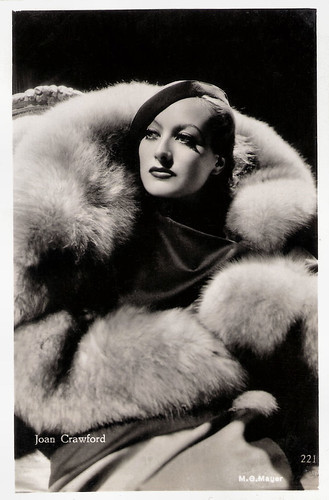
Joan Crawford . Dutch postcard by JosPe, no. 221. Photo: George Hurrell / MGM (Metro-Goldwyn-Mayer).
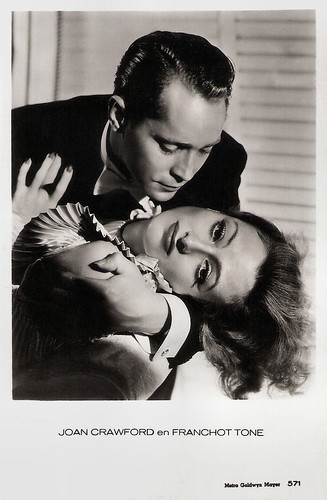
Dutch postcard, no. 571. Photo: George Hurrell / MGM (Metro-Goldwyn-Mayer). Joan Crawford and Franchot Tone in Dancing Lady (Robert Z. Leonard, 1933).
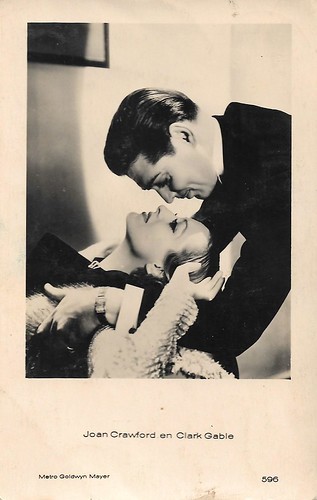
Dutch postcard, no. 596. Photo: George Hurrell / MGM (Metro-Goldwyn-Mayer). Joan Crawford and Clark Gable in Dancing Lady (Robert Z. Leonard, 1933).
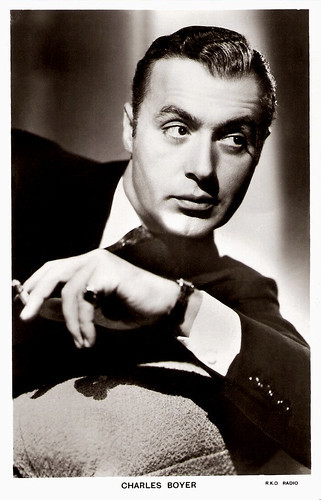
Charles Boyer . British postcard in the Picturegoer Series, London, no. 1258. Photo: George Hurrell / RKO Radio.
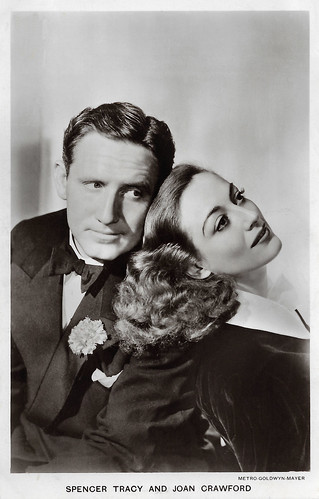
British postcard in the Film Partners Series, London, no. P 230. Photo: George Hurrell / MGM (Metro-Goldwyn-Mayer). Spencer Tracy and Joan Crawford in Mannequin (Frank Borzage, 1937).
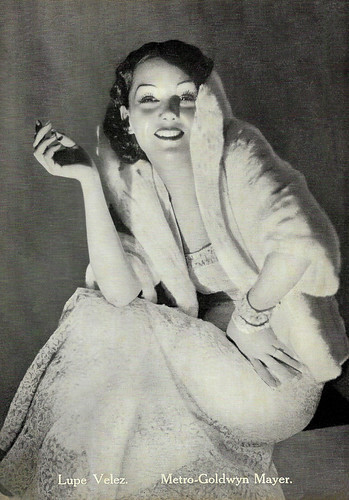
Lupe Velez. Dutch postcard by Smeets & Schippers, Amsterdam. Photo: George Hurrell / MGM (Metro-Goldwyn-Mayer).
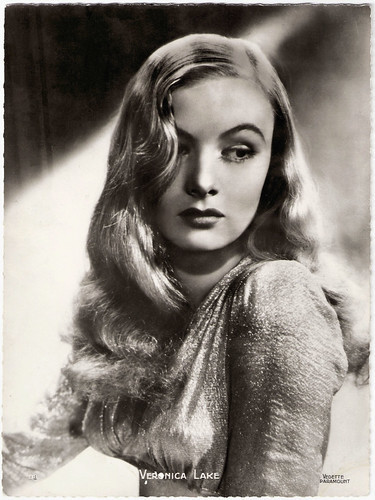
Big Belgian card by Chocolaterie Clovis, Pepinster. Photo: George Hurrell / Paramount. Veronica Lake in This Gun for Hire (Frank Tuttle, 1942).
Sources: George Hurrell.com, Walt Disney.org, and Wikipedia.

Joan Crawford . Vintage postcard. Photo: George Hurrell, 1932.

Myna Loy. French postcard by P.C., Paris, no. 38. Photo: George Hurrell, 1932 / MGM (Metro-Goldwyn-Mayer).

Ann Sheridan. French postcard by Editions P.I., no. 257. Photo: George Hurrell / Warner Bros.

French postcard by Editions P.I., Paris, no. 408, 1952. Photo: George Hurrell / Paramount. Veronica Lake in This Gun for Hire (Frank Tuttle, 1942).

Vintage postcard. Photo: George Hurrell. Jane Russell in The Outlaw (Howard Hughes, 1943).
Convincing Irving Thalberg that his wife could be sexy in THAT way
George Edward Hurrell was born in 1904 in Cincinnati, Ohio, in a large Catholic family. His parents, Edward Hurrell and his wife Anna Mary Eble had five sons and one daughter. His father worked in the shoe business. In 1909, the family moved to Chicago to open their own shoe factory.
An altar boy during his youth, upon reflecting on what his own career path might be, a young George Hurrell initially signed up at the Quigley Seminary in Chicago to become a priest but decided to go to art school instead. Following graduation from high school, he enrolled at the Chicago Art Institute and later took night school classes at the Academy of Fine Arts studying painting.
Hurrell became acquainted with the camera while in art school because students typically photographed various indoor and outdoor scenes to use as a reference while painting. In 1923, the famous Chicago portrait photographer Eugene Hutchinson asked Hurrell to join him as an assistant in his studio in the Fine Arts Building on Michigan Avenue. This was the beginning of Hurrell’s interest in studio portrait work.
In 1925, while still attending the Art Institute, Hurrell heard that famed landscape painter, Edgar Alwyn Payne, an alum of the Art Institute, would be giving a lecture at the school. Hurrell attended the lecture, and afterward Payne viewed the student’s work. Payne was particularly impressed with Hurrell's’ experimental painting style, and also liked a recently completed landscape painting. Payne invited him to come with him to Laguna Beach, which was then a famous art colony. Hurrell eagerly accepted the opportunity and celebrated his 21st birthday at Laguna Beach.
Through the intervention of Payne and his wife, Elsie Payne, Hurrell moved into a vacant but completely furnished hillside shack owned by silent film director, Mal St. Clair, and lived rent-free in exchange for keeping an eye on the place. Hurrell studied painting with William Wendt, who became Hurrell’s mentor and closest friend. Hurrell focused on painting but also conducted photographic experiments with sunlight with his second-hand view camera from Chicago. Hurrell soon discovered that taking pictures of local artists and the social scene paid much more readily than painting.
In 1925, he met Florence Leontine Lowe Barnes (the later Pancho Barnes), three years his senior and very rich. The two became fast friends. Hurrell became a frequent pool-side guest at Dos Rocas, Barnes’ 40-acre estate on the bluffs of Laguna Beach. There Hurrell met her society friends, including her best friend Ramon Novarro , at the time the most famous and the highest-paid movie star in the world.
George Hurrell moved to Los Angeles and opened his first photography studio at a live-work artists loft at LaFayette Park Place. His friend Leon Gordon arranged for Hurrell to meet Edward Steichen and he was asked to develop and print some negatives. When Steichen saw the results, he encouraged Hurrell to pursue his photographic career.
In 1929, Ramon Novarro , who was of Mexican heritage, was worried that he might not make the transition to sound film because of his slight accent. However, he had a wonderful operatic voice and was thinking about an opera career. He needed some publicity photos for which he could not use the usual Hollywood photographers. At Pancho Barnes’s urging, Novarro had a series of photographs taken by George Hurrell.
Novarro showed the photos that Hurrell took of him to his best friend back at MGM, Norma Shearer who was having problems of a different sort. She was married to the head of production at MGM, Irving Thalberg. Norma wanted to play a sexy vamp in the film The Divorcee (Robert Z. Leonard, 1930), but, up until that time, she was known for her 'all-American girl next door' image. When she showed the script to her husband, he replied “Honey, I don’t think this part is for you. You are not sexy in THAT way.”
After seeing Hurrell's photos of Novarro, she decided to have some photos taken by Hurrell so that she could convince her husband that she was indeed sexy in THAT way. Hurrell's photos convinced her husband, Norma Shearer got the film role and their marriage improved. Shearer won the Academy Award for Best Actress as a result of her portrayal in that film, and Hurrell was offered a job as a portrait photographer at MGM. At first, he hesitated, but when in late October 1929 the stock market crashed, Pancho encouraged her friend to take the job and flew Hurrell from her home’s private landing strip in Laguna Beach to the MGM meeting in her Travel Air biplane, and George famously wing-walked on her plane on the way up. In Hollywood, Hurrell accepted the job.

German postcard by Ross Verlag, no. 6215/1, 1931-1932. Photo: George Hurrell / MGM (Metro-Goldwyn-Mayer). Greta Garbo in an over-the-top dress by Adrian in Romance (Clarence Brown, 1930). Set by Cedric Gibbons.

German postcard by Ross Verlag, no. 6215/2, 1931-1932. Photo: George Hurrell / MGM (Metro-Goldwyn-Mayer). Greta Garbo in Romance (Clarence Brown, 1930).

Myrna Loy. French postcard by Editions Chantal (EC), no. 40. Photo: George Hurrell / MGM (Metro-Goldwyn-Mayer), 1932.

Joan Crawford . Dutch postcard by H.A.T.E., Rotterdam, no. 445, sent by mail in the Netherlands in 1934. Photo: George Hurrell / MGM (Metro-Goldwyn-Mayer).
The session with Greta Garbo that did not go well
On 1 January 1930, George Hurrell began to work as the head portrait photographer for MGM Studios. His first assignment was to shoot starlet Harriet Lake, who later became known as Ann Sothern. His first Hollywood star was Lon Chaney . At that time, Hurrell developed his superb talent for entertaining and relaxing the stars with jazz music, acrobatics, and other activities during their day-long photo sessions. Among the MGM stars regularly photographed by him during these years were silent screen star Dorothy Jordan, Myrna Loy , Robert Montgomery, Jean Harlow , Joan Crawford , Clark Gable, Rosalind Russell, Marion Davies , Jeanette MacDonald, Lupe Velez, Anna May Wong , and Carole Lombard.
His striking black-and-white images were used extensively in the marketing of these stars. Hurrell also photographed Greta Garbo at a session to produce promotional material for Romance. The session didn't go well and she never used him again. In 1932, he left MGM, after a blow-up with Howard Strickling, the head of publicity for Metro-Goldwyn-Mayer, for photographing non-MGM stars on the weekend. In October 1932 Hurrell opened a photographic studio at Sunset Blvd., where he shot freelance for all the major studios, including MGM, till 1938.
In 1938, he closed the Hurrell Photography studio on Sunset Blvd and accepted an exclusive contract with Warner Bros. as a head portrait photographer. He photographed among others Bette Davis , Ann Sheridan, Errol Flynn , Olivia de Havilland , Ida Lupino , Alexis Smith, Lauren Bacall, Humphrey Bogart, and James Cagney. He also became a regular contributor to Esquire magazine. As a result of Warner Bros. publicity and his monthly exposure in Esquire, Hurrell became a household name. Several magazine articles appeared featuring stories about George Hurrell and his photography. In 1939, he met and married his first wife, Katherine Cuddy, who was a beauty contest winner from Seattle. They divorced in 1942.
In 1940, he resigned at Warner Bros. Studios, and in 1941 he completed the build-out of his custom photography studio at 333 Rodeo Drive, Beverly Hills. Greta Garbo was his landlady. He also started accepting assignments in New York, leasing studio space for several months at the Waldorf Astoria in New York City.
In 1942 and 1943, he was a gallery photographer for Columbia Studios. Here his photographs were used to help the studio build the career of Rita Hayworth . In November 1942, Hurrell was drafted, but with the help of Pancho Barnes, who was close friends with General Hap Arnold, he was assigned to the First Motion Picture Unit of the U.S. Army Air Force in Culver City, California. He made training films at Hal Roach Studios in Culver City and later became a staff photographer at the Pentagon. In 1943, he was discharged from armed services.
He re-opened his Rodeo Drive studio in Beverly Hills in October. He also married his second wife, Phyllis Bounds, a niece of Walt Disney . They had three children, Clancy, Victoria, and Alexandra. After the war, he started commercial work for J. Walter Thompson Agency in advertising. He shot several advertising accounts using the experimental and immensely expensive tri-color carbro color process, developed and printed by Paul Outerbridge. Hurrell and his second wife, Phyllis, divorced in 1954.
In 1955, he returned to Beverly Hills and reopened the Rodeo Drive studio. His old style of glamour had fallen from favour. Where he had worked hard to create an idealised image of his subjects, the new style of Hollywood glamour was more earthy and gritty, and for the first time in his career, Hurrell's style was not in demand. Then he met his soul mate and third wife, Betty Willis. They had three children, George Jr., Daphne, and Michael. In 1958, he formed a partnership with Walt Disney in Hollywood and created Hurrell Productions, a production company for educational films and TV commercials, which was housed on The Walt Disney Studios lot in Burbank. He served as a producer, director, and occasionally as a cinematographer.
He disbanded Hurrell Productions in 1960 and began to work as a stills photographer for various TV shows using 35mm format cameras. Hurrell shot for Gunsmoke and the Danny Thomas Show among others. In 1965, his photography was included in the exhibition, 'Glamour Portraits' at the Museum of Modern Art in New York.
From 1969 till 1976, he worked as a freelance stills photographer on various films including Planet Of The Apes (Franklin J. Schaffner, 1968), Butch Cassidy and the Sundance Kid (George Roy Hill, 1969), The Towering Inferno (John Guillermin, 1974), and All the President’s Men (Alan J. Pakula, 1976). After 1970, his most prominent work was as a photographer for album covers. He shot the cover photos for Cass Elliot's self-titled album (1972), Tom Waits' 'Foreign Affairs' (1977), Fleetwood Mac's 'Mirage' (1982), Queen's 'The Works' (1984), Midge Ure's 'The Gift' (1985) and Paul McCartney 's 'Press to Play' (1986).
From 1976 on, he was semi-retired but accepted occasional portrait assignments that kept him active for such clients as Liza Minnelli, Paul Newman, and Robert Redford. His work was exhibited in 'Dream For Sale' (1976) at the Municipal Art Museum, Los Angeles. The book,'The Hurrell Style' was published by the John Day Company.
In 1980, Hurrell started to set auction records for his vintage photographs from the 1930s. 'Hurrell Portfolio I, limited editions' was published. Prints from the edition quickly realised $1,100 – $1,300 at various auction houses. Hurrell's work was also featured in the book by John Kobal, 'The Art Of The Great Hollywood Photographers, 1925-1940'. A circa 1930, 9 x 12” print of Ramon Novarro as the 'New Orpheus' is auctioned for $9,000 at Christie’s East, N.Y, setting a record price for a portrait by a living photographer in 1981. The photograph was accepted into the permanent collection of the Metropolitan Museum, New York.
His friend and fellow photographer Helmut Newton came up with the idea to invite George Hurrell to photograph the Paris collections for the March 1983 edition of Vogue Paris. Hurrell shot 40 pages in black and white and color within the tight 10-day schedule. Hurrell’s work was featured in the exhibition 'The Hollywood Portrait Photographers, 1921-1941' at the Museum of Modern Art, New York.
He continued with freelance portraiture for magazines photographing Farrah Fawcett, Bette Midler, Brooke Shields, John Travolta, and other New Hollywood stars. His work was exhibited in the show 'The Art of the Great Hollywood Photographers' (1983) at the National Portrait Gallery in Washington, D.C. The following year his photography was included in the Smithsonian‘s touring exhibition 'The Great Hollywood Portrait Photographers'.
In 1984, he also shot Joan Collins nude for Playboy magazine. His 1930s photographs appeared in the exhibition, 'Masters of Starlight’ at the Los Angeles County Museum of Art. And in 1991, 'The Book of Stars' by George Hurrell was published by Schirmer Art Books, featuring photographs from 1928 till 1990.
In 1992, George Hurrell passed away in Cedars Sinai Hospital, from his long-standing problems with bladder cancer. He was 87. He had just finished narration on 'Legends In Light' (1992), a TBS documentary about his life. Since his death, his works have continued to appreciate in value and examples of his artistic output can be found in the permanent collections of numerous museums around the world.

Joan Crawford . Dutch postcard by JosPe, no. 221. Photo: George Hurrell / MGM (Metro-Goldwyn-Mayer).

Dutch postcard, no. 571. Photo: George Hurrell / MGM (Metro-Goldwyn-Mayer). Joan Crawford and Franchot Tone in Dancing Lady (Robert Z. Leonard, 1933).

Dutch postcard, no. 596. Photo: George Hurrell / MGM (Metro-Goldwyn-Mayer). Joan Crawford and Clark Gable in Dancing Lady (Robert Z. Leonard, 1933).

Charles Boyer . British postcard in the Picturegoer Series, London, no. 1258. Photo: George Hurrell / RKO Radio.

British postcard in the Film Partners Series, London, no. P 230. Photo: George Hurrell / MGM (Metro-Goldwyn-Mayer). Spencer Tracy and Joan Crawford in Mannequin (Frank Borzage, 1937).

Lupe Velez. Dutch postcard by Smeets & Schippers, Amsterdam. Photo: George Hurrell / MGM (Metro-Goldwyn-Mayer).

Big Belgian card by Chocolaterie Clovis, Pepinster. Photo: George Hurrell / Paramount. Veronica Lake in This Gun for Hire (Frank Tuttle, 1942).
Sources: George Hurrell.com, Walt Disney.org, and Wikipedia.
Published on June 24, 2020 22:00
Paul van Yperen's Blog
- Paul van Yperen's profile
- 13 followers
Paul van Yperen isn't a Goodreads Author
(yet),
but they
do have a blog,
so here are some recent posts imported from
their feed.



